Title IX accountability check: Pitzer still has a long way to go, task force members say
 SIENA SWIFT & SARA CAWLEY
SIENA SWIFT & SARA CAWLEY
Last December, a series of student allegations of harassment and abuse shook Pitzer College, resulting in students and faculty calling for an overhaul of the Title IX Office to in crease accountability. One year later, some Pitzer community members feel the college has not taken action to prioritize students in Title IX pol icies.
Former President Melvin L. Oli ver established Pitzer’s Title IX Task Force (TIX TF) that December in re sponse to students’ calls for change
regarding Title IX policies and the Pitzer administration’s handling of sexual assault.
Sumangala Bhattacharya, a Pitzer professor of British litera ture, was co-chair of the task force with Pitzer’s Chief Operating Offi cer Laura Troendle. The task force consisted of two chairs, two other faculty, two staff and two students, until Bhattacharya’s resignation as Special Assistant to the President for Title IX on Oct. 4.
In a statement to colleagues fol lowing her resignation, Bhattacha rya spoke to her dismay about the institution’s priorities, calling this academic year’s progress, or lack thereof, “disheartening.” She cited
Medication abortions coming to a college near you, but not to the 5Cs
MAXINE DAVEY
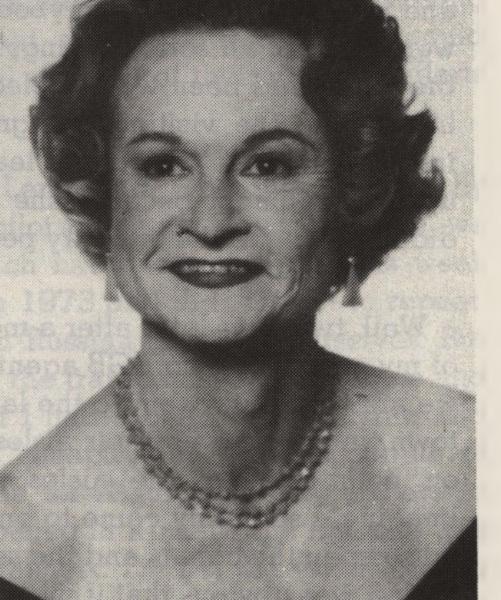
When the new year rolls around, all public universities will be re quired to provide on-campus access to abortion pills owing to a state mandate, but the Claremont Col leges have no intention to follow suit.
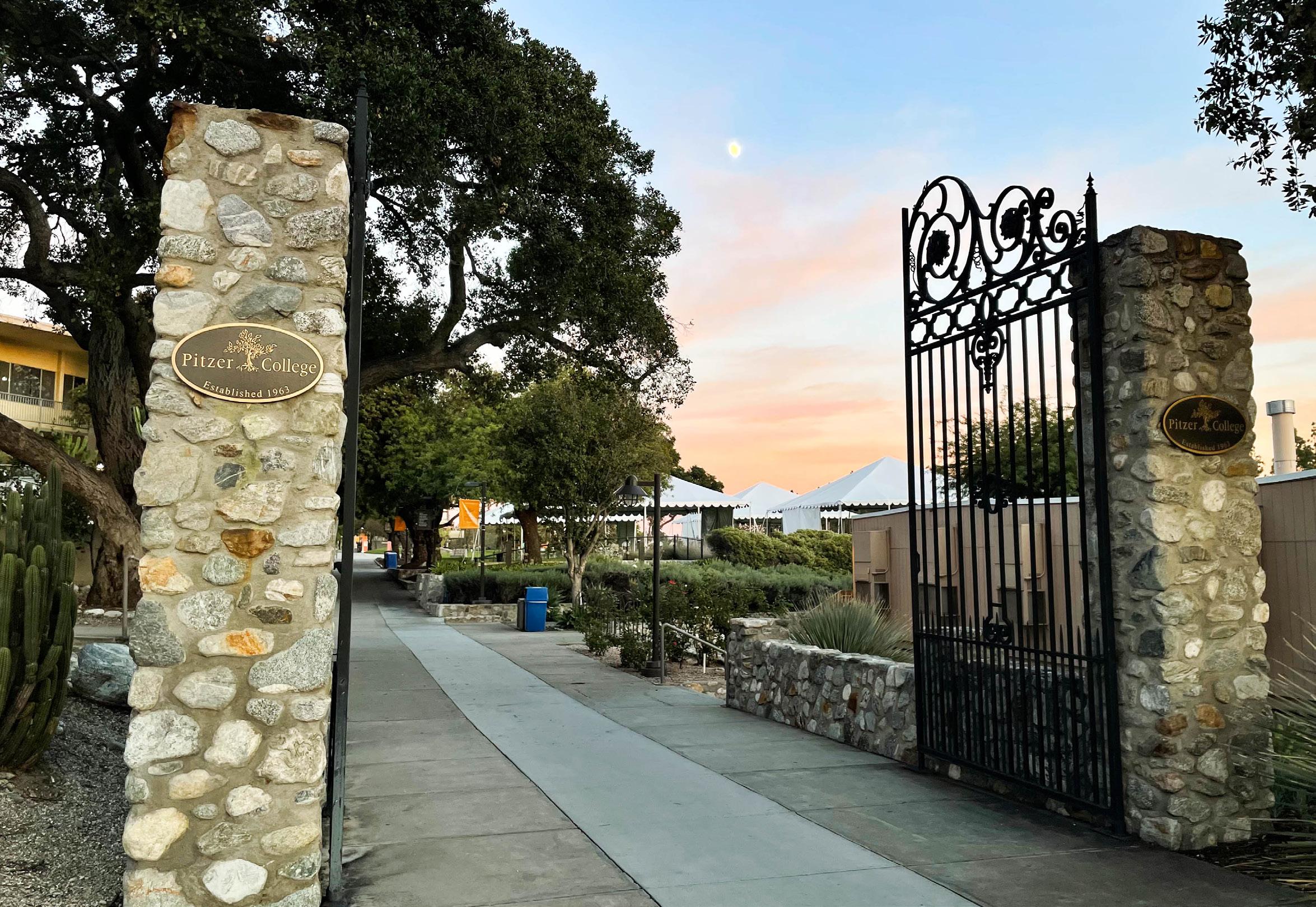
In January, the California Senate Bill 24, also known as the College Student Right to Access Act, will take effect across UC and CSU cam puses. Signed by Governor Gavin Newsom on Oct. 11, 2019, the bill will require student health services at public California universities to provide on-campus access to abor tion pills.
However, TCCS Assistant Vice President of Communications Laura Muna Landa told TSL that the 7Cs do not plan to implement the same changes.
“As a consortium of private col leges and universities, The Clare mont Colleges are not mandated by state law to offer on-campus medication abortion access,” Muna Landa said. “The Student Deans Committee, which has oversight for cross-institutional policies, has not
recommended a policy or prac tice change.”
California is the first state in the country to take this step.
“The state has an interest in ensuring that every pregnant person in California who wants to have an abortion can obtain access to that care as easily and as early in pregnancy as possi ble,” the bill states. “When preg nant young people decide that abortion is the best option for them, having early, accessible care can help them stay on track to achieve their educational and other aspirational life plans.”
In a medication abortion, two prescription pills are taken sever al hours apart to induce a miscar riage during the first 10 weeks of pregnancy. Abortion pills differ from morning-after pills such as Plan B, which prevents pregnan cy by delaying or stopping the release of an egg.
“As other states and the fed eral government go backward, restricting reproductive freedom, in California we are moving
the administration’s focus on “topdown messaging” instead of re viewing and addressing systemic problems as her major concern.
Over the summer, the TIX TF worked on developing action steps to increase accessibility for policies that the task force had shared with the Pitzer community in the spring. Bhattacharya worked with Pitzer economics professor Maya Fed erman to create a two-page quick reference guide for the internal Discrimination, Harassment and Sexual Misconduct (DHSM) policy and the 5Cs Title IX policy.
The guide aimed to make dense and long policies more widely ac cessible. Bhattacharya and Feder
man also identified “problematic errors” that were in need of cor rection on Pitzer’s Title IX web page.
After presenting her group’s recommendations and resourc es to Interim President Jill Klein, Bhattacharya said it became clear that Klein was not on the same page regarding the TIX TF’s on going work.
“We had intended the guides as a starting point for the real work of making systemic chang es — disappointingly, Interim President Klein appeared to feel that there was no more work to
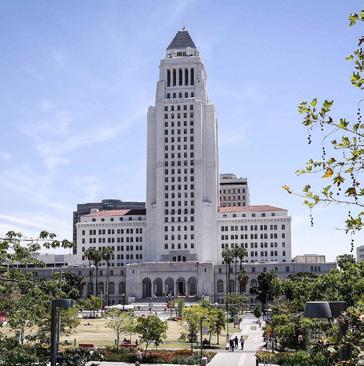
Celebrating queer histories and futures
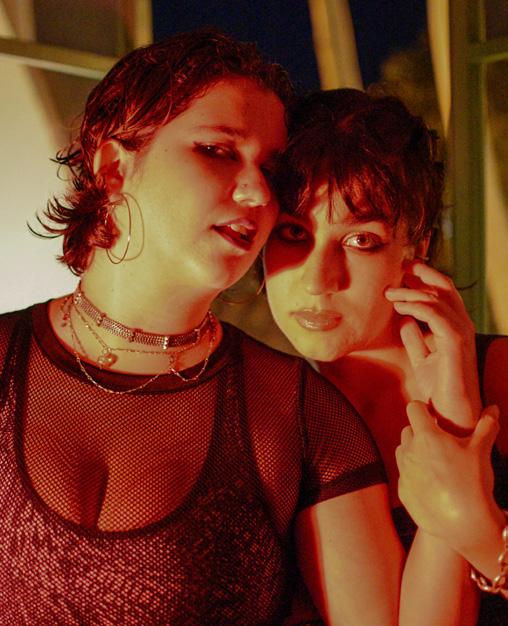
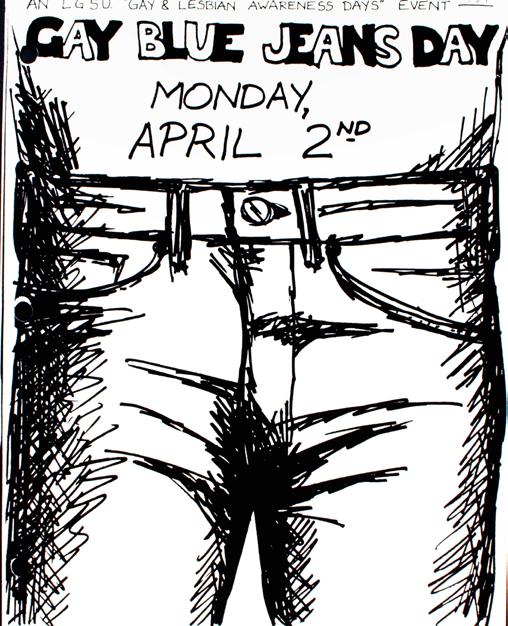
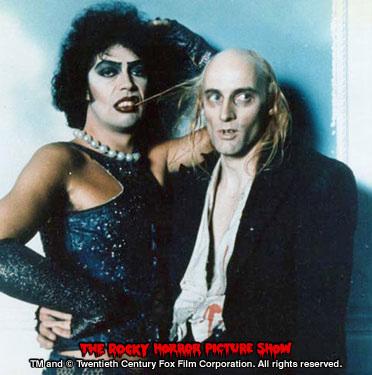
5C students with ties to China take risks to put up political posters
HANNAH FRASURE
Around the Claremont Col leges, anonymous posters criti cizing the Chinese government have gone up and down since mid-October, as some Chinese students on campus find them selves disillusioned with the trajectory of the Chinese govern ment, brought on by the govern ment’s zero-Covid policy.
The anti-Xi Jinping and an ti-Chinese Communist Party (CCP) Mandarin and English posters often disappear and re appear in the span of two days. They lack any indication of who is responsible for them, owing to safety concerns, which is a re quirement for any posters pasted around the 7Cs.
“Change is not necessarily coming from the outside, it’s coming from within,” one Chi nese student national at the 5Cs told TSL. “That’s what’s mon umental [about the protest at large].”
TSL talked to five students who are Chinese nationals or Chinese Americans with family
in China. All were granted ano nymity due to safety concerns.
The students requested ano nymity in fear that other students would report them, the Chinese government would punish them and their families could face con sequences.
Two Chinese students told TSL
that other 5C Chinese nationals put up the posters.
A CMC student from mainland China told TSL that a friend from Beijing tore down at least one poster because he thinks calling for gov ernmental reform is inappropriate,
CHINA on page 3
paved in
With P-P and CMS taking home six SCIAC titles in five of seven sports this fall, Claremont just laid witness to the 5Cs most dominant season in consortium history. Read more on page 12.

The student newspaper of the Claremont Colleges since 1889 INDEX: News 1 | Arts & Culture 4 | Special Projects 5 | Opinions 10 | Sports 12 FRIDAY, DecembeR 2, 2022 CLAREMONT, CA VOL. CXXXIV NO. 10 ARTS & CULTURE OPINIONS SPORTS PO HMC CMC PZ SC ** 0 25 20 15 10 5 Student Staff Undifferentiated +19 cases TSL COVID-19 Tracker covid.tsl.news from November 21 - 27 Scripps and HMC are no longer reporting COVID-19 data +7 ** Data from each of the 5Cs school’s testing dashboards at press time. Visit covid.tsl.news for the most up-to-date testing infomation and historical data ** HMC told TSL October 10 that the school will alert students if case numbers spike at the 5Cs +2 +6 +5 Over Halloween weekend this year, 5C students put on two nights of The Rocky Horror Picture Show; but there lies a large community for this cult-classic beyond the Claremont campuses. TSL spoke with the people who brought this energetic and inventive show into being. Read more on page 9. In a leaked audio recording, LA city council member and Pitzer alumnus Kevin de León PZ ’03 made egregiously racist remarks. Read more on page 10. UNITY TAmbeLLINI-SmITH • THe STUDeNT LIFe Who knew Sixth Street was
gold?
Pitzer college faculty integral to reviewing and revising the school’s Title IX procedures say they feel the school has failed to address students’ needs and significant concerns.
See
chinese students at the 5cs have joined an international protest movement against china’s zero-covid policy and beyond through continously and anonymously posting flyers around campus.
ABORTION on page 2
emmA JeNSeN • THe STUDeNT LIFe
CW: Sexual assault
ANNA SHObe • THe STUDeNT LIFe
See PITZER on page 2
See
SPECIAL ISSUE
PAGES 5-8
cOURTeSY: QRc
cOURTeSY: cORINA SILVeRSTeIN
cOURTeSY: UNIVeRSITY OF VIcTORIA SPecIAL cOLLecTIONS
Pomona grants swipe access to SOCA, halts plans to divide lounge amid student organizing
LI
REIA
After hundreds of students of color organized a series of meet ings and met with Pomona College President G. Gabrielle Starr during her office hours earlier this semes ter, administration confirmed they will not build a wall through the Students of Color Alliance (SOCA) Lounge for at least the rest of this academic year.
As of Thursday, students of col or can now request swipe access to the lounge.
“Previously, there was no stan dardized process for granting swipe access to the lounge,” SOCA wrote in an Instagram post Tuesday an nouncing the update. “Moving for ward, there will be a Google form that students of color can fill out to request swipe access to the space.”
Helen Hailu PO ’23, one of two SOCA Interns who maintain the lounge and organize events, said the form will be posted this week on SOCA’s Instagram and in the lounge, which is in the basement of Clark V. The form will also be sent to different groups that use the space, including Pomona’s Latinx Alliance (LXA) and Black Student Union (BSU). Once students input their name and student ID, they will receive swipe access within two weeks.
Dean of Students Avis Hinkson told TSL via email that swipe access to the SOCA Lounge was discon tinued during the COVID-19 shut down and remained restricted once students returned to campus due to COVID-related occupancy rules limiting the size of gatherings.
“Swipe access to the SOCA Lounge was not discontinued due to any of the recent space discus sions,” Hinkson said.
Hinkson referenced Pomona affinity groups’ efforts to prevent a plan to divide the SOCA Lounge to add space for the Black Student Union (BSU) after BSU’s temporary meeting space in the Smith Cam pus Center was partially convert ed into office space last October. In response, over 50 students walked into Starr’s office hours on Nov. 9

chanting “Stop the wall,” where they were met by Starr’s an nouncement that the wall would no longer be built.
In Starr’s Nov. 17 weekly up date to the Pomona College com munity, Starr officially announced that plans to build a wall would officially cease for this academic year.
“I appreciate that so many stu dents came to share their views and experiences,” Starr said. “Whenever any of us feel hurt in our community, it is a collective concern and we need to stop and hear the issue out. I’m sorry for that, and I extend my love and re spect to you all.”
SOCA interns were already in conversation with Associate Dean of Students Brandon Jackson about reinstating swipe access be fore the plan to divide the SOCA Lounge was proposed.
Now, Hailu said allowing in dividual students to have swipe access will show Pomona admin istration how many students ac tually use the lounge, potentially preventing an incident like this from happening again.
Hailu said Pomona’s adminis tration proposed a wall through the lounge partially because they didn’t have a record showing how many students used the space, which made it seem like it was used less than other student spac es on campus.
“I’ve attended [meetings in the SOCA Lounge] where there’s over 30 students that attend, and you can’t have that on record because only one or two [student leaders] are swiping into the space,” Hai lu said. “The logic of dividing the space came from, like, ‘It’s not be ing utilized as much as other spac es on campus.’”
Hailu said she hopes reinstat ing swipe access will allow more students, especially underclass men, to use the SOCA Lounge as a place to hang out and build community with other students of color.
“The original intent of the space is as a lounge, first and fore most,” she said. “It’s meant to be
for students of color to be able to come in and study, have movie nights, have a community, any thing like that.”
Although SOCA Lounge will not be divided this academic year, its future remains uncer tain. Pomona is in the process of searching for a consulting firm to conduct a “space study to de termine how we can best meet the diverse needs of student groups on the Pomona campus,” according to Hinkson.
As part of the original cam paign to prevent the wall, SOCA, BSU and LXA wrote a solidarity statement which includes a need for the space study to be com pleted by March 3, 2023. They also ask that information from the space study be made public and widely accessible.
Hailu says the space study, which is slated to be complet ed before next summer, is cru cial for preserving institutional memory in the fight for spaces for students of color on campus.
“A lot of us in these leader ship positions are seniors and are about to graduate,” Hailu said. “And we want to make sure that there is institutional mem ory that’s preserved so that the other students continue to keep doing [this] work.”
To the coalition of leaders for LXA, BSU and SOCA that or ganized students to protest the building of the wall, the fight is far from over. In a statement the coalition shared with TSL, lead ers thanked students for their support while protesting the wall.
“The conversation and fight to have our voices heard are far from over, especially when it comes to the matter of safe space for students of color on campus and overall transparency from the administration,” leaders said in the statement. “We knew that in the short amount of time we had before the end of this semes ter, the urgent matter of concern was to stop the wall that was going to be built over winter break.”
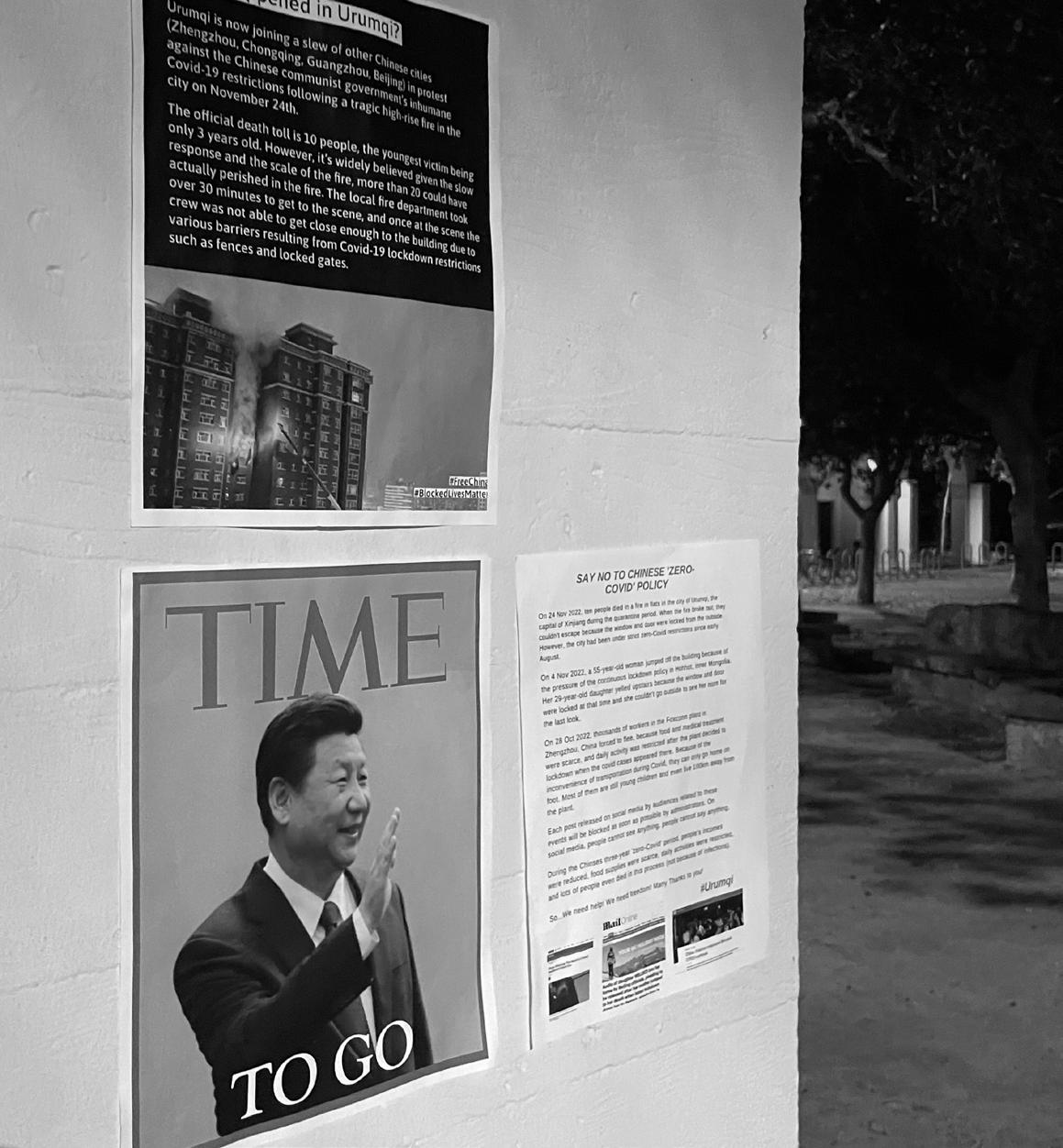
ABORTION: access
is ‘an issue of equity’
continued from page 1 forward, expanding access and reaffirming a woman’s right [to] choose,” Newsom said in a 2019 statement announcing the legis lation. “We’re removing barriers to reproductive health — increas ing access on college campuses.”
Accessibility seems to be the main factor driving the changes.
According to Carolyn O’Keefe, Director of Student Wellness & Basic Needs at the CSU Chancellor’s Office, health appointments at CSU campuses will be covered by student fees during the school year, with an additional $50 fee per student for the medication. At UC campus es, the pills will be covered by re quired student insurance plans.
Off-campus, medicated abor tions often cost up to $800, ac cording to Planned Parenthood.
At the Claremont Colleges, SHS refers students seeking abor tion services to outside clinics, although these aren’t completely covered by student insurance.
“Medication abortions pro vided through an outpatient fa cility are covered at 80 percent at in-network facilities,” Mu na-Landa told TSL.
The time and monetary cost of finding and traveling to off-campus abortion sites is of ten difficult for college students, according to Lily Dunkin SC ’24, one of the founders and organiz ers of the 5C Reproductive Jus tice Club.

“At its core, abortion access is fundamentally an issue of equity and control,” Dunkin said. “In the case of the Claremont Col leges, when you have a large por tion of the population that is able to get pregnant, for those stu dents to have to travel upwards of 40 minutes on public transit to the nearest abortion clinic that may not even be covered by their insurance is a really inexcusable burden.”
Dunkin’s reasoning echoes that of the Senate Bill.
“Students seeking early pregnancy termination … face prohibitively expensive travel, often without reliable means of
transportation, to a clinic that may require hours of travel from their campus … These financial and time burdens negatively impact academ ic performance and mental health,” the bill says.
Considering the benefits of offer ing access to this resource, Ella Prig ge PO ’25 said she is disappointed that SHS does not plan to follow the mandate.
“Not only would access to abor tion pills at SHS increase bodily au tonomy and limit barriers to repro ductive healthcare for students, but it would also show administration’s commitment to the health of and care for the student body,” Prigge said. “It could be an opportunity for the 5Cs to step up as private colleges — paving the way for other private CA schools to consider providing access to the pills as well.”
Despite the 5Cs’ decision to not pursue on-campus access to abor tion pills, the number of reproduc tive healthcare offerings at the 5Cs are increasing.
SHS offers PAP smears, STI screening testing, STI diagnostic testing, pregnancy testing, safe sex counseling, HIV PrEP, HIV PEP and emergency contraception.
Additionally, Scripps Associated Students recently approved fund ing for a wellness vending machine in the Scripps Student Union. The vending machine will sell Plan B, menstrual cups, pregnancy tests, lubrication and other wellness prod ucts.
Until that machine is imple mented, the only wellness vending machine at the 5Cs is in Walker Lounge’s second floor Wellness Room at Pomona College.
Although Dunkin feels optimis tic about the future of reproductive healthcare at the 5Cs, she hopes the colleges will follow public schools in increasing access to medicated abor tions.
“Access liberates and empow ers!” Dunkin said. “That’s why I couldn’t be more excited about the emergency contraceptive vending machine and why I hope that Clare mont Colleges will use UC and CSU as a template, not because it is ‘man dated’ but because providing cheap medical abortion access to students is the right thing to do.”
CHINA: Students fear others will report them for opposing political beliefs
though he does not support the ze ro-Covid policy.
Judy Augsburger, director of public relations at Harvey Mudd College, told TSL via email that the college removed at least one poster because it had been placed without approval, so it was in violation of Harvey Mudd’s policy. Spokespeo ple from the other 5Cs had not heard of the posters.
The posters were inspired by an Oct. 13 protest in Beijing, where a protester unfurled banners over a busy roadway underneath the Si tong Bridge, calling for reform, free dom from the zero-COVID policy lockdowns and the deposition of Xi. This protest catalyzed further online and offline protests across China.
Chinese citizens studying abroad are participating in this movement by putting up posters like those seen at the 5Cs at over 350 schools world wide.
China’s zero-COVID policy is one of the main grievances of the protest, all interviewees said.
Whenever a person tests positive, the government enforces sweeping lockdowns of areas as big as entire cities — sometimes for months on end — until no new cases are report ed.
To Pitzer College Professor Han zhang Liu, the nature of China’s COVID tracing policy, which uses location data from phones to indi cate whether a person needs to be quarantined when entering public buildings, is oppressive.
“We see some signs that point to there being a very high possibility that this [tracing strategy] is now be ing used for social control and might be here to stay,” Liu said.
Both Chinese and Chinese Amer
ican students spoke about the toll that the lockdown measures have on mental health.
“This extreme policy has made lives unliveable for Chinese peo ple,” one Mainland Chinese stu dent said. “… It is a giant fucking play for one person!”
Some Chinese nationals at the 5Cs do not want to be associated with the political opinions ex pressed by the posters, even if they oppose China’s zero-COVID poli cy, while others believe the two are intimately intertwined.
To the CMC student, the CCP is crucial for China’s stability and peace. They are also frustrated at the posters that mention human rights issues in China when they “have always existed” there in dependent of the current govern ment.
“Sometimes you have a price to pay for the greater good,” the stu dent said. “The values that people really cherish in China is the sense of community, that you’re sacrific ing individuals for the collective and that’s a value that the CCP is promoting … And something that the Chinese people have consent ed to.”
But a different Chinese national disagreed. Though they agree the CCP has improved the quality of life for many people in China, the price is unacceptable for them.
“If I sit in a class and learn about what ethnic cleansing is, but look the other way when it takes place in my home country, what kind of fucking cognitive dissonance is that?” they said. “… I know what a just form of government is, and I yearn for that.”
Professor Minxin Pei, who teaches Chinese politics at CMC, told TSL that students’ fears for
their safety, and that of their fam ilies, are legitimate.
“The Chinese government has many ways of punishing people who speak their minds,” he said.
Group chats for Chinese stu dents at the 5Cs contain little to no mention of any of the protests, according to the Chinese students, for fear that others would report them for dissident political beliefs.
“Once you talk about it pub licly and leave traces of it, people could use it against you,” the CMC student said. “There are a lot of
A different student said they were frustrated with China’s cen sorship as the history of its people will only be known due foreigners. One example of such is the widely watched 1989 Tiananmen Square protests.
“It is incredibly sad that much of our history has been document ed by outsiders from different countries,” they said. “They will
have painted over it with a foreign perspective.”
All students interviewed spoke about the nuance in supporting the poster movement, expressing frustration with people who equate criticism of the CCP with criticism of Chinese people.
Liu said she “constantly grap ples” with this as someone who is a strong critic of the regime. One way she does this is to expose students to opposing viewpoints in her classes.
The CMC student said that, although they disapprove of the harshness of the COVID policy, they worry about what would happen if it were removed, due to the low vaccination rate in China and the ineffectiveness of some Chinese vac cines.
“You only know that right now, [this] is the situation where you con trol COVID. But you don’t have a counterfactual,” they said.
Liu underscored the bravery of the students participating in the poster protest.
“Even when these students are thousands of miles away from Chi na, they are still worried… Just this mild thing, in the grand scheme of things — they’re just putting up fli ers — but even that could have a lot of potentially ruinous consequences on their lives,” she said. “So imagine if that is already the thing people are dealing with when they’re not in side China, think about the kind of dangers and threats people are faced with inside.”
Liu referred to a well-known Chinese analogy when discussing what could come out of the protests: a single spark can start a prairie fire.
“Maybe the hope is that if there are enough sparks all around, at some point it’ll catch fire,” she said.
PAGe 2 News DecembeR 2, 2022
cOURTeSY: JULIe Ye
Pomona’s SOcA lounge will not be divided by a wall, but will become generally accessible to students of color through swipe access.
continued
page 1
from
KATHeRINe TAN THe STUDeNT LIFe
As private institutions, the claremont colleges are not required to provide students with access to medication abortion, like public california universities will soon be required to do, nor does TCCS plan to do so of their own accord.
students here at the 5Cs whose parents are government officials, so they don’t participate in these events.”
Recent protests in opposition to chinese President Xi Jinping’s zero-covid policy escalated over the weekend, citing stringent lockdowns that prevented safe exits during an apartment fire in the Xinjiang region earlier this month.
LARKIN bARNARD-bAHN THe STUDeNT LIFe
A tale of two parties: Tensions rise between 5C event organizers following recent party shut downs
Following the shutdown of Scripps College’s Halloween party and Claremont McKenna College’s Monte Carlo party the weekend before, several 5C student govern ments have implemented new pol icies in response to safety concerns for upcoming 5C parties, such as Yule Ball and Snow Globe, which both take place this Saturday.
Hosted by ASPC’s Annual Committee, a subcommittee of the Events Committee, and the ASCMC respectively, both parties are taking place Dec. 3. Pomona College’s Yule Ball is open to the 4Cs excluding CMC, while Snowglobe is CMC-on ly with the exception that CMC stu dents may bring a plus-one from the 5Cs.
“Given that a large majority of incidents at Monte Carlo were by non-CMC students, this policy al lows ASCMC to ensure account ability and a commitment to safety from our own student body while welcoming members of the broader 5C community,” ASCMC president Josh Nagra CMC ’23 said in a state ment to TSL.
Some issues at the Halloween parties, and more recently at Po mona and Pitzer College’s joint Hoedown Throwdown, involved students storming fences surround ing the party vicinity along with the use of fraudulent wristbands. This party was similarly shut down early due to students from the oth er colleges attempting to sneak in, bringing in alcohol while disregard ing campus deans and security, the Pomona Events Committee (PEC)
said in a statement to TSL.
Nagra told CMC students in an Oct. 29 email regarding the Monte Carlo party fiasco that CMC par ties may be 1C plus-one guest in the future, although the policy was not yet formalized.
ASCMC said in a Nov. 27 email that PEC misinterpreted the poli cy as being enacted for the fore seeable future, resulting in the re striction of Yule Ball to a 4C party.
To resolve the situation, AS CMC’s Vice President of Student Activities, Chris LaRovere, and ASCMC’s President, Josh Nagra, said they reached out to ASPC to clarify the 5C party policies.
“Despite good faith attempts, conversations with PEC were not productive,” ASCMC said in its Nov. 27 statement to CMC students. “While we are disap pointed that our students will not be able to attend Yule Ball, we are excited at the opportunity to welcome students from the other 4Cs to CMC’s campus for Snow Globe.”
The policy of CMC-only plusone will continue to be applied to future ASCMC parties on a caseby-case basis, Nagra said.
“We will use data from AS CMC events to ensure student safety as we progress with pro gramming,” Nagra said to TSL. “As before, any attendance policy for future events is undecided and dependent on the safety outcomes of events like Snowglobe.”
In response, PEC said in a statement to TSL that, because Pomona students are unable to attend events at CMC paid for by
student fees, CMC students will likewise be unable to attend Po mona events.
“If CMC can commit to 5C par ties and inclusion of Pomona stu dents at their large events, we are able to include them at all of our events open to all of the colleges,” the PEC Annual Committee said to TSL. “It would be an unfair use of Pomona student fees to allow CMC students to take advantage of them without reciprocation.”
The PEC Annual Committee added that, if other colleges an nounce that their parties will be 1C or 1C plus a guest, similar ac tions will be taken.
One source of contention sur rounding party attendance is the use of wristbands to set safe ca pacities for 5C parties. CMC’s par ties this year were wristbanded, something that ASCMC and other student governments have used to ensure safe capacities at events for years, ASCMC said in the Nov. 27 statement.
“The alternative system of allowing students in until a set capacity is no different than wristbanding,” ASCMC said. “Wristbanding prevents the dis appointing situation in which students anticipating attending an event are refused access at the door, ensuring that students kept in line can enter the event.”
Despite Pomona events being free of charge and previously be ing open to 5C students, according to the Annual Committee, CMC requires fees to attend their par ties. Wristbands for Monte Carlo were not subsidized by ASPC,
with the Annual Committee citing their free-to-attend events.
“The idea of subsidization for an event like Monte Carlo is ridic ulous when the use of student fees is considered,” the PEC Annual Committee said to TSL. “This is why we find a problem with CMC requiring Pomona students to pay for an event; the events we throw are just as expensive as Monte Carlo or sometimes more expen sive.”
Citing the high demand that outweighed the limited number of wristbands provided to Pomo na students for CMC’s two 5C parties, PEC told TSL that wrist banding has created an exclusive atmosphere in an environment that is meant to be inclusive of all consortium students.
“We plan every party with the safety of our students in mind while also thinking about how we can expand capacity limits to en sure that everyone who wishes to attend is able to do so,” PEC Annu al Committee said. “Of course, we will always have capacity restric tions to ensure safety; not wrist banding events allows a greater number of people to attend given that even if people have to wait in a line to enter, they will eventually gain entry once people leave.”
At Scripps’ Halloween par ty, wristbands were used to set restrictions on the number of at tendees. However, counterfeit wristbands were abundant and even those with real wristbands were turned away, according to an email sent by Scripps’ Associ ated Students to Scripps students
on Nov. 9.
In their statement, SAS urged administration to provide students with more agency and trust in ex ecuting and attending events. SAS also announced their intent to com municate with administration in re solving these issues.
“Moving forward Student Af fairs will continue to partner with SAS alongside key departments to ensure 5C events are safe, inclusive and center community vibrancy,” Assistant Vice President for Student Affairs Adriana di Bartolo-Beck man said in an email to TSL.
As of Dec. 1, Scripps’ adminis tration has yet to address SAS’ con cerns but said they will get back to them, SAS president Megan Chow SC ’23 in an email to TSL.
Nagra told TSL that the exclu sion of CMC students from Yule Ball will not affect who is included in future parties at CMC.
“We are in communication with the other 4Cs and are encouraged by the solidarity we have been granted,” Nagra said. “Although we are disappointed by the policy, ASCMC will continue to value an inclusive, diverse and fun set of programming for CMCers and stu dents at the 5Cs.”
The PEC similarly emphasized their commitment to returning to a consortium-wide social scene.
“It is important to highlight that Pomona has been and will continue to be dedicated to 5C parties,” PEC Annual Committee said to TSL. “It is imperative that CMC and the other colleges remain the same in order to return to a vibrant social life across all colleges.”
PITZER: Professor cites ‘lack of urgency’
be done once those flowcharts were completed,” Bhattacharya said in the statement.
In separate statements to TSL, both Bhattacharya and Federman expressed concern for the adminis tration’s lack of action in improving Title IX processes, with Federman saying she “[does] not think there has been adequate urgency for mak ing improvements.”
Pitzer spokesperson Wendy Shattuck provided TSL with an up date via email on task force work through October 2022 based on TIX TF’s action steps. This work included creating and expanding counseling for survivors, as well as providing financial resources for off-campus counseling.
Pitzer is also working to find a Se nior Director of Office of DHSM, an upcoming on-campus position the college expects to fill by mid-spring semester 2023.
Despite Pitzer’s claim of working diligently with the task force to exe cute their recommendations, some involved in the TIX TF feel that their efforts have been neglected.
On Oct. 21, Bhattacharya and Federman spoke to the Faculty Ex ecutive Committee (FEC) about their work on the task force and their con cerns about the Pitzer administra tion, according to Bhattacharya. After the meeting, which Klein attended, the Interim President emailed Bhat tacharya and Federman.
“Your work related to further assessment of the College’s process
es related to Title IX and DHSM ceases,” Klein said in the email, citing Bhattacharya’s departure from the task force earlier that month.
Bhattacharya pushed back in her resignation letter.
“As faculty, we have the ac ademic freedom to continue as sessment of the College’s process es related to Title IX and DHSM should we choose to do so,” Bhat tacharya said.
Additionally, Bhattacharya said Klein reminded them of their responsibilities as manda tory reporters and accused her of potentially violating mandatory reporting obligations after her resignation from the task force.
Bhattacharya called the accu sation “nonsense” in her state ment to her colleagues, adding that she “feels that these gratu itous ‘reminders’ (threats?) about mandatory reporting obligations were intended to create a chilling effect.”
Klein did not address a direct question from TSL regarding Bhattacharya’s allegations.
In a statement to TSL, Alys sa-Rae McGinn, Pitzer’s Interim Title IX coordinator, said Pitzer worked diligently on the TIX TF’s recommendations.
“[TIX TF’s] work last year was integral to gathering the informa tion all of us in the administration of Title IX needed to work toward change, and then implementing measures to make that change,” McGinn said.
Corrections
In Issue 9, an article on the 5C Student Art Market at Pomona Col lege’s Benton Museum of Art incorrectly stated the event is in its third year. It has been corrected to say that the event, which is held semesterly, is in its second year and was held at the Loeb Family Art Pavilion, not Leah Family Art Pavillion. Additionally, the article did include the graduation year of Hannah Avalos PO ’22.
In Issue 9, an article on a recent Keck Center talk on the protests in Iran incorrectly spelled the last name of Josh Morganstein as “Mor genstein.” It has been updated to reflect the correct spelling.
TSL regrets these errors.
Despite less time on campus, 2021 reports show uptick in sexual misconduct cases
TW: sexual assault, violence
Instances of sexual violence at the Claremont Colleges were reported in 2021 at similar levels to previous years on campus de spite less time spent on campus, disclosures from the colleges showed this fall.
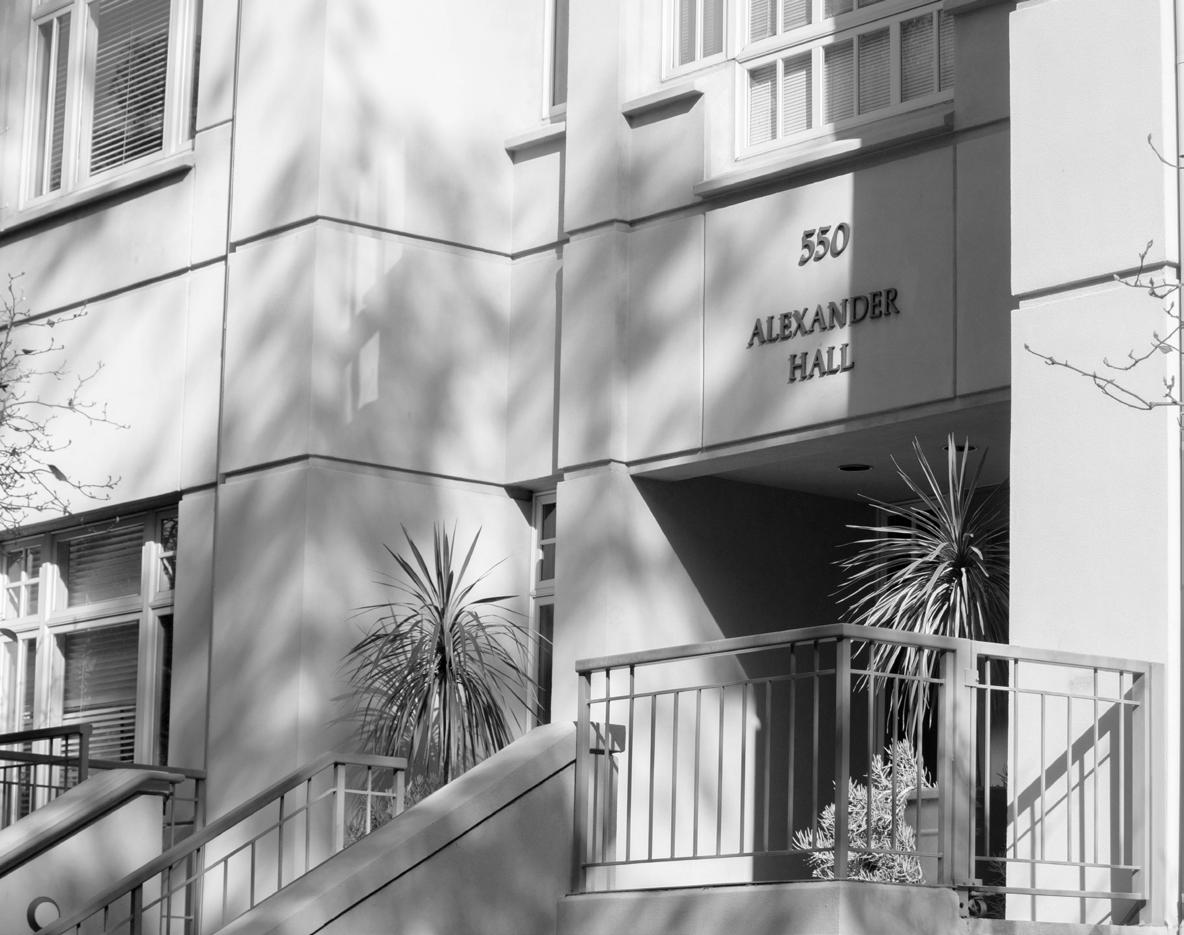
Clery reports are inde pendently released by each of the 7Cs every Oct. 1 to comply with the 1990 Student Right-To-Know and Campus Security Act. They contain data collected by Campus Safety about federally-designated crime categories, like sex offenses, violations of the Violence Against Women Act and burglary.
The data contained within the recently-released reports cover calendar year 2021, when students were only on campus during the fall semester due to the pandemic.
The disclosures reflect 21 re ported instances of rape in 2019. In 2021, there were 20 reported instances across the 5Cs despite students having spent only one semester on campus that year.
Pomona College experienced an increase in reported rape, with nine cases of rape reported in 2021 and five cases reported in 2019.
Erica Taylor, associate dean and Title IX coordinator at Po mona, told TSL via email that the increase was “in alignment with national trends across higher education reflecting a rise in stu dents reporting Title IX matters as we transitioned students back to living on campus.”
Title IX is the federal anti-dis crimination law which deter mines how colleges who receive government funding must re spond to instances of sexual vio lence on campus.
“Many attributed this to stu dents having access to the report ing resources they did not have during remote learning and two classes of students living on cam pus for the first time,” Taylor said.
Pandemic-related circumstanc es may have contributed to the in crease, Pomona Campus Advocate Lekha Admin PO ’23 said.
“There is a national increase in domestic violence and intimate partner violence during the pan demic … [and] this is something that has been tracked,” Amin said.
Pitzer College also experienced an uptick in reports, with six report ed cases of rape in 2021 compared to five in 2019. Pitzer’s Title IX Co ordinator Alyssa-Rae McGinn said the data may be in part related to last year’s series of public stories of instances of on campus sexual vi olence amid an outpouring of dis satisfaction with Pitzer’s previous coordinator.
“Some of these [shared ac counts] were known to the Title IX Office already, but some new reporting parties identified them selves to me as well,” McGinn said. “In addition, sometimes hear ing others’ stories can make one feel more empowered to report, and I received some reports from other students who wanted their accounts documented or wanted support. All of these new reports were accounted for in those 2021
numbers.”
McGinn added that, in the past couple of years, students have be come more aware of what healthy sexual relationships look like.
There is often a discrepancy be tween the cases that are reported and the actual occurrence of these crimes, she added.
“I think we’ve seen reporting generally increasing as societal awareness increases, and that is al ways going to make the numbers look higher.” McGinn said. “In the Title IX world, high numbers are of ten a good thing — it means survi vors are feeling empowered to speak up, and that has not been the case historically.”
Students have recently chal lenged 5C Title IX protocols, which Amin has called “re-traumatizing,” based on their efficacy in supporting survivors.
“I think it’s really great that [peo ple who reported] decided to share their story, but also for those who don’t decide to report, that does not mean anything about them — it does not mean that they were not strong enough,” Amin said.
Pitzer saw 15 reported rapes in 2018, the most in at least eight years.

DecembeR 2, 2022 PAGe 3 News
JOHN PAUL FERRANTINO
WeNDY ZHANG • THe STUDeNT LIFe
published in October, identified
violence from that of
continued from page 1
The Claremont Colleges’ 2021 Clery reports,
an increase in the number of crime reports involving sexual
2019. JAKE CHANG
beLLA PeTTeNGILL • THe STUDeNT LIFe
ASCMC has instituted a new policy around their parties in response to issues at parties earlier in the semester, to which ASPC responded with a new policy of their own.
‘Tangible sharing can go a long way’: The 5Zines club and the power of zine making
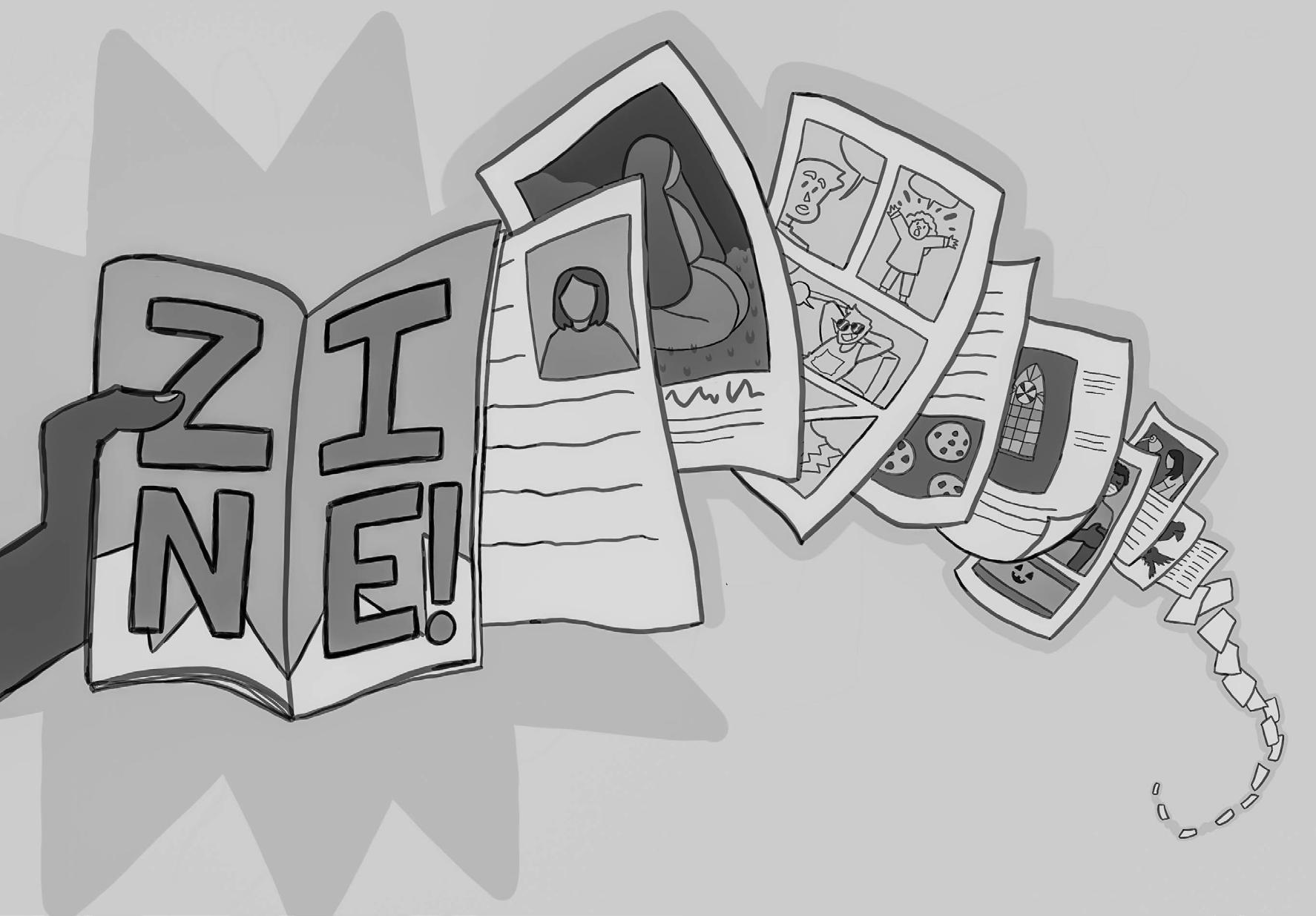
Shared through word of mouth and containing artistic and polit ical messaging, zines have been a part of a subcultural artistic revo lution since the 90s. A wordplay on “magazine,” zines are handmade, self-published booklets that can dis play poetry, art, prose or just pieces of information for people to ponder. A new club on campus is breathing life into this contemporary mode of communication and creative mes saging.
Alex Pedroza HM ’25 is one of the leaders of the new 5Zines club, which came into existence this year. Inspired by the zine collection at the Honnold-Mudd Library, Pedroza wanted a space exclusively dedicat ed to creating these booklets.
For many, the appeal of zines lies in their separation from a publish ing corporation and lack of intent to advertise products — just the desire to circulate something. 5Zines uses a fairly open-ended definition of zines to experiment within the me dium.
“We define it as anything that you want to materialize and put in booklet form,” Pedroza said. “It’s rooted in an idea that you want to communicate; I think we would classify that as a zine. And obvious ly definitions vary across locations and generational groups, and things like that.”
Ruby Peterman HM ’25 is the co-founder of 5Zines and enjoys how the club allows for artistic experimentation as a way to cool down and blow off steam.
“We wanted to create a space where students can take a step back from their schoolwork, and just cre
ate a space where that was avail able in providing art materials,” Peterman said.
Pedroza views zines as a unique mode of communication, art and community building. She was determined to start 5Zines with the goal of collaborating with other groups on campus that cre ate zines, such as KSPC and the Claremont Student Workers Alli ance (CSWA).
Zine-making can be used for personal enjoyment and artistic expression but also has the ability to complement grassroots politi cal organizing. Zines can present information about important orga nizing happening around campus, and CSWA distributed many zines that gave information about Po mona workers’ fight for fair wages.
Student organizers distributed zines as a way of starting a conver sation about the importance of an increase in pay for Pomona dining hall staff. Pedroza emphasized that the important part of zine dis tribution in this context is that it relies on interpersonal interaction to obtain a zine.
“For example, in the labor fight, getting information out about the strikes and workers’ demands at Pomona College was essential,” she said, “Distributing zines was super effective and a quick way to reach a wide base of students, es pecially a lot of people that are not involved in CSWA.”
In the 5Zines club, all the zines are handmade to maintain the ele ment of creativity and to encour age a more bespoke approach. They have looked to third-wave feminist and punk Riot Grrl sub culture zines as inspiration but
still encourage attendees of club meetings to come with an inven tive mindset.
“I made a zine about my up coming midterm where I wrote my notes in it,” Peterman said. “I made one about my late grand mother. I made a collage out of a bunch of faces I ripped out of an industrial workwear catalog. I just intuitively experiment with this type of art.”
The 5Zines hope to distrib ute more zines in the future, or to digitize them and add them to the library archives. They hope to
Student exhibition ‘Cayman Chen - Recent Collections’ critiques consumerism
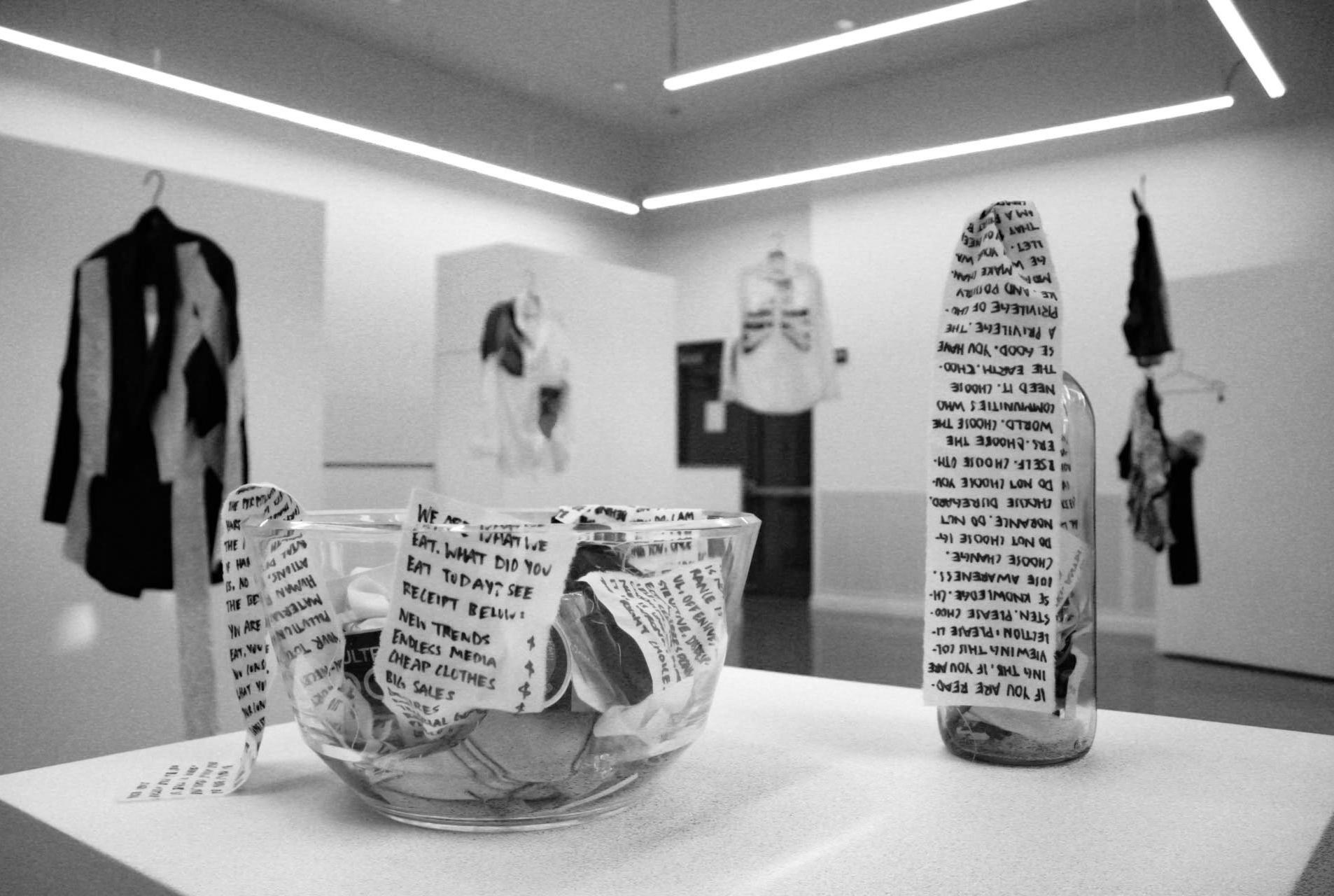
be able to contribute to this col lection of zines for future genera tions of students to discover and be inspired by. However, not all zines are for distribution purpos es; sometimes people come to the club meeting to make a zine that allows them to reflect on their per sonal identity.
“I think the power of zines can be kind of underestimated when there are all of these other tools that pervade nowadays, like on line marketing tactics, or just social media outreach. I think that the person-to-person level of a zine
THE bIbLIO-FILES
makes a difference, that tangible sharing can go a long way in reach ing people,” Pedroza said.
Right now, the club aims to pro vide a space for vulnerable and ar tistic collaboration. Their parame ters aren’t strict, and the mission of this club is to breathe life into this multifaceted tradition. The meet ings are structured so that attendees are able to meet new people and express on paper what matters to them.
You can keep up with the club meeting times on their Instagram, @the5zines.
Whimsy meets the macabre in ‘Beautiful Darkness’
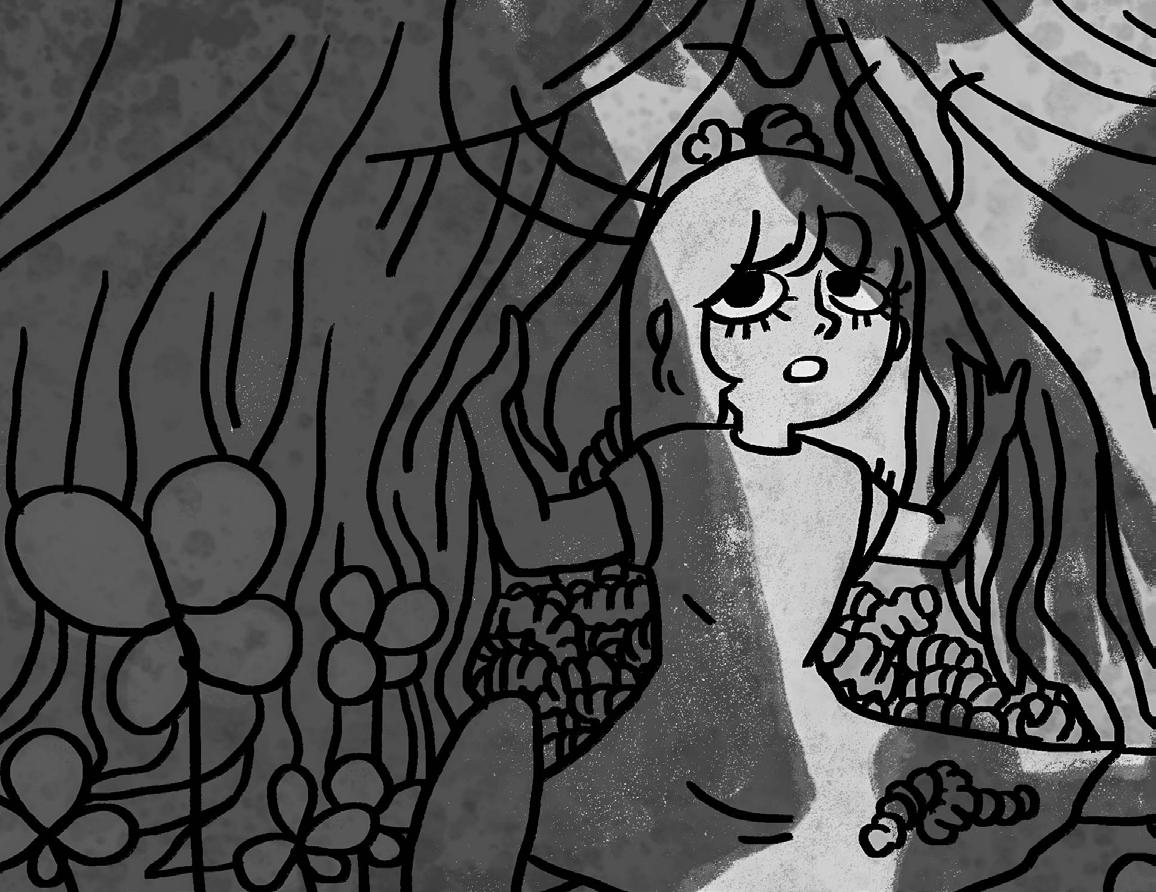 TOMI OYEDEJI-OLANIYAN
TOMI OYEDEJI-OLANIYAN
Imagine this. You open a beautiful, picturesque graphic novel; the cover details a small, pensive girl looking with won der into the big, open, green world. Even the title is written in a delightful loopy font, in stilling a sense of whimsy. You begin reading.
The premise seems simple: A girl lives among her people in what appears to be some kind of palace complete with tea parties and princes. However, the palace quickly starts to fall apart. With the pink ceilings melting and falling onto the floor, hysteria follows as our newly introduced characters try to find their way out. It is here that the graphic novel de livers its first turn. The palace that these characters live in is a young girl’s dead body, and it is starting to decompose.
illustrations with a progressively darkening plotline. After every big reveal that is made, the authors re fuse to linger on it for long. It is as though they are conveying that is simply the way things go in the big forest. We are left with many ques tions: Who are these tiny people? Who is the little girl in the forest and how did she die? However, the story refuses to give us any clear answers.
BELA DE JESÚS
The Sprague Art Gallery at Harvey Mudd College feels al most dystopian as fashion pieces hang from the ceiling. Seeming ly floating in mid air, Cayman Chen’s assortment of blazers, tops, skirts and more are full of texture, color and reflection. Words on the fabric resemble receipts. Skeletal and transparent material create a haunting effect.
The Exhibit is titled “Cayman Chen - Recent Collections.” Cay man Chen CM ’25 is showcasing her artwork at the Sprague Gal lery from Nov. 29 to Dec. 12. It features two of Chen’s collections that focus on sustainability in the fashion industry.
Chen is a sophomore at Cla remont McKenna College double majoring in Psychology and Art. She was born in California but grew up in Hong Kong, and she has always been interested in art.
“One year when I was eight or nine years old, my mom signed me up for a week-long fashion camp,” Chen said. “And that’s when I learned how to use a sew ing machine, and learned very, very basic skills.”
Since then, her artistic passion has been focused on fashion, al though she also does graphic de sign and has expressed interest in art installation, too. Chen learned much about fashion through You Tube videos, and said she is con tinuing to determine what her ex act style will be.
As she has continued her art journey she is especially grateful for Sprague Gallery.
“I think the Sprague Gallery is really great because they show student and faculty work, and because they create opportunities to share this stuff that are maybe not as common anywhere else on campus,” Chen said.
The first collection in the ex hibit is entitled, “We Are What We Eat” (2022). Chen said that the
first collection is “a criticism of modern consumerism and how people in today’s society engage with material consumption.”
The second collection is still in the works and is entitled “Fallen Leaves” (2022). This second collection comes from Chen’s travels to Singapore and Japan on a CMC fellowship.
“I basically went around and interviewed a lot of designers, artisans and brand owners who have experience with sustain ability and fashion,” Chen said. “And then based off of what I learned from that, and my expe riences, I created this collection.”
In order to promote sustain ability, Chen uses no new fabrics in these collections. Of course there were challenges in creating the collection, one of which was needing to buy other materials like thread.
“I think the biggest challenge for me as a student is just being able to create while being a full time student,” Chen said.
Julia Hong, arts director for the HMC department of Hu manities, Social Sciences and the Arts, was the curator for this exhibit. Her job is to work with students to showcase their work at the Sprague Gallery and cre ate a press release in order to contextualize the art and offer her own perspective.
“For each student I work with, I try to provide as much critical engagement and feed back on their artwork and state ment as possible as we work together toward the exhibition,” Hong said.
The process for this exhibit began over a year ago.
“I met Cayman Chen through a Claremont Colleges-wide open call I made for Sprague Gallery back in September 2021,” Hong said.
This gallery was postponed due to COVID-19, but was picked back up this past year.
Chen
Hong took inspiration for this exhibit from Nam June Paik’s “Room for Charlotte Moorman” (1993).
“As I spent more time with Cayman’s works, I realized that the exhibition design match es the works and unleashes the unthought potential of the works, which is the quality of a nonlinear time,” Hong said.
The exhibit features piec es hung from the ceiling by fishing line at different levels, allowing the viewer to see ev ery perspective of each piece. Against the minimalist, allwhite gallery, the staggered fashion pieces truly shine.
“The gallery carries a very distinct quality of a space that is lived. Through sliding glass doors, the gallery draws natu ral light and, when the doors are open for special events, air,” Hong said.
Hong believes the Sprague Gallery suits Chen’s art and themes very well.
“Cayman thinks much about interaction between the old and the new and between tradition and modernity, and I read her works to be about postmodern compossibility and change,” Hong said.
Chen will be hosting an opening night event tonight, Dec. 2, from 5 to 8 p.m. at the Sprague Gallery in which she will talk to her about her pro cess, inspirations and work.
“I really do hope that peo ple come in,” Chen said, “they read my artist statements, they get to learn about my research and see why I care so much about this topic.”
Learn more about the Sprague Gallery and arts at HMC at https://arts.hmc.edu/.
This is how “Beautiful Dark ness,” a graphic novel by Fa bien Vehlmann and Kerascoët begins. We are presented with a group of tiny people who’ve lost their home, the decaying corpse, and must now learn to survive in the big open forest. Without any previous expe rience in foraging for food or dealing with poisonous berries or insects, the story follows this population as we are tak en through the simultaneously lush and dangerous landscape. Although the forest presents many challenges, the novel dares to question whether the greatest horrors are to be found within human nature itself.
Nature provides a perfect backdrop for this deadly beauty. This association of beauty with terror has long been echoed in literature as far back as the Ro mantics who often spoke of the sublime in nature as something to be both feared and revered. We continue to see this rhetoric: that beauty in its purest form is uncanny, unnerving and ulti mately unnatural.
These are the feelings that “Beautiful Darkness” evokes by mixing such playful and quaint
The dissonance between the art style and the plot also left me with an inability to decide just how I felt about the novel once I was done. The story ends on a dark note, yet it is difficult to comprehend that, as our main character sits by the fire, toasty and warm in a woodsy cabin. It is difficult to consider that the story I’ve just complet ed has not been a cozy one at all but rather one that peers into the darkest recesses of our society. It is what made me recommend this tale to others because the emotion al dissonance is something worth exploring: the ability for us to feel multiple things at once -- to feel safe and cozy but also aware that something sinister lurks at the edges of our consciousness. It is something that I find perplexing and curious and ultimately is what lies at the base of all complex emo tions.
Just like the mysteries of the small people, the girl’s corpse and her killer, the book lets us linger with this question of emotional incongruity as well. The open-end edness of it all is the true crowning achievement of “Beautiful Dark ness”.
While I may have begun this novel in search of a fanciful and amusing story of little people ex ploring the wonders of the forest, I left with conflicting impressions of darkness and beauty. These twin flames reminded me of a quote from one of my favorite novels, “The Secret History:” “Beauty is terror. Whatever we find beautiful, we quiver before it.”
Oyedeji-Olaniyan CM ’23 is a dual neuroscience and literature ma jor. If you need her, say her name in the mirror three times, and legend says she will appear to give you the perfect book recommendation.
PAGE 4 dEcEmbEr 2, 2022 Arts & Culture
Tomi
then worked with Hong to present the topic of sustain ability in fashion and Chen’s artwork properly.
KHYLAH PUGH • THE STUdENT LIFE
SASHA mATTHEWS • THE STUdENT LIFE
LILA GAMBLE
cLArE mArTIN • THE STUdENT LIFE
cayman chen cm ’25 transformed clothing pieces to create her exhibition at the Sprague Art Gallery.
This semester, TSL revived its Special Projects desk, a section specifically dedicated to covering underrepresented aspects of our campuses’ history. We started this project with the inten tion of finishing it before the end of October, in time for Queer History month. But soon into our research, we realized that the history of queer culture on this campus filled with brimming joy, unspeakable hardships and untamed messiness. Our work had only just begun.
We dug through TSL volumes from the 1950s to the 2000s, focusing our efforts on years that we knew marked historical steps forward in the creation of a queer community at the 5Cs — e.g. the formation of the Gay Student Union (GSU) in the 1970s, the creation of the Pink Triangles in 1986 and the open ing of “The Closet” in 1993. We spent hours with our heads buried in the Honold Mudd archives, but have almost nothing to show for it.
Throughout this production process, queer incompatibility with the Claremont Colleges, and more broadly, hegemonic in stitutions, has been a dominating, recurring theme.
As an institution, TSL must concede that its documenta tion of queer issues on campus was historically neglected. As we sifted through the pages of old volumes searching for any positive coverage on queer culture, we were disheartened (al though not surprised) to only find stories of hate incidents and protests. Some of this absence is reflective of the queer experi ence: Most of the meaningfully documented history we were able to gather came from a careful combing of the margins.
The Queer Resource Center’s unofficially archived binders of student event flyers, alumni surveys, anecdotes and staff logs illuminated the stories we are telling today. We recognized that printing a holistic representation of queer lives at the 5Cs — names and photos included — would jeopardize the safety of those who lived them. We were diligent to honor the privacy of students who openly celebrated their identity in a pre-inter net context. We specifically omitted publications like OutSpo ken, as well as photos of a drag ball LGSU threw. We encourage you to experience them — in their entirety — for yourself at the QRC and the Claremont Colleges Special Collections.
A (graphic) sapphic sex poem. A still of a drag queen danc ing on top of a table. A scathing critique of “Ellen,” before the show was popular. The truth of the matter is that this is largely a history of queer young adults, who had not even the slightest clue of what they were doing. They were a perfectly disjointed community of misfits creating community the only way they knew how. There were large swaths of time where most queer students would not even call the on-campus LGBTQIA+ popu lation a community — and yet we were here all the same.
The documented history we do have tells the tale of an often underground and resilient lineage of queer students. Stepping into the archives, admiring student posters, alumni surveys, poems, etc., we saw queer life documented by the people who lived it, largely because no one else cared to do it. Queer life was not simply a bulleted timeline of clubs and homophobic in cidents. It was LGBSU themed dances, first crushes, infighting and reconciliations between lesbian and gay student groups, heartbreak, resistance, unfettered self-creation and so much more.
Recently, TSL published an op-ed about the lack of insti tutional support for CMC’s queer students, and the writer re ceived intense, hateful backlash over Instagram. It is obvious and reductive to assert that homophobia still exists — we know this. But it’s how we support each other as a community that speaks to who we are as the 5Cs today.
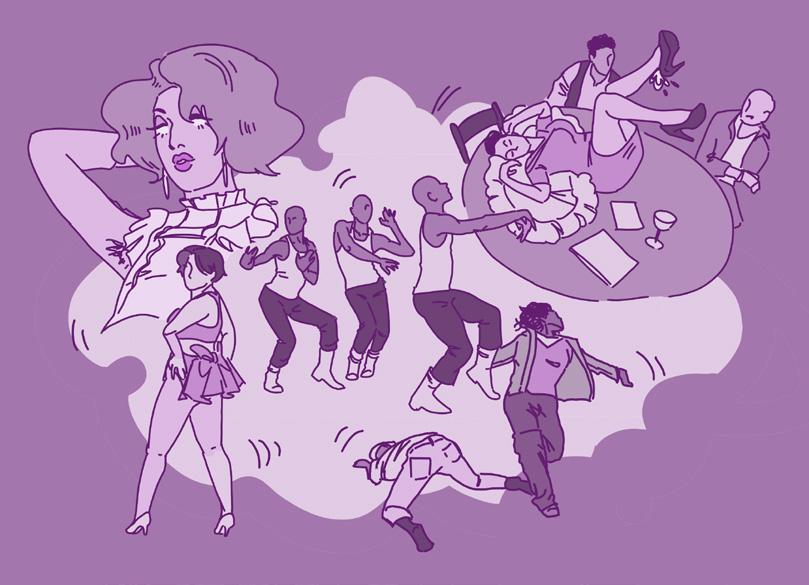
As queer students ourselves, working with this history forced us to confront a sense of absence on campus. Queer cul ture is a widespread but faint pulse — the result of a detach ment from the history which unites us in the first place. As you interact with the histories, posters and artifacts we’ve curated for you, we ask you to reflect on this sentiment and the other wwfeelings that they elicit.
With love, Ava, Cassidy, Kayla, Jenna
How two Pomona alumnae shaped transgender identity
AVA FRANCIS-HALL
Barbara Ann Richards knew she was a woman long before she stepped into a Los Ange les courthouse to convince the world of her sex change. On July 2, 1941, Richards was met by the scrutiny of a superior court look ing for her to explain what was, in their eyes, the unexplainable. How does a man suddenly be come a woman?
Richards’ answer: unstoppa ble and irrevocable biological changes.
“I began to observe that my skin had become smoother, that the shape of my face was differ ent, my waist was smaller, my hips heavier, my throat smaller,” Richards stated. The beard she had once proudly sported had stopped growing. Her voice had changed pitch. She became “in creasingly fond of cooking and housework.”
Unwilling to understand Richards’ transition as anything beyond a biological anomaly, the media sensationalized her story for a fascinated public. Headlines presented Richards as a “caprice of nature” and a person who had gone through a “strange metamorphosis.” She caught the interest of the Univer sity of California, San Francisco psychiatric department, and was soon invited to speak about her transition at a conference.
As Richards was introduced at the conference, one academ ic sitting in the crowd “deeply blushed” and became “very nervous.” Virginia Prince PO ’35 found Richards uncannily relat able. The two were of a similar age. They shared an early affin ity for cross dressing. They had both been in the same first year class at the same small liberal arts school in Southern Califor nia — Pomona College.
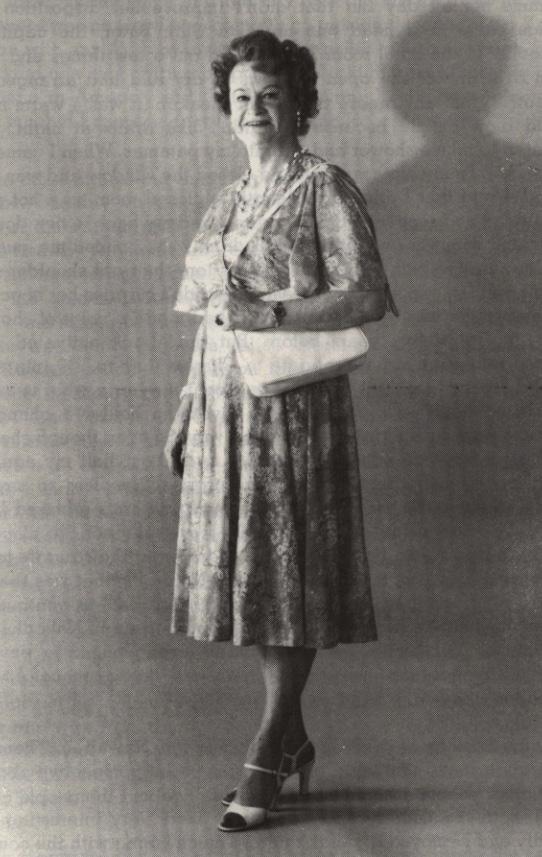
She sat staring at Richards, who only attended Pomona her first year, with incredulity. How had their “transvestic history” been so similar, but Virginia was the one sitting in the crowd while Richards was the subject of the conference?
Prince would not stay out of the spotlight for long, however. Although not much is known about her time at Pomona, her later work would be referenced for decades to come. The largerthan-life-figure would leave a complicated legacy for the trans gender community as co-found er and editor of Transvestia mag azine from 1960 through 1980.
Pomona history professor Gary Kates had the opportu nity to meet Prince in the early 1990s when he was writing a book about Chevalier d’Eon, an 18th-century French diplomat who began living as a woman at age 49. Klein felt that Prince was a kind of reincarnation of d’Eon, and he was not alone in that be lief.
“[Prince] felt that way too. We met and, and shook hands, and we sat down, and she said to me,
‘What can you possibly tell me about d’Eon that I don’t already know?’” Klein said.

The project that would soon become the famed magazine Transvestia began in a ramshackle house in Long Beach, affectionate ly known as Johnny’s Place. In the early 1950s, the house became well known among transgender and cross dressing communities as a safe space for open expression and of gender identity. Eventually, the idea of a newsletter was floated to stay in touch with transgender ac quaintances of Johnny and others. Prince knew exactly what to call it: Transvestia.
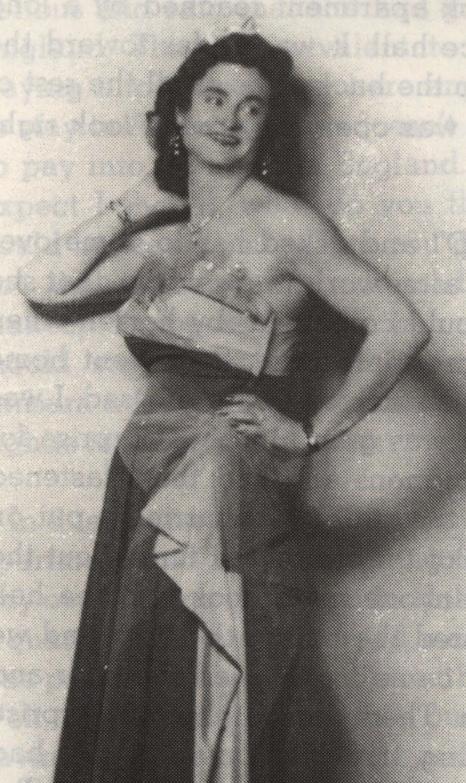
In 1952, contacts across the country received a promotional message about Transvestia and a subsequent request of a five dollar donation. However, the handful of five dollar donations soon ran out after two issues were published and the first version of Transvestia met its end.
A couple of years later, Prince would get in touch with radio station executive Barbara Elin and formulate a new, profitably sustainable version of Transves tia. The first issue appeared in January 1960 under Chevalier Publications, a Los Angeles-based publisher founded by Prince. The magazine would continue to be edited by Prince until her depar ture in 1980, when Carol Beecroft would take over the editor posi tion.
Readers could expect anything from fashion tips to life advice between the pages of Transvestia. Their own experiences and strug gles with identity and gender were reflected in the personal narratives and fictional stories published in the magazine. Transvestia re minded readers that though they face discrimination in their per sonal lives, there was a network of transgender individuals who cele brated their chosen identity.
However, for Prince, that sense of acceptance would not apply to transgender individuals who opt ed for gender affirming surgeries or to those who were sexually involved with those of the same
sex. Prince held these prejudices when she created the heterosexu al-only crossdressing organization Hose and Heels Club in 1961,which would later be known as Alpha Chapter of the Foundation for Full Personality Expression, and later Society for the Second Self (Tri Ess or Tri Sigma) in 1975.
At the time, Prince was of the be lief that gender and sexuality were two completely different entities, and one did not imply anything about the other. In the cross-dress ing community, Prince belonged to a faction who believed that gender affirming surgery was not neces sary, with some even considering surgery as a mutilation of the body. She considered herself a transgen derist — someone who lived en tirely as a woman without gender affirming surgery. The subjects and audience of Transvestia were re ferred to as “transvestites” or “TV” for short in the pages of the maga zine.
Some years after Prince stepped away from the editor role of Trans vestia, she relocated to the Clare mont area in the last period of her life.
As for Barbara Ann Richards, she was able to resume her life outside of the public eye once the sensationalism of her transforma tion wore off. At the very top of her list of priorities was remarrying the love of her life, Richard Wilcox.
Wilcox and Richards connect ed in 1940 as many couples in the throes of a blossoming romance do: in a quiet, secluded corner of an overwhelming party. After dis cussing their own gender identities — with neither having transitioned at the time, Wilcox was perceived as a woman and Richards as a man — the two decided they were meant to be together. They formally wed in November 1940. Less than a year later, Richards’ mission to have her new name legally recognized would commence.
The two now lie together in For est Lawn Memorial Park, leaving a legacy unrecognized by many but felt by all who have won legal rec ognition of their preferred gender and name.
From informal space to permanent place: Looking back at the QRC’s evolution
Based on letters, surveys and notes in the archives of the Queer Resource Center (QRC), we know that the queer community at the Claremont Colleges was relatively underground until the early 1970s when a group of students began meeting at Monsour Counseling Center.
They called themselves the Gay Student Union (GSU). Their meet ings were discussion-based, but they eventually started organizing social events. Sometime between 1981 and 1982, the GSU changed its name to the Lesbian and Gay Student Union (LGSU) in response to protests from lesbian students.
In 1983, there were mixed gen der LGSU meetings as well as sep arate meetings of the LSU and GSU. An undated poster tells us that the women’s meeting was held in Wil bur Hall at Scripps College and the men’s meeting in the McAllister Center. In 1984, LSU began hold ing their meetings in the Women’s Union in Walker Lounge at Pomona.
Also in 1983, LGSU wrote and self-published the Lavender Let ters, a weekly newsletter circulat ed to the queer community about “activities and general goings-on of the LGSU.” They advertised study breaks, student-faculty mixers, awareness events and more.
In the fall of 1985, a group of Scripps College students founded the Pink Triangles, which aimed to be more political than LGSU and was primarily for lesbian and bi sexual students. A flyer from 1987 reads, “So we can meet each oth er and know we are not alone, but have a thriving, loving community in Claremont.” Another flyer says, “An open meeting will be held this week at Jan’s — that’s Dorsey 201,” showing how tight-knit the commu nity was.
LGSU and the Pink Triangles sometimes collaborated to throw events at Scripps’ Motley Cafe, such
as a “Dance to your heart’s con tent” Valentine’s Day party and a “B-GLAD Week” dance in 1990 where the $2 entry fees went to the Foothill AIDS Project.
Social events like these were a great way to bring the queer com munity together, as were the week ly meetings, but the LGSU wanted a officially designated, institution ally-recognized center — and so they proposed it.
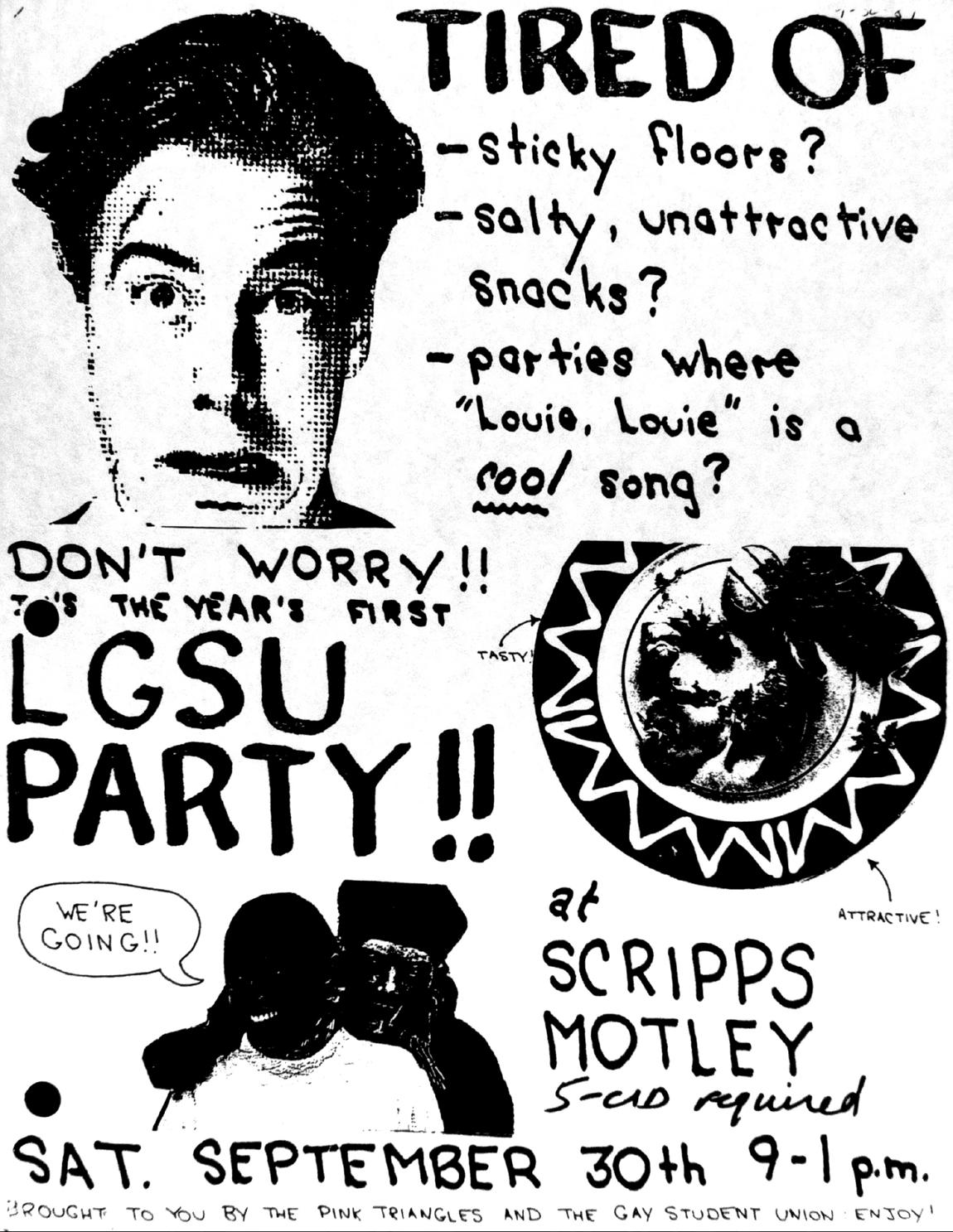
On March 24, 1993, the Lesbi an, Gay, Bisexual Resource Cen ter (LGBRC), affectionately called “The Closet,” opened in upstairs Walker Lounge at Pomona Col lege. It had a student board and a steering committee made up of faculty and staff from the 5Cs.
A few years later, in Octo ber 1995, the LGBRC officially changed its name to the Queer Re source Center (QRC).
In 1998, the first and only six-college queer student-faculty publication, OutSpoken, went to print. Containing photos, prose, poems and academic writing on queer subjects, the four existing editions of this magazine provide an unparalleled and intimate look into queer life at the 5Cs from 199899. Copies are available at Hon nold-Mudd Special Collections.
In 2001, the QRC created the Queer, Questioning and Allied Mentor Program (QQAMP), a program that paired mentors and mentees to provide support and guidance on queer-related issues.
Because of the significant increase of activity in the QRC, Pomona College created a Graduate Assis tant (GA) position in 2002.
In 2006, the QRC moved to its present location in Walton Commons at Pomona College, but there’s no surviving record of where the decision came from. The same year, Adriana di Barto lo-Beckman, who is currently the assistant vice president for student affairs at Scripps, was hired as the
GA.
She remembers that, at the time, the QRC shared a wall with the dining hall for the Pomona Lawry Towers residence hall, and that there was a targeted incident that went unaddressed by admin istration.
“Somebody set off a fire extin guisher … but because it was set off in the kitchen and the QRC, it wasn’t seen as the same as a hate crime. At that time, the students that were part of the space paint ed that wall rainbow,” di Barto
lo-Beckman said.
In the fall 2009, di Bartolo-Beck man became the QRC’s half-time coordinator, and in the spring of 2010, the student deans of the Cla remont Colleges agreed to pilot a full-time coordinator position for the 2010–2011 year.
In spring 2011, the President’s Council of The Claremont Colleges agreed to expand the existing QRC into the formally funded 7C center it is today. This monumental deci sion provided funding for general programming as well as two full-
time positions — QRC Director, at that point di Bartolo-Beckman, and QRC Program Coordinator.
“I think there’s really some thing to be said about institutional ly-backed spaces. Where the money goes is where the value is. So when the colleges made the decision to back an LGBTQ center, it was saying ‘our students exist, and they need expertise and support,’” di Barto lo-Beckman said.
In 2014, the QRC created Lead ership and Engagement in Gender and Sexuality (LEGS), a mentor program that connects 7C students with local LGBTQIA+ high school students in collaboration with the 7Cs’ Draper Center for Communi ty Partnerships. Mauricio Navarro PO ’14 wrote the original proposal for the program, which explained, “There currently exists a lack of in stitutionalized venues for college and high school students in the In land Empire to build community around gender and sexual identity.”
Youssef El Mosalami PO ‘24, who has been a LEGS mentor since their second year at Pomona, said they see much of their younger self in their high school mentees and expressed gratitude for the chance to be the “queer elder” they lacked while growing up.
“Being a mentor has given me an ability to heal my inner child, but also recognize the amount of work that’s still needed to be done,” El Mosalami said.
In the last decade, the structure of the QRC has remained the same, and this settled presence at the 5Cs has helped many incoming students feel welcome and supported. The rich history of LGSU and the Pink Triangles has dissolved and dissem inated into modern student groups like PRISM, QTs Alliance, FAMILY and SAGA.
Following the departure of for mer Director Sharon Chia Claros over the summer, the QRC an nounced that Bri Sérráno will lead the QRC beginning Dec. 12.
December 2, 2022 PAGe 5 Special p roject S
Qrc
cOUrTeSY:
KAYLA ALCORCHA
cOUrTeSY: UNIVerSITY OF VIcTOrIA SPecIAL cOLLecTIONS Virginia Prince PO ’35 and Barbara Ann Richards are historic figures in the trans community.
LUcIA mArQUeZ-UPPmAN • THe STUDeNT LIFe
An undated flyer advertising a LGSU/Pink Triangles event.
LGSU’s Lavender Letters to the queer community
CW: Mentions of homophobic violence
While he was head of the Lesbian and Gay Student Union (LGSU), Paul Wadler PO ’82 start ed an underground system to create a queer community at the Claremont Colleges where almost none existed.
“We didn’t have any way to communicate, and I interned in the ad missions office,” Wadler said. “[I] kind of typed out a newsletter and put it in sealed envelopes … And that was it. That was the Lavender Letter.”


The Lavender Letters, were a method of com munication between queer students and faculty, most of whom were closeted at the time. Wadley drew inspiration from the Pomona Chirps Newsletter, a weekly note to students detailing relevant ac tivities and opportunities.
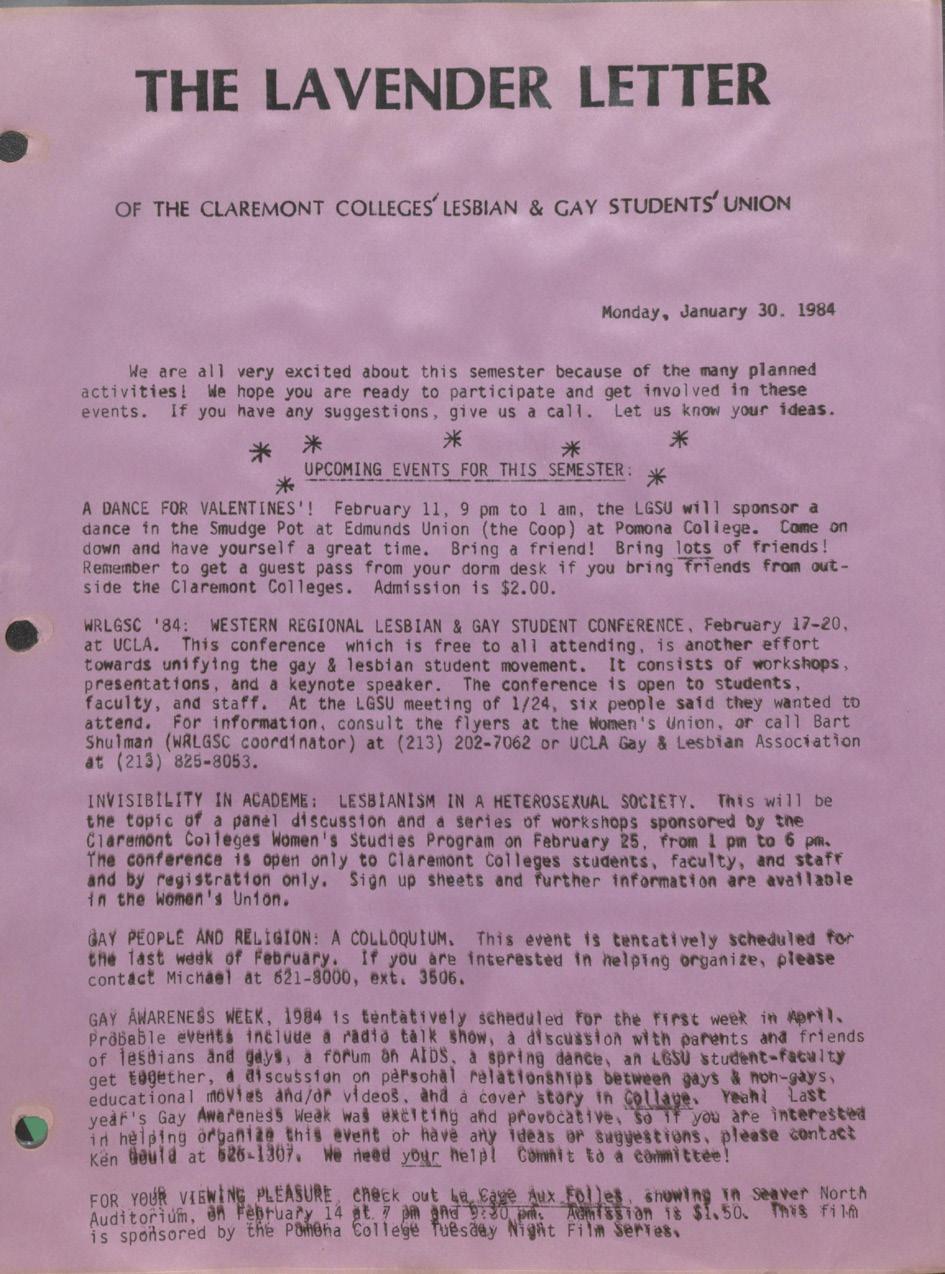
Printed on lilac-colored paper, the letters were also a nod to the associations that the color has had with queerness across history. This thread can be traced as far back as Sappho, but most recent in Wadler’s lifetime was the rec lamation of the color as a symbol of resistance and empowerment during the LGBTQIA+ civil rights movement in the late 1960s.
Wadley’s Lavender Letters brought this sentiment to the 5Cs, and even for years after he graduated it remained a weekly tradition. New LGSU leadership meant new authors, and they took care to emphasize the group’s non-hierarchical and communi ty-centered structure when asking for input on organi zational activities.
“The Lavender Letter, as the main source of information concern ing the activities of the LGSU, will try to provide the members of the Claremont gay community with announcements and information on the activi ties and general goings-on of the LGSU,” one of the issues reads.
Hoping to draw people out and into the community, the letters were written in a friendly and informal voice, addressing readers with en dearing jingles and closing out the note with a comic.
“HEY THERE, HI THERE, HO THERE,” a letter from January 1985 begins. The body of the letter, sprinkled with handwritten edits, announced that a meeting time consensus had been reached after many polls. The letters served as a fun way for the community to share both the mundane and ex traordinary events, from Valen tine’s Day parties to excursions to Big Bear.
Most of the letters followed this format: goofy notes with
task-focused points. At other times, however, this fun writing style was put aside to address heavier topics.
After a homophobic, stu dent-written “Letters to the Edi tors” was printed in TSL and The Collage, another student newspa per at the time, LGSU used that week’s edition of the Lavender Letters to address the situation.
“We need to acknowledge and reflect upon the oppression, if we feel it as such, and then we must decide whether or not to do something,” an issue from April 19,1983 reads. “We need to re spond as a group and as individu als not with ambivalence, but with patience and pride.”
Homophobia was not uncom mon on campus, making the Lav ender Letters even more of a ne cessity at the time. Wadley recalls that the letters, and other LGSU flyers, were frequently pulled down from bulletin boards.

“It was a different time. We didn’t have support or the admin istration or anything,” Wadley said. “Now it’s kind of understood that the school is pro-feminist, pro-egalitatian and anti-racist — and that wasn’t true back then.”
Wadley was one of the few openly gay men on campus, and this visibility was met with acts of oppression and violence, going as far as to break into his room at night.
“I would come home to nasty messages on my door. I mean that
was kind of just the way it was. People would come in my room while I was sleeping and flip my bed over,” Wadley said.
According to Wadley, faculty members were also outwardly homophobic. Fred Sontag, an es teemed philosophy professor at Pomona who is the namesake for several Pomona facilities, was one of the most notorious.
“He was this really sexist, homophobic guy,” Wadley said. “He would write letters to The Student Life opposing our ideas, saying that homosexual orientation is unnatural; that sex is obviously for reproduction, and non-reproductive sex is goes against nature.”
Such blatant homophobia mobilized young people into student organizing. Wadley recalled that homophobic local politics inspired many students to get involved in polit ical advocacy. Wadley also gave nod to the “robust feminist com munity,” who were largely gay themselves, that took him under their wings as a student.
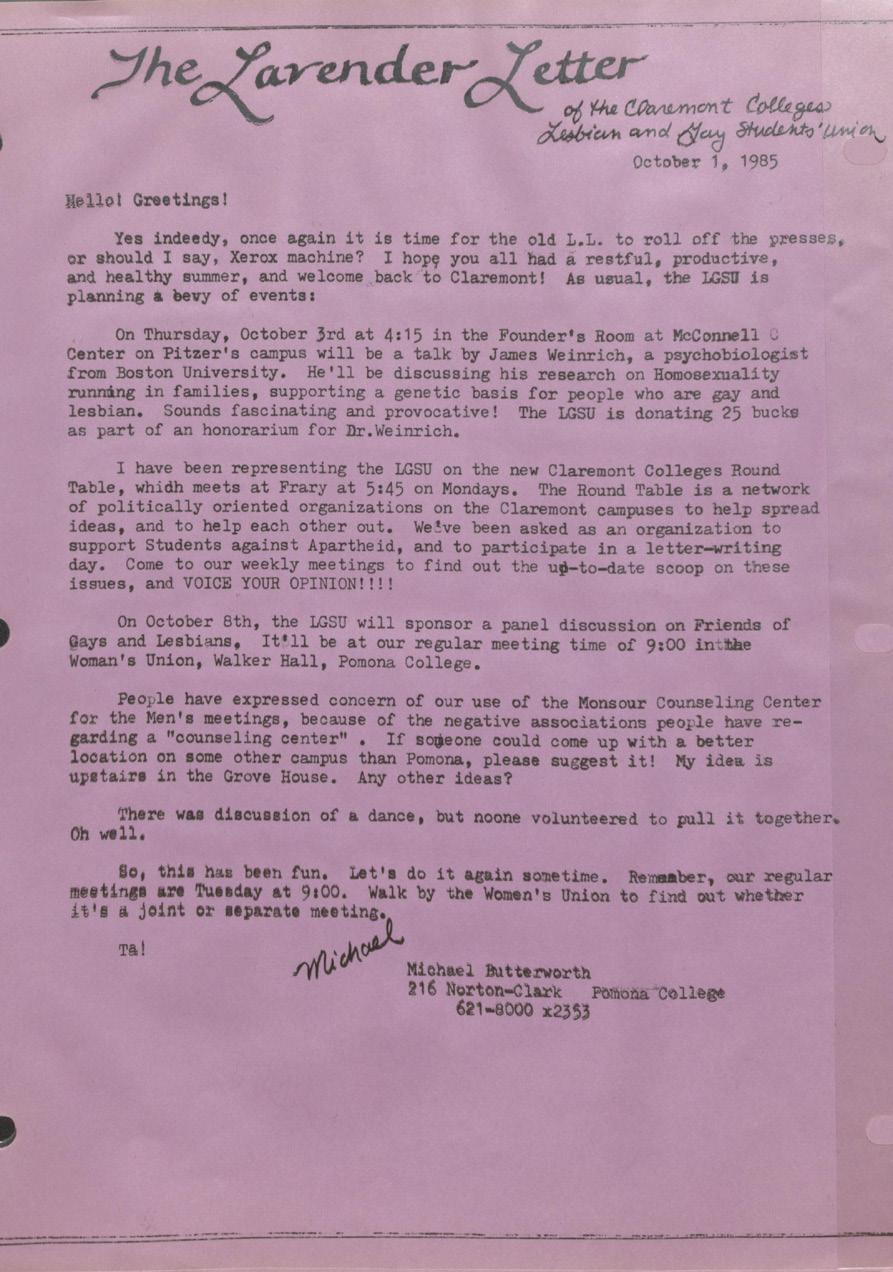
Channeling his hopes for stu dent activism, Wadley began communicating with other stu dent groups. He recalled an event in which all the student leaders in Southern California came togeth er for a conference in San Deigo, and he maintained contact with queer student unions at UCLA and UC San Diego.
“That time was an interesting time,” Wadley said. “We under stood that we were the boldest gay organization on the West Coast.”
Wadley also attempted to put together a Pomona College Progressive Coalition, bringing together the LGSU, Black Stu dent Union, Hispanic Stu dent Union and Feminists Against Repression. However, the group didn’t come to full fru
Wadley reflects on his time at Pomona, in cluding writing The Laven der Letters, as fundamental to his
“It taught me how to organize and be an activist,” Wadley said. “That was really what I learned at Pomona was all about organizing. I didn’t realize that I was learning that.” He admitted that his work was not perfect, reflecting on many commonly-held trans phobic sentiments within the LGSU at the time and the impor tance of being open to change.
“There’s something we’re do ing today that we’re going to real ize is wrong. So we just shouldn’t take ourselves too seriously,” he said. “We need to remember that there were people who came be fore us [and] that we’re standing on their shoulders.”
LUcIA mArQUeZ-UPPmAN • THe STUDeNT LIFe
How 5C students, staff responded to the AIDS crisis
World AIDS Day is Dec. 1, and although it’s been over 40 years since AIDS was first identified in the United States, the virus and its cultural effects linger on.
In the early years of the AIDS epidemic, because cases were highest among men who had sex with other men, the virus was initially dubbed “Gay-Related Immune Deficiency” (GRID). Though the name was soon changed, the association of AIDS as a “gay disease” remained.
Then-President Ronald Reagan did not address nor mention AIDS until 1987, and consequently, it did not reach the public consciousness as something to be concerned about until then. To better understand how Claremont reacted to the virus, TSL dug through the HonnoldMudd Library’s archives.
Early debates about AIDS
In the early 80s, much of the initial discourse surrounding AIDS was amongst academic and medical professionals, as it was not well known or understood by the general public. In Claremont, one of the first instances of this can be traced to a 1985 article published in The Claremont Review of Books.
The article in question was written by San Jose State professor John Adams Wettergreen. Titled “AIDS, Public Morality, and Public Health,” the article blamed the AIDS pandemic on the “perversity and sickness of the ‘gay lifestyle.’”
Many faculty members responded to the article, including Pitzer sociology professor Peter Nardi. He wrote by far the longest letter to the editors, combating Wettergreen’s every point.
“The goal is to seek a cure for AIDS and to prevent more cases. Education and information are the key methods to achieve these ends,” Nardi wrote. “His article is the antithesis of these goals.”
5C students react
In 1986, TSL published its first AIDS-related article, the first of many to display different views about how the general public and the 5Cs should respond to the AIDS crisis.
In an issue published Oct. 24, 1986,
TSL opinions editor Hugo Martín PO ’87 wrote an op-ed pertaining to California State Proposition 64, which sought to re-classify AIDS as a communicable disease.
Proponents stated that AIDS could be spread through casual contact, a claim which opponents said was not scientifically backed and would cause those diagnosed with AIDS to be unnecessarily placed into quarantine.
“AIDS is a disease, not a political issue,” Martín wrote.
“Politicians should stick to politics and leave medicine to those who understand it.”
On Feb. 20, 1987, TSL published a four-page spread titled “Fear and AIDS,” addressing concerns about the disease itself and related homophobia.
One article from the spread, titled “Living with the Threat of Death,” was written by Bruce Hall, a Claremont student whose exact class year and school are unknown, who explained why AIDS felt closer to him as a gay student.
“Every pall that passes down the aisle, every obituary I read, could be my own … I will never escape the possibility that my life may end with little warning or comfort,” he wrote.
Student-led education and prevention efforts
The “Fear and AIDS” spread also featured an outline of the “Six-College Policy on AIDS,” which emphasized the colleges’ three-prong approach through education, medical support and counseling.
Most prominently, the Student Aids Awareness Committee (SAAC) and Student Health Services encouraged safe sex practices, particularly emphasizing condom use. Such emphasis, however, was not received without backlash.
In a Feb. 27, 1987 article, Martín reported on the establishment of an AIDS task force in what he called “Pomona College’s strongest move so far to address the AIDS issue.”
According to a Feb. 20, 1987 TSL article titled “Policy vs. Practice” by Lara Broadfield, AIDS education was not wellattended or taken seriously. Despite strong AIDS education and anti-discrimination policies, enduring homophobia hindered many committees’ efforts.
“Though a nationwide 1986 poll showed that Pomona freshmen are more tolerant of
homosexuality than are college freshmen nationwide, this openmindedness may not extend to concern about AIDS prevention,” Broadfield wrote.
Faculty involvement
Many concerned faculty, especially those that identified as LGBTQIA+, got involved both on and off campus during the AIDS pandemic.
As a guest writer for TSL, Professor Nardi provided his thoughts on the social impacts of AIDS.
“AIDS has once again given people in our society the permission to discriminate against gay people, thereby bringing out homophobia which is so much a part of our culture,” Nardi wrote.
Ralph Bolton, an anthropology professor, was one of three Pomona faculty members to come out as gay in 1983. That same year, he first heard about AIDS while on sabbatical in Norway.
“You know, when you’re out in the boonies [in Claremont] and in suburbia, you don’t necessarily hear about these things,” he said. “Especially since I wasn’t [involved with] the gay community.”
Upon his return to the United States, Bolton was inspired to start
volunteering at the AIDS Project in Los Angeles.
“I did that for a while until I realized that, actually, my anthropological contribution could be more significant than washing toilets,” he said.
So, Bolton used his anthropological expertise to give a lecture at Pomona on Jan. 29, 1987 on the U.S. government’s lackluster response to AIDS. Bolton blamed the Reagan administration for underfunding and misallocating AIDS-prevention resources.
“If we wanted to commit genocide against the gay population, we could not do it as well as this administration has in its treatment of the AIDS problem,” Bolton said in his lecture.
AIDS in the ’90s and beyond According to Bolton, the committees, initiatives and classes formed during the ’80s and ’90s were the result of dedicated students and faculty at the 5Cs, rather than any of the colleges’ administrations.
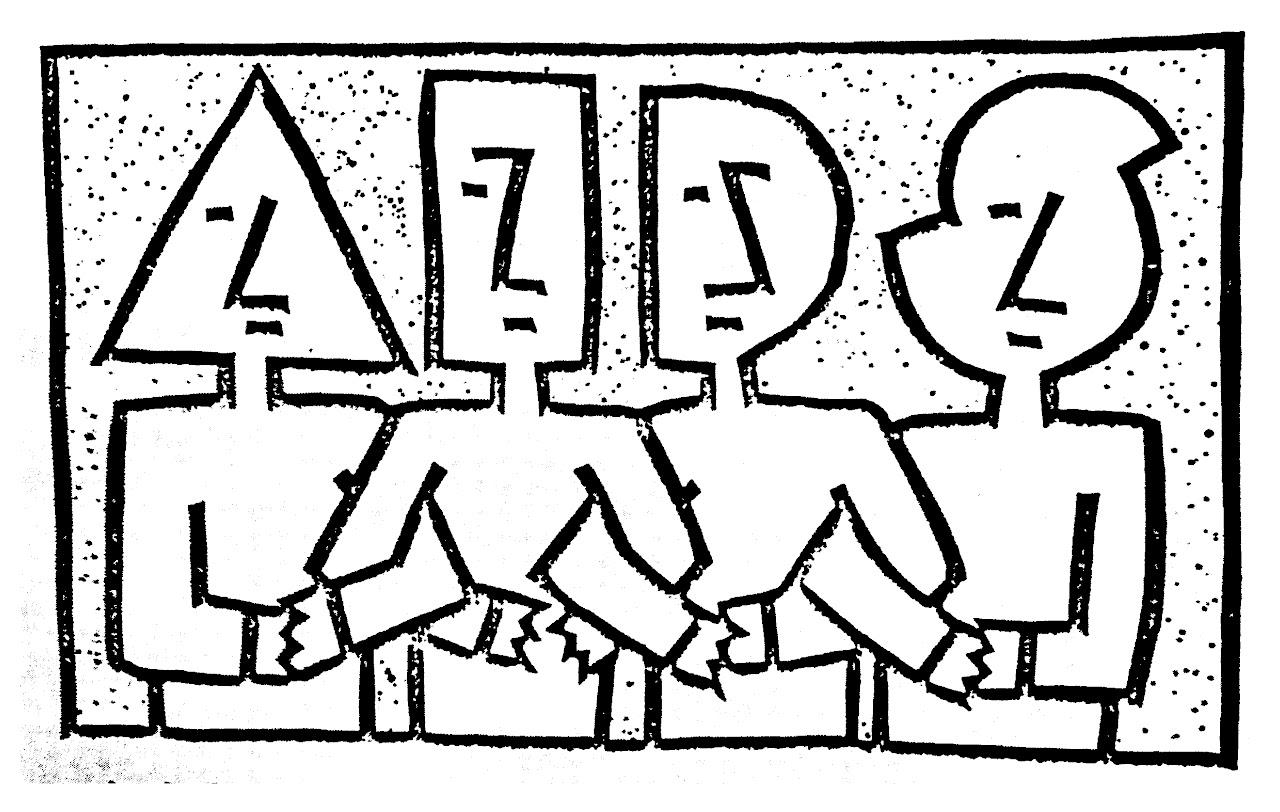
It was these efforts that sustained focus on AIDS prevention and general sexual education throughout the ’90s.
To commemorate World AIDS Day in 1991, SAAC painted Pomona’s Walker Wall with the words “AIDS does discriminate” and a picture of the world. In November 1992, they organized an AIDS benefit dance. According to a TSL article published at the time, the event raised over $7,000 for Foothill AIDS Project.
Though SAAC is no longer active, their work’s legacy can be seen in the continued safe sex education and resources promoted at the 5Cs. Commemoration of World AIDS Day also continues — this year with a film screening at the Benton Museum of Art and a queer sex trivia game at the Motley.
Jacqueline Tsai SC ’25 helped organize the trivia event to start conversations about the AIDS epidemic among today’s college students.
“Reviving this history of our community is incredibly important, especially at the 5Cs,” Tsai said via text. “I am so excited to see what our queer community can do here in the next few years.”
PAGe 6 December 2, 2022 Special p roject S
ELINA LINGAPPA & JADA SHAVERS
THe STUDeNT LIFe
This graphic appeared in a 1992 issue of TSL.
Original Lavender Letters
HANNAH WEAVER
‘Chosen family’ at the center of QRC mentorship program
JENNA MCMURTRY
For Claremont Graduate University student Annamae Sax, joining the Queer Resource Center as a mentor wasn’t just about finding queer community in Claremont. It was also about paying forward a sense of belonging that mentors had once given them when they were still an undergraduate at the University of Arizona.
Now, as a graduate assistant for the center, Sax oversees the 7Cs’ Queer, Questioning and Allied Mentorship Program (QQAMP).
Founded in 2001, QQAMP started when the QRC was still run out of “The Closet” in the upstairs area of Pomona College’s Walker Lounge and wasn’t yet the formallyfunded 7C institution it is today. The effort to create the mentorship program was largely driven by students.
Applications for the program are open on a rolling basis, with openings to become mentors or mentees. Head mentors then pair applicants based on interests and identities expressed in a survey.
By the end of their first year as a mentor, Sax had at least eight mentees, several of whom still keep in touch regularly.
“Applying and getting to be a mentor that year was so life changing,” Sax said. “I know how cliche it sounds. [My mentees] are changing my life just as much as I change theirs — but that’s a hundred percent true.”
Through QQAMP, mentors and mentees can help plan events at the QRC, which can vary as widely from

casual kickbacks over the weekend to trans-only swim hours.
Sax said a highly anticipated return to Hamburger Mary’s in West Hollywood for drag brunch will take place this weekend, an annual trip that often offers a first glimpse of popular LGBTQIA+ spots in Los Angeles for QQAMP
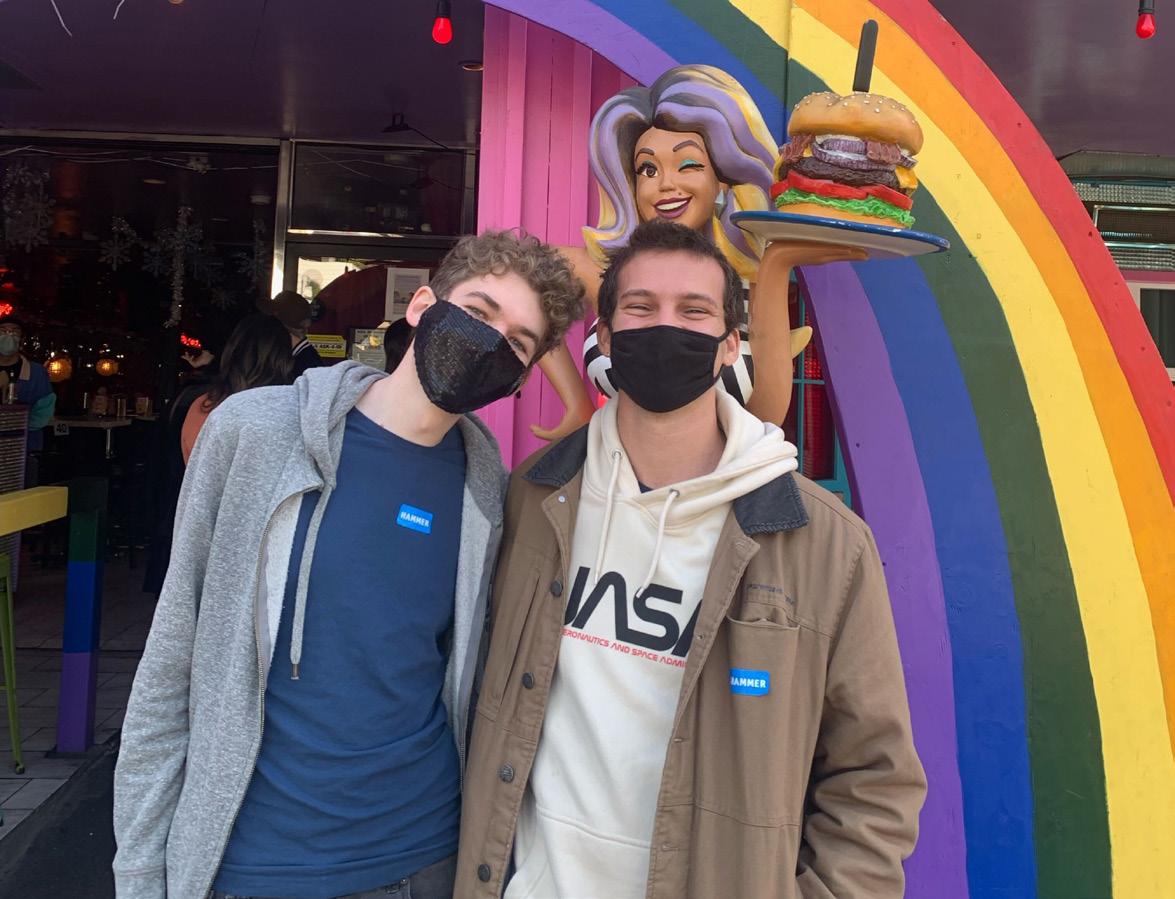
“Drag brunch was born out of an event we called ‘Queering LA,’” Sax said. “[For] so many kids, it’s their first drag show. I choke up every time we go and do it. These kids have such a good time.”
Working to oversee the entire QQAMP program, Sax said creating a space where students can be their full authentic selves is essential to all the work they do at the QRC.
“I know a lot of particularly capitalistic professional spaces encourage you to leave identities and leave stuff at the door and just come in and be ‘professional.’ And I refuse to work that way,” Sax said.
Instead Sax seeks to foster a space where intersectionality takes precedence and students’ whole identities — with all their complexities — can flourish.
Earlier in her career, Scripps Assistant Vice President for Student Affairs Adriana di BartoloBeckman spent six years serving the QRC, starting as a graduate assistant and later becoming the center’s director. Like Sax, she recognizes how QQAMP gives
students the necessary freedom to explore their identities.
“Not only do we get messages on how you’re supposed to be straight and cis[gender], we also get messages on how to be queer,” she said. “I think the mentor program is so important because so much about queering sexuality and gender is naming it for yourself. The definition of queer is the undoing what is normative, so how in this action of mentorship do we create space for the undoing of it?”
For Devlin Orlin PO ’25, finding QQAMP helped make his transition to college life as smooth as possible. Weekly meals and a budget for boba with his mentor turned into a friendship he would not have otherwise.
“The idea of horizontality is definitely prized in the mentorship program,” Orlin said. “The mentor gets just as much as the mentee does [while] meeting new people.” Jessica Delgado CG ’22 is working alongside Sax as a head mentor for QQAMP this semester before wrapping up a masters degree in English and Cultural Studies this fall. For Delgado, serving in a mentorship role has been crucial to expand what a representation of queerness can look like in academic spaces.
“It’s a complete full-circle sort of situation where I distinctly remember my first mentor at community college,” Delgado said. “I never really encountered someone who was so openly out in academia, specifically, so that was
really inspiring. To be able to do that for someone means the world to me.”
Through QQAMP, Delgado has been able to share a lot of the QRC’s other resources with students: a free clothing closet, study space and an expansive library collection of over 2,000 books and movies.
Delgado said having resources like those at the QRC have helped them recognize their needs, not only as a student but as a whole person as well.
“It means being able to have an actual space where there’s an ability to express queerness, and to be able to have conversations that are not uncomfortable and to address questions that might be uncomfortable somewhere else, but are totally normal in our spaces,” Delgado said.
Following the Nov. 19 Club Q tragedy in Colorado last month, both QQAMP and QRC have had to turn into a space for healing. What was initially planned as an event for Trans Remembrance Day transpired into a memorial with Monsour Counseling and Psychological Services for the five lives that were lost in the shooting.
Whether it’s celebrating someone’s first drag show or coming together in the wake of a tragedy, the QRC’s mentorship program boils down to togetherness.
“I feel like it’s always good to circle back to what the queer trans community has always done best: chosen family,” Sax said. “That’s what this program is really about: our chosen family and getting to build our community together.”
 LUcIA mArQUeZ-UPPmAN • THe STUDeNT LIFe
LUcIA mArQUeZ-UPPmAN • THe STUDeNT LIFe
OPINION: The cost of aesthetic convenience — how Canva subdues the radical
CASSIDY BENSKO & AVA FRANCIS-HALL
The Claremont Colleges currently host a large population of openly queer students — and yet any vague sense of community, of queer family, feels so distant. We feel the gravity of individual relationships between queer people. But the sense of fight, of shared struggle and history, largely feels absent, and nowhere is this more visible than the soulless visuals of a commodified queer identity offered by graphic design programs like Canva.
Providing thousands of templates for flyers, Instagram posts and Twitter banners, Canva allows for the seamless transition of ideas into aesthetically pleasing graphics necessary to compete in the economy of attention brought on by our visually demanding culture.
While Canva and design programs like it make the presentation of ideas and events easy and accessible, it’s worth investigating the organic, placespecific quality that’s absent from these ready-made posters plastered on our social media feeds and campus walls.
Queer people, specifically Black trans women, have been at the forefront of visual culture for decades. Working at the margins, they’ve harnessed the transformative power of art upon radical imagination to envision radical queer pasts, presents and futures. Manifestations of immense grief and hard-won pride, queer political protest art was often blunt, homemade, in-your-face and downright radical.
In the binders of vintage Lesbian and Gay Student Union (LGSU) event posters at the Queer Resource Center (QRC), this sense of counter-cultural irreverence is felt. Hand-written and composed of crude collages, these posters advertised queer student gatherings, screenings, dances and political
action with a uniquely fringe aesthetic that aligned with queer positions in society. Admiring the humor and creativity of these flyers, we began to recognize the life force that is absent from the ready-made infographics and flyers we see every day on campus.
In the late 1980s and ’90s, radical queer art had to be framed for public consumption as mounting pressure grew for activists to both publicize the fight against AIDS and enlist people in that fight. The movement needed symbolism that would be a unifying force across gay and straight populations.
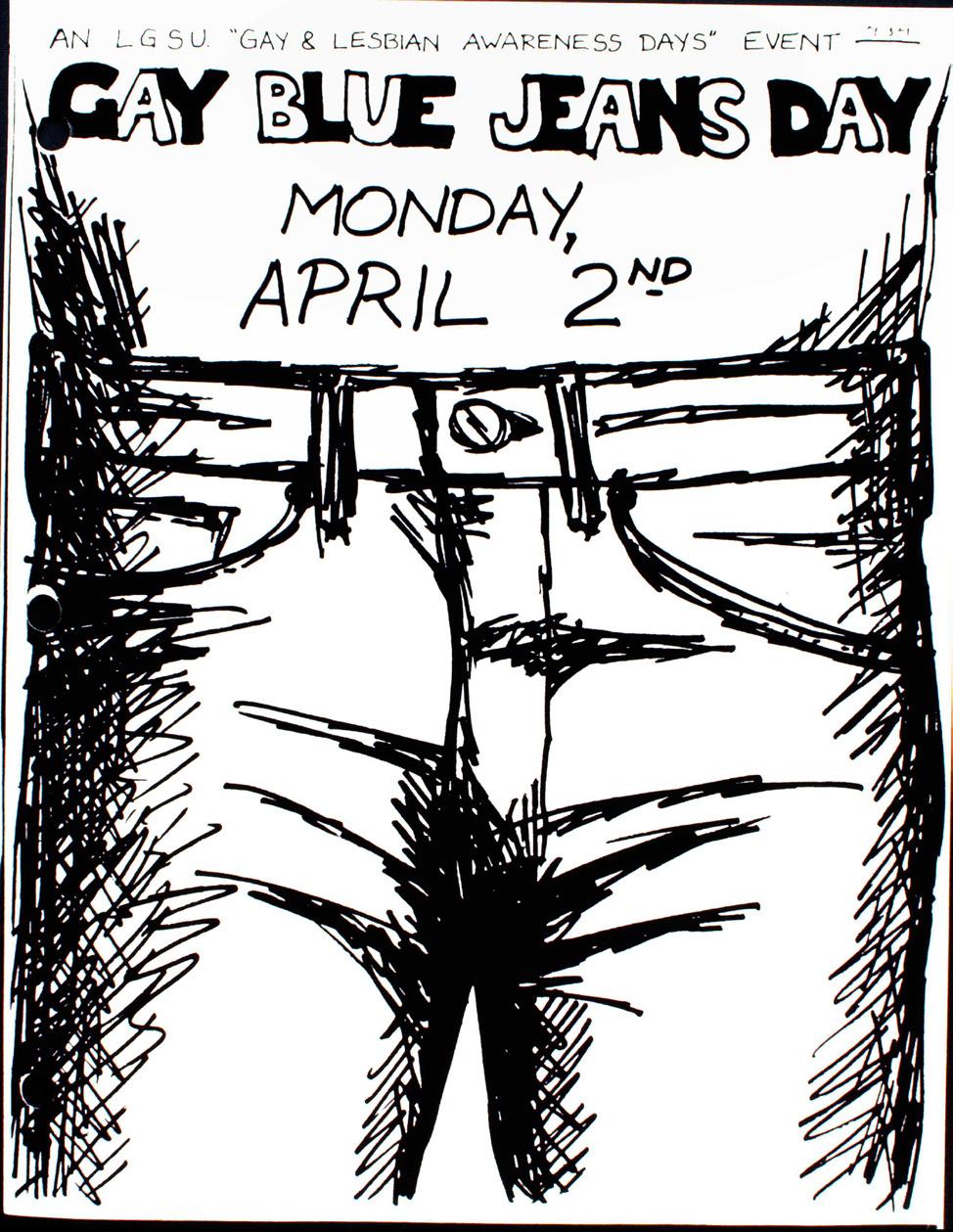
The artists decided on a pink triangle, used to mark homosexual individuals in Nazi concentration camps during the Holocaust, and the slogan “SILENCE=DEATH” as a warning beacon of queer present and futures.
This was advertising in a certain respect: readily distinguishable and palatable for all audiences. So why is this more radical than the current state of mass-produced protest art today?
The message was steeped in an unforgiving realism that did not cater to corporate interests and could be incorporated by queer artists in their own work.
Keith Haring incorporated the slogan and pink triangle into his work; in a black and white photo titled “Silence=Death,” artist David Wojnarowicz stares into the camera with his mouth sewn shut.
The symbolism could be reproduced because it was so wellknown, and the art was so wellknown because it was reproduced. But these reproductions were not a hollow, feeble request that people care. The art demanded people care. It had a sense of urgency, of authenticity that only comes from a community fighting for something bigger than itself.
There’s an odd feeling that comes with seeing the same trendy Canva template used for
both an Instagram boutique’s sale and a mutual aid request. They shouldn’t look the same. Why do they look the same?
The uniformity, the soulless palatability of these graphics spark the kind of recognition a distant car alarm might. Sure, it registers in our brain that something might be amiss, but the alarm eventually blends in with the rest of the noise. And that is what these graphics have created: blank, fuzzy noise that drowns out a recognition of significance.
The cultural emptiness is felt doubly with templates made specifically for queer topics. Radical queerness is reduced to a wash of images so cute and inoffensive they might as well be

Target ads, like cutesie Pride Month history infographics and neat Trans Day of Remembrance Instagram story posts.
Precooked and garnished with co-opted political language, these templates reduce queer political art into meaningless masks of faux allyship. The text “Trans Lives Matter,” a battle cry derived from the endemic violence and brutality faced by Black trans women at the hands of police, locked behind a paywall. The language of revolution slapped onto rainbows, gay stock photos and color-blocked minimalist figures — you may not have liberation, but you’ll never be at a loss for vapid corporate rainbow capitalism.
That being said, Canva is alluring. It is quick, easy and addresses some
accessibility issues that come with homemade flyers that can be harder to read. Further, it would be wrong to chastise unpaid activists for using platforms like Canva, as templated posts can help place grassroots causes on equal footing with large companies in the glittery, bloody fight for the human attention span that takes place online every second of every day.
In 1935, when discussing the consequences of an increasingly aestheticized political culture due to the accessibility of art production tools, media studies scholar Benjamin Walter wrote, “Fascism sees its salvation in giving these masses not their right, but instead a chance to express themselves.”
Canva, like production tools of Walter’s time, makes the expression of self unbelievably easy — but it stops there. If we traded ease for authenticity in the creation of promotional materials, the greater culture of these colleges would shift to something more organic and true to student expression. What if you knew the person who drew the art on the dorm bulletin boards? Or a physical copy of a club newsletter filled with comics was sent to members, like the Lavender Letters?
We must be cognizant of how the need for aesthetically appealing images has dulled radical politics. Instagram story posts cannot be the only method of maintaining community ties. As an unguided generation of queer people, we must seriously reckon with what is a digitally curated identity devoid of any attachment to history and what is a genuine identity derived from shared struggle and mutual adoration.
Ava Francis-Hall PZ ’24 and Cassidy Bensko SC ’25, with a newfound love of old gay posters (shoutout to our fave: “dyke study break extravanganza”), decided to put their noggins together, eat two chicken sandwiches and write this piece.
December 2, 2022 PAGe 7 Special p roject S
Jasper’s Crossword: Living colors 15. It follows anyone and any thing 16. Seth’s son, in Genesis 17. Mr. Krabs or Larry in Sponge bob 19. Domain for queer history 20. ___ Aid 21. It’s Women’s History Mo. 22. Lance of NSYNC 23. All Hallow’s ___ 24. “I know, I know!” 28. Sort of coil at a science mu seum 30. Attribute (to) 31. “___ me, hi / I’m the prob lem” (Taylor lyric) 33. “Just so you know...” 34. The Guardians, on score boards 35. Treat with applesauce and/or sour cream 40. Sun sign? 41. Aliens, for short 42. Skipped school year, perhaps 43. Coffeemate, for one 46. Section of a market 50. Alternative to car dependence 54. Custom Ink offering 55. Stage of testing 56. Where rainbows appear 57. Turing who’s now the first gay man on a British banknote FOR WEEK’S ANSWERS, SEE PAGE 10 JASPer DAVIDOFF • THe STUDeNT LIFe 58. Kim Booster who stars in Fire Island 59. Symbols in queer history — and parts of this puzzle 62. Ye ___ Pub/Inn/Shoppe 63. It’s under your foot 64. Copy of The Advocate mag azine 65. “___ On Me” (Adele ballad) 66. Not as much 67. App used for some apologies DOWN 1. Like Mufti, as a society 2. Come on the scene 3. Monsters 4. Socialist’s symbol 5. “The Queer ___ of Failure” by Jack Halberstam 6. Star of a southern pie 7. Push notification, sometimes 8. Posse at LAX 9. Chick’s mom 10. Darn! 11. How Korean corn dogs are served 12. In the cards 13. Timezone for the Stonewall Inn 18. “Te ___, te ___ / She says to me” (Rihanna lyrics) 22. Airer of I May Destroy You 24. It can be mined or dumped 25. ___ and the Last Dragon 26. Wielding 27. Originally, for a newlywed 29. AP ___ (vs. AP Lang) 32. Be at the wheel 33. Video game stat. 35. Rainbow’s shape 36. March Madness heavyweights 37. ___ vez (Again, in Acapulco) 38. You might sign it on an arm 39. Fitting 40. Chnl. for vintage films 44. Rick of Rickrolling 45. NYC subway’s org. 47. “Finally!” 48. An ‘L’ in football or baseball? 49. Elements of kaleidoscopes 51. They might be painted 52. Salads
fries,
53. Outrage 57. Plus 58. Green
Arm strong 59. Autumnal
60. Chicken
61.
ACROSS 1. Hummus that has been repeat edly recalled 6. Passage 10. Knot me! 14. Reason for a correction
cOUrTeSY: DeVLIN OrLIN QQAMP sponsors an annual drag brunch to Hamburger Mary’s in West Hollywood.
and
perhaps
Day’s Billie ___
S’bux staple
of the sea’s egg, say
Part of a whale
cOUrTeSY: Qrc
An undated flyer for a LGSU event.
Snapshots of queer life
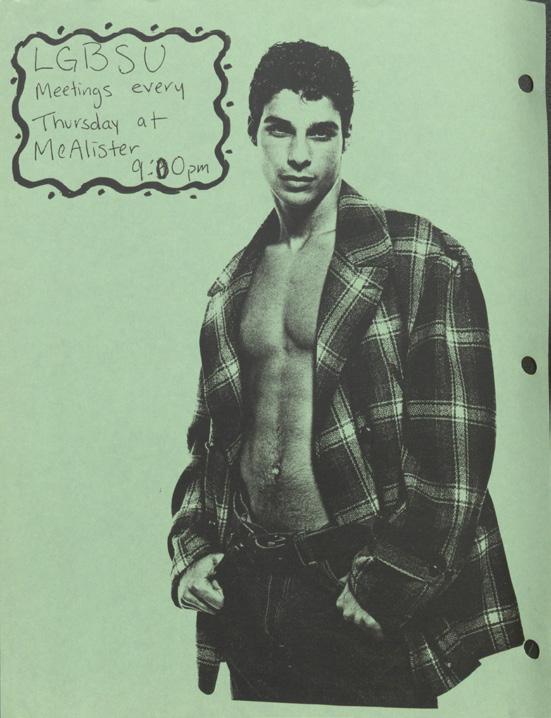
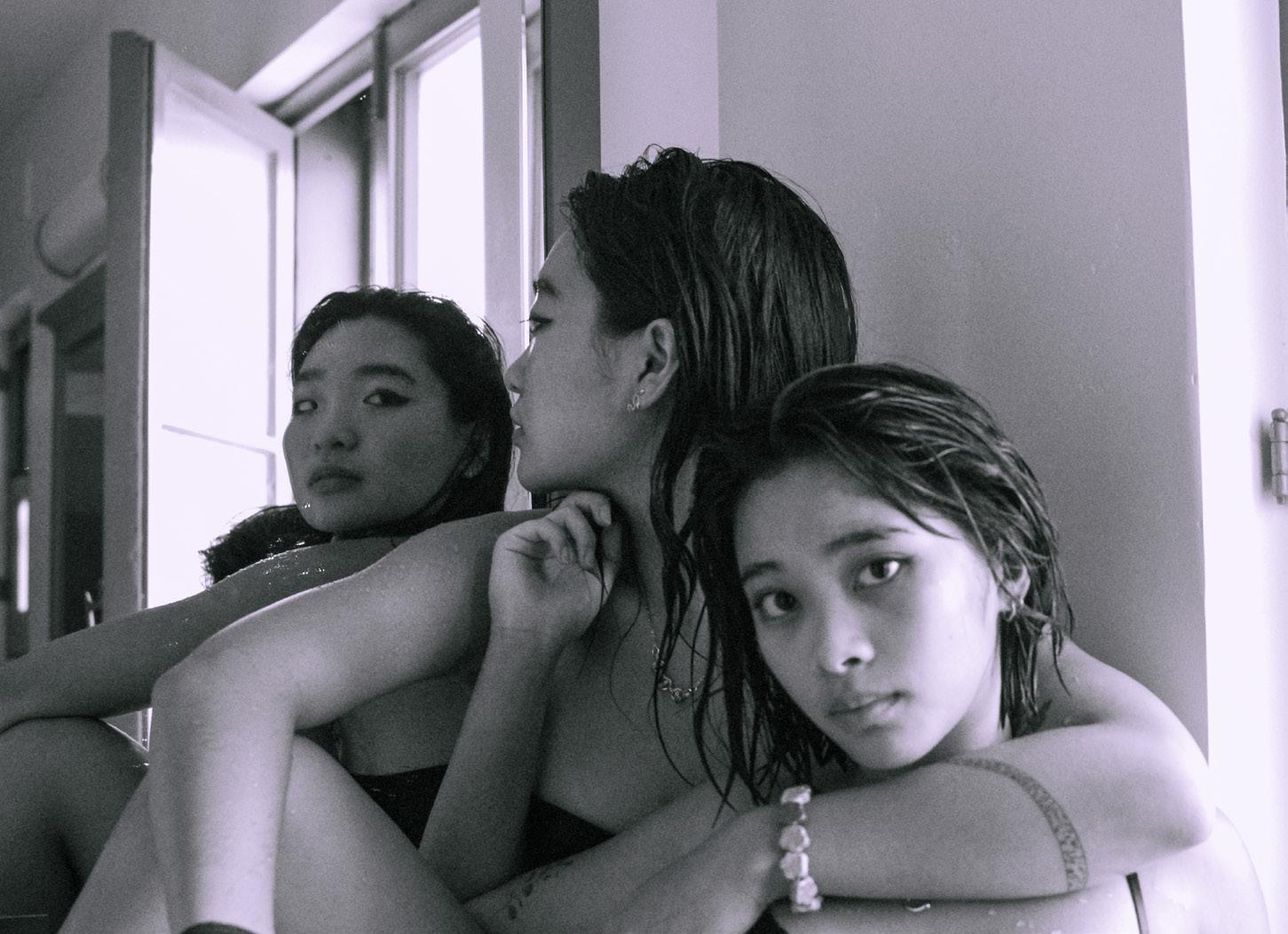
Corina Silverstein
Lena Farley
PO ’25
“I used images I found in the 1969 LIFE magazine to create this collage. The picture of the young children reminded me of many pictures from my childhood of me and my friends playing in na ture. Now that I’ve grown up and am still in touch with some of my childhood friends I created this collage to show the nostalgia old pictures hold and the memories that can still be made with these same friends today. Even so, it will probably never be the same. Fol low @fromtheriverbank for more collages/doodles “

Mia Fenyak SC
’25
“This piece titled ‘Cut-Out’ in cludes two large scale pairs of scissors, both stamped with the word “Dyke” and a small plaque that reads ‘Scis sor Me Scripps.’ It is currently hang ing in a prominent place in one of the Scripps College residential halls. This piece was designed to push against the violence of the archive and proud ly display the long-term lesbian pres ence at the college. I incorporated the phrase “Scissor Me Scripps” as an ode to previous rhetoric used to degrade a community that has since become one of the defining sources of pride within the student body.”
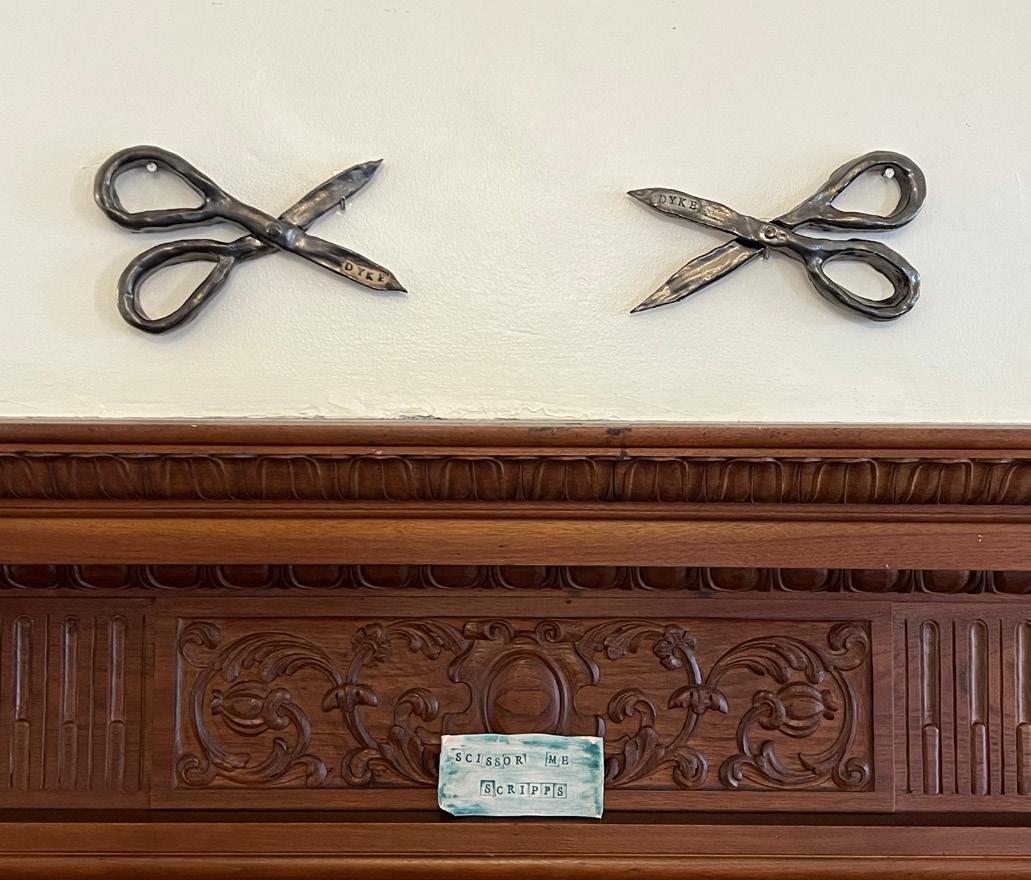
CMC Grad Shares Five Reasons Why He Hated It
This article is a reprint from the March 1, 1996 issue of TSL.
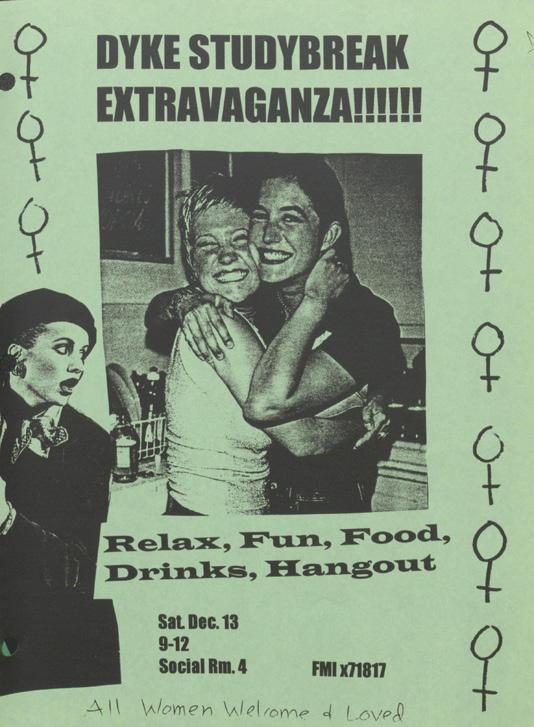
The Beckett Hall newsletter had the basic dorm news, and it also in cluded a gossip column. The column had a regular feature titled the “Fag Alert” which reported alleged homo sexual activity by dorm members. When the publishers were confront ed by an offended student, the paper included the student in their next Fag Alert. Undaunted, the student took the dorm newsletter to the Collage who published it with the names deleted. The Collage ran an editorial about homophobia at CMC and the RA of Beckett stepped in and prohib ited future Fag Alerts. The students were never reprimanded by the ad ministration for their slanderous hate speech.

In the late 80’s and the early 90’s, several sexist incidents at CMC gained national news coverage. Un able to ignore the problem any lon ger, Jack Stark, President of CMC, appointed a task force to investigate sexism on the campus even though he stated his belief that CMC did not have a problem with sexism. At an open forum on the subject, Jack Stark admitted that he had lived a largely all male existence: from an all male high school, to the Marines, to a stu dent at an all male college and final ly as an administrator of an all male college. He granted that perhaps he was not as sensitive to women’s is sues as he should be. Talk about an understatement! Jack Stark was, and
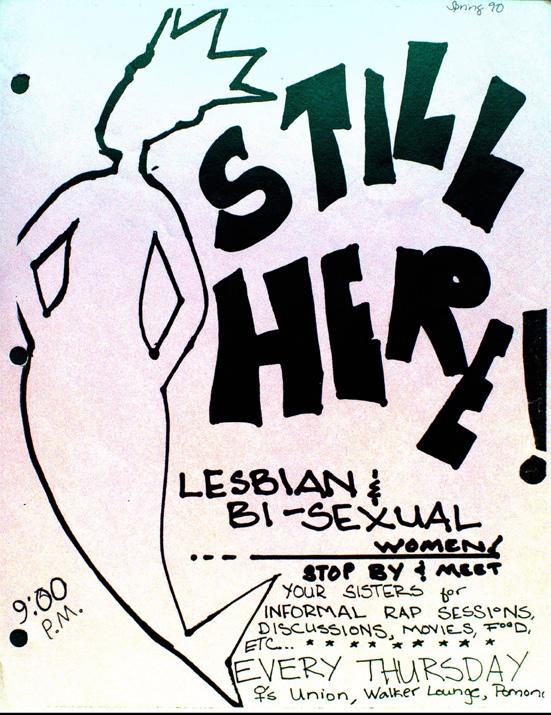
remains, totally out of touch with the issues that face the campus. The fact that he needed to appoint a task force to determine whether there was sexism at CMC shows how clueless this man is.
In case you haven’t realized it, the school exists because of the Development Department, not the other way around. The profes sors, the classes, the dining halls, the dorms, the entire college is just a front operation for the mon ey-grubbing drones of the Develop ment Department. Publications like Profiles are the propaganda that fuel the illusion that education is CMC’s major goal. CMC will mar ket it’s “diverse student,” as long as diversity sells. They clearly haven’t realized that drag queens are a hot commodity at the moment, or we would see articles about CMC’s “thriving drag culture”.
At one time I was the only out gay man at CMC. Torrey Sun once confessed to me that he could count the number of gay and lesbian stu dents at CMC on one hand, and therefore could not justify “making a big deal” about gay and lesbian issues. As long as gay and lesbian students at CMC remain silent, the college will never take their con cerns seriously. Despite the invis ibility of gay men and lesbians, I had no trouble finding willing male sexual partners. After a couple of beers, those closet doors come fly ing open! By the time I graduated from CMC, I knew five closeted gay men from ROTC, four from the football team, three from the
water polo team and three from the Young Republican club, to name a few. Yet these very same students would laugh at lesbian jokes, would write anti-gay ar ticles in the college newspapers and would lobby against antidis crimination policies. Although I knew of two gay faculty members who were out of the closet, only one was courageous enough to be open with his students. I know of at least two professors who are gay, but closeted. These same pro fessors often bashed the gay lifestyle in their professional life, and yet I saw one of these professors last month cavorting in a gay bar in Los Angeles! I understand the pressures that would cause indi viduals to remain in the closet, but I cannot condone the hypocrisy of those who had bashed gays and lesbians while secretly having sex with the very people they claim to despise.
For the most part, CMC stu dents are a bunch of sheep; sheep with very good SAT scores and GPA’s, but sheep nonetheless. No one dares buck the system for fear of ruining those all important let ters of recommendation. No one wants to protest the corruption around them because a bad con duct mark on student files might cost a prestigious job. Few stu dents have any firm beliefs and would rather parrot the views accepted by the flock. Reaction aries who fight the PC dogma are as brainwashed as the bleeding heart liberal who preach it.
Alexandra du Manoir
“My name is Alexandra du Manoir, and I’ve been writing ba sically my whole life. As I discovered more about my identity, a lot of my written pieces became mediums for exploring my queer experiences, joy and heartbreak included. “
cobweb’s melody
Your image visits me in doses Similar to the pills I ingest to stay Above. Bathwater.
Your vision visits me in my nightmares That are clouded as dreams from an Alternate dimension. Oh, to love a brick wall.
I can’t even utter the world “love” without Seeing your voice. A spell of colors and depth And all that is vibrantly breathing.
Let me free of a memory of home. Let me free Of a memory of a silenced dome. Let me free of a rotting Definition of “intertwined” that I’m too tired to remember.
I wish you weren’t an artist. It’d be easier To hate you, then. I wish you were a sociopath So that my unrequited love was just a product of a social gam ble.
I guess I wish I wasn’t writing this. Because then I would be free and you Wouldn’t speak to me like my therapist does… Taming me like a fire you need to put out. In the middle of the woods we fell in love in.
Kat Lin
PZ ‘24
“Kat Lin (she/her) is a multimedia artist from Southern Cal ifornia. Her piece pinkies (2021) was made as a way to demon strate her experiences with queer yearning and gradual accep tance. The colors of the three elements in the piece are meant to represent the bisexual pride flag, with the violets in the back displaying saphhic love. pinkies is a hand-drawn piece, digitally scanned and edited/colored via Photoshop.”
pinkies (2021)
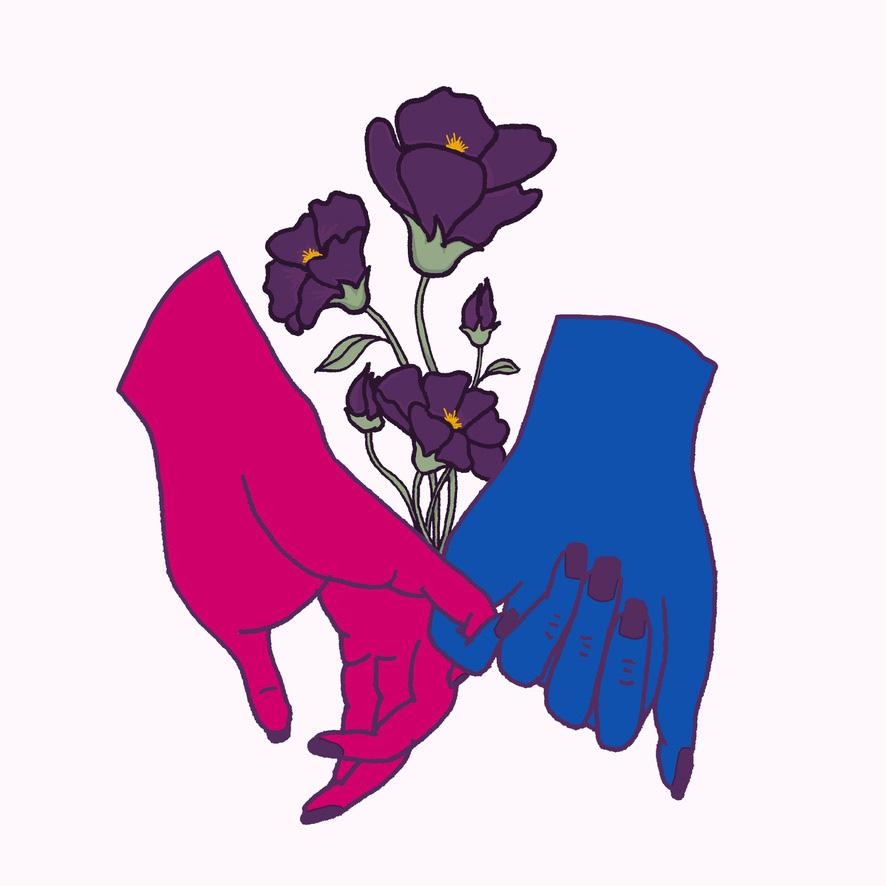
PAGe 8 December 2, 2022 Special p roject S
SC ’26
SC ‘25 @corinaspixels
“This
shot
was taken during a
photo
shoot I was hosting for some friends in the Toll bath room on the second floor. When I think about communal living at Scripps one of the things that come to mind is the semi-homoerotic tension there is to be so close to other queer people (emotionally and physically).”
PAUL MIAILOVICH PO ’93
Vintage LGSU event flyers An undated flyer for a study break for lesbian students. An informational Pink Triangles flyer from 1990. An undated flyer advertising a weekly meeting. cOUrTeSY: Qrc cOUrTeSY: Qrc cOUrTeSY: Qrc An undated flyer inviting students to paint Walker Wall. cOUrTeSY: Qrc
An homage to OutSpoken, TSL asked the 5C queer community for multimedia submissions
Funny flavors in busy seasons
I’m not gonna lie — I’m stressed. The semester ends in approximately two weeks, and there is so much to do and simply not enough time. I know myself, and while I could eas ily lock myself on the fourth floor of the library and work all day, I’m try ing to achieve a better balance. I’m trying to still make time to spend with friends because what I’ve learned over the semester is that the laughable moments with friends are integral to the college experience.
In early November, I went on a retreat with the 5C club First Love. I had a mountain of work to complete that weekend, and I was not alone. People had midterms that upcom ing week, papers to write and pre sentations to practice for — the list was endless. We all could have easi ly spent our weekends working, but we all — hesitantly — decided to take a break and spend 26 hours to gether enjoying the nature of Crest line, California instead.
Those 26 hours were the most absurd 26 hours I have ever lived through. A friend’s car got stuck on an insurmountably steep driveway, another friend almost got locked in side a bedroom due to the Airbnb’s highly dysfunctional door and I was inadvertently baptized with a flood of toilet water falling from the ceil ing.
But what made me laugh the hardest was our Sunday morning breakfast, which, in my mind, was the perfect way to end this circus of a retreat.
I woke up on Sunday morning and groggily made my way to the kitchen to cut up some Costco muf fins for people to eat. As I placed a slice on my plate, I noticed my friend Claire fumbling with the mi crowave.
“What are you microwaving?” I asked. My eyes then fell to the bag of Dino Nuggets that we used for last night’s dinner. “No way,” I said, shaking my head and laughing. “It’s seven in the morning!”
But indeed, Claire was mi crowaving Dino Nuggets for people’s early morning protein fix. Once the microwave’s timer went off, she funneled them onto a plate, and I placed a few next to my muffin, chuckling. “It’s like college chicken and waffles,” I said. “Fried chicken, but chick en nuggets. Waffles, but Costco muffins.”
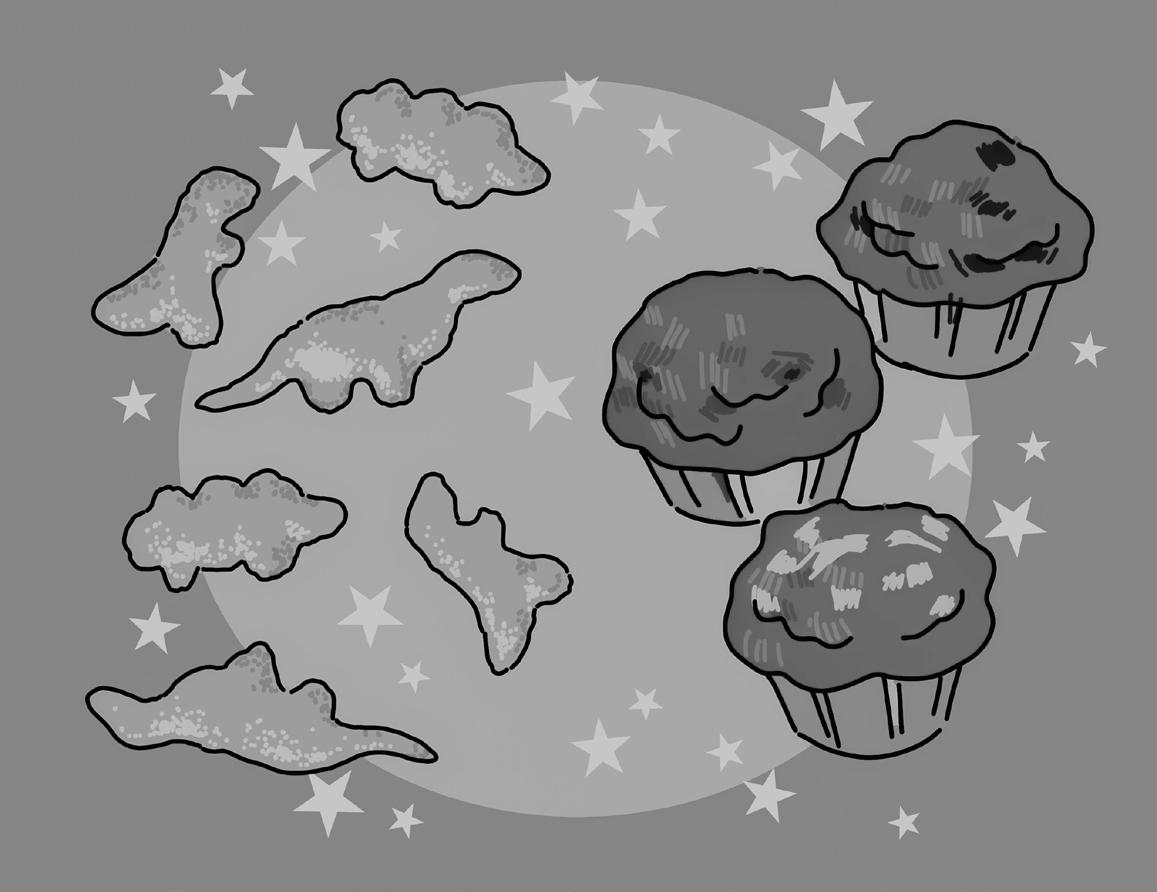
As more people woke up, they grabbed their own plate of “college chicken and waffles,” laughing at how the savory nug gets surprisingly complemented the sweetness of the blueberry cake and vanilla icing. We feast ed together in the chilly hours of the morning, reminding people not to close the dysfunctional door all the way and to avoid the upstairs bathroom. The time to gether was so sweet.
It is moments like these that I think back to whenever I feel caught up in the stress and busy ness of school. Yes, I have a pa per to write and an exam that, at the present moment, I feel entirely unprepared for. Yes, I could spend my entire evening in the library and have more than enough work to entertain me. But time with friends, especially eating together, is precious and should not be missed out on.
In the last couple weeks of the semester, I know you will be busy. I hope, however, that amidst all the assignments on your to-do list, you make time to spend with your friends. Take a study break and eat something good! Find the “college chicken and waffles” for you and your friends! I assure you that the work will get done, and who knows — with friends by your side during this hectic season, you may even be smiling through it.
Emily Kim PO ’25 is from Irvine, California. You will always find her with a scrunchie on her wrist and napping in Lincoln Hall.
The haunting tenderness of ‘Bones and All’
HANNAH ELIOT
“I don’t know whether to cry, or scream, or laugh, or what,” cries Maren (Tay lor Russell) in one scene of Luca Guadagnino’s latest film “Bones and All.” Just like Maren, you won’t know whether to cry or scream or laugh when watching Gua dagnino’s latest film. “Bones and All” is a grisly but sur prisingly delicate story of young love and the search for belonging.

We are introduced to this world through teenage can nibal Maren, who has been abandoned by her father (André Holland) after a high school sleepover ending in bloody dismemberment. Lat er on, she meets Lee (Timo thée Chalamet) at a conve nience store, looking on as he deals with — and consumes — an obnoxious customer. As they fall in love, the pair set out on a road trip across Middle America in search of Maren’s long-lost mother.
On the road, they encoun ter other “eaters” like Sully (Mark Rylance), a creepy lon er who is eager to take Maren under his wing. Others, like two redneck eaters (Michael Stuhlbarg and David Gor don Green) whom they cross paths with in Missouri, are more palpable threats.
Somehow, despite the can nibalism, you still care for Maren and Lee. While Gua
dagnino
Canni balism is shown for what it is: feral, animalistic and shameful.
What defines Maren, Lee and other eaters is an illness, a lifestyle and an identity. It’s something they’re born with and something those around them — the ones who become their meals — can never fully understand. Even as a toddler, Maren is discovered feasting on her babysitter.
The film doesn’t define the origins and particulars of this strange hunger, leaving it as an enigma for a quietly thought ful Maren to grapple with. It makes her an outsider to soci ety but also, in some ways, un knowable to herself.
Throughout the film, Mar en searches for a more ethical approach to cannibalism. She discovers that individual eaters seem to make their own rules. Sully tries to seek out victims who are on the verge of death, while Lee persuades himself that his prey somehow had it coming. Maren, however, still imagines herself as inherently good. Her belief in her own in nocence is disarming, and Rus sell’s performance is fresh and earnest.
Guadagnino is a talented
its atmo sphere, and through it, we gain a deeper sense of the loneliness haunting those living on the margins -- those in towns rav aged by an opioid crisis, political ideological rot, inherited family trauma and broken homes.
“Bones and All” is a story about the longing to be loved — and finding someone who finally makes you feel seen in a world where that connection is all too rare and where you can often times feel like “the only one of your kind,” as Maren calls her self early on.
Guadagnino’s film is also, naturally, a film about hunger — and not only the hunger for hu man flesh, but also the insatiable desire for emotional intimacy. It is the desire for someone to see you for all you are — even the darkness you try to scrub out.
Young love lingers, filling a special place in the heart, and so too does “Bones and All.”
Guadagnino’s film contains bone-chilling horror but also an unexpected depth that will swal low you whole.
Hannah Eliot SC ’24 is from San Francisco, California. She likes to surf and is trying to learn to play the guitar.
Almost 50 years later, Tim Deegan, Sal Piro and Richard O’Brien reflect on ‘The Rocky Horror Picture Show’
This Halloween, the 5Cs had a chance to experience two live per formances of “The Rocky Horror Picture Show” put on by 5C stu dents. Pairing a live show with the film running in the background, act ing and audience participation, the show created a chaotic, energetic and memorable experience.
“The Rocky Horror Picture Show” has found a large communi ty outside of just the 5Cs. The pro duction gained immediate attention after the midnight shows were first released in 1973, and people around the world are currently preparing for the production’s 50th anniversa ry celebration next year.
As a liberating production that allows audiences to free themselves from the restrictions of society, this anniversary of the first midnight show is more than just a celebration of a movie. It is a celebration of liber ation, freedom, queerness, commu nity and support.
In an exclusive interview with Tim Deegan, an advertising man ager at 20th Century Fox at the time of the show’s premiere and a lead point in the marketing of Rocky Horror, he explained the origins of the production.
“After a poor box office show ing in Los Angeles, and a failed test market for a college audience in Co lumbus, Ohio, the studio shelved the movie,” he said.
The first screening was a dis appointment, but many were too afraid to admit it because Fox 20th Century had already bought the dis tribution rights. Deegan was twenty at the time, and he explained that Lou Alder, the producer of the film, looked to him to provide honest feedback.
“Everyone was scared stiff,” Deegan said via email, “of being associated with a gay movie which is how they perceived it … “sweet transvestites from transsexual Tran sylvania” was a slogan that gave them shivers.”
Unafraid and interested in the
challenge, Deegan fought for the failed film to be shown in the Wa verley Theater in New York City at midnight. These midnight shows immediately blew up.
“The movie was so unique that once audiences ‘discovered’ it [...] word of mouth would carry it. My marketing plan was two-pronged: no advertising and you can only see it at midnight. No studio had ever played a movie at midnight,” Deegan said via email. “It was an instant success.”
Richard O’Brien wrote the show in 1973 and acted as Riff Raff in the movie. O’Brien explained via email that the production had “freedom of joyful expression and [an] ability to poke fun at many norms in a satirical fashion.”
This “satirical fashion” allowed the production to flourish into the popular show seen today with callouts from the audience.
Sal Piro, the president of the Rocky Horror fan club, saw some of the shows’ earliest productions and explained how the audience
began to become a part of the ex perience.
“It’s from that camaraderie we had with each other that we started to explore the possibilities of participating [with the show],” Piro said.
Piro explained how he and oth ers would find new things to say with the film to continue mocking its contents, many of which are still said today. This mocking is lighthearted and coincides with the production’s ability to expand beyond the expectations of society.
“I don’t think that there was any ‘queer’-driven agenda attached to our production,” O’Brien said via email.
Even without a queer agenda, Rocky Horror was one of the first representations of queerness in the media scene, and audiences turned the production into a show that represented liberation. This combination allowed for limited homophobia towards Rocky Hor ror in the media world especially for the time of when it was re
leased.
“There were NO homophobic outbursts,” O’Brien explained via email. “In fact, one of the great sur prises is that the audiences loved the Frank character so much that they were surprised by their own attraction to him.”
Everyone had their own rea son for seeing and loving Rocky Horror. Piro explained that his connection with the film “became a lifestyle.”
This lifestyle, however, “wasn’t easy in the beginning because peo ple didn’t like what they saw,” Piro explained.
He explained some of the dangers he faced as gangs would torment people trying to see the show, and his life was threatened.
Despite this danger, audiences kept coming to see the production. Deegan explained via email that “in a metaphorical sense, maybe the only ‘flag’ those kids had to ral ly around was ‘Rocky Horror’ as a safe refuge for a couple of hours on weekend nights.”
The refuge Rocky Horror creat ed allowed a unique and inclusive community to form, which expand ed to include the fan club that Piro helped found. Started shortly after the release of the midnight shows in 1977, the fan club was used to spread information about where shows were happening, as well as any Rocky Horror news.
Originally, the club spread news through letters, but today the fan club primarily functions via a web site. “20th Century Fox, the produc er, saw that we were good tools,” Piro said, “we were better than [their] paid people.”
Eventually, the fan club evolved and grew with time while retaining the strong community that it started with.
“What turns me on is the group, the family,” Piro said. “Everybody’s sharing this movie with each other.”
The production was a safe space for audiences and a starting point for O’Brien, Deegan and Piro. As a launch pad for their careers, they were able to create names and leg acies for themselves, as well as pro vide a representation of queerness that had been lacking.
“Dream big,” Deegan said via email. “Don’t have such rigid ex pectations that you miss a golden opportunity that may pass you by. Take chances.”
Rocky Horror is one of the best examples of what it means to take a risk: O’Brien risked his career to portray queerness, Deegan risked a failed viewing and Piro risked his life to experience camaraderie. Au diences impacted the production’s meaning and the production im pacted audiences.

“There were more people at that time accepting [queerness], then rejecting it,” Piro stated. “I saw a change that people began to accept it.”
The production’s influence is getting another chance to impact the 5Cs. Look out for news from @rockyhorror5c on Instagram to hear more and join the ex perience!
December 2, 2022 PAGe 9 Arts & Culture
doesn’t shy away from the visceral shock of their un speakable impulses, his em pathic view of their lifestyle keeps us from seeing them as monsters. The act of feeding — ripping with teeth, face deep in the flesh of another human — is an assault on the senses.
visual storyteller, and you feel that in every frame of this film. He pairs lingering shots of the rural Midwest with Trent Reznor and Atticus Ross’ tender, wist ful score, making “Bones and All” feel fully lived-in even in its most languid moments. A sense of isolation suffuses
EMILY KIM mOmeNTS TO SAVOr
GerrIT PUNT • THe STUDeNT LIFe
cOUrTeSY: TWeNTIeTH ceNTUrY FOX FILm cOrPOrATION
JADA SHAVERS
FILm FILeS
LUcIA mArQUeZ-UPPmAN • THe STUDeNT LIFe
The production gained immediate attention following the addition of midnight showings in 1973.
Pitzer should revoke Kevin de León’s degree — or at least say something

“The 5Cs are so small” is a complaint that anyone who goes to the Claremont Colleges has likely heard before, if not said themselves. This smallness has effects on how we perceive and what we expect from the people around us. Because we interact so closely with the people on the campuses around us, we expect the people in our community to subscribe to similar values, such as inclusion and social responsi bility.
This unsaid social contract that we have cultivates a strong community at the 5Cs, and so when someone in our community violates this social contract, it sets everything off balance. When this balance becomes unsteady, we must address it. But, in the case of the harmful comments made by Pitzer College alumnus and Los Angeles city councilmember Kevin de León PZ ’03, nothing has yet been said — and the si lence is highly noticeable.
In early October, an audio recording of a conversation be tween members of the Los Ange les City Council was leaked. On it, the voices of Los Angeles City Council President Nury Marti nez, Councilmember Gil Cedillo, Los Angeles County Federation of Labor President Ron Herrera and de León are heard. The rac ist comments made are wholly disgusting and horrifying, espe cially coming from the mouths of government officials. The conversation impacted the Black community, used stereotypes to allude to Oaxaqueño people and perpetuated harmful racial iden tity politics, pitting Latinx people against Black people. And the voice that hit the closest to home
was de León’s. There have to be conse quences for our actions. As a Pitzer graduate, de León should be upholding the values of the college. However, he did not exhibit behavior aligning with the values of intercultural un derstanding and social respon sibility. As a small school, Pitzer has a very traceable alumni network. There isn’t any excuse for not recognizing this scandal — and a lack of comment on it quickly becomes apparent. Kevin de León has since
apologized for his comments during this leaked meeting. Yet the comments he made about his fellow council member, Mike Bonin’s son, comparing him to a handbag, can’t be tak en back. Nury Martinez, who resigned as president of the Los Angeles City Council after the leak, seemed to lead this con versation, making the bulk of the comments during this dis cussion. But de León should not be pardoned because his fellow council member made many of these comments. He should be
held accountable for not stop ping this rhetoric as someone present in the room.
What has Pitzer done to address Kevin de León’s com ments? Nothing. There has been no official message from the col lege about his actions. The only message that was sent to the Pitzer community was an un official email from psychology professor Mita Banerjee, who asked us all to send a message directly to de León’s office that communicated our disapprov al. Nothing was sent from the
president’s office, deans or any administrative staff — there’s just been silence.
Pitzer, as an institution, has the power to go so far as revoke his degree, and they should. De León’s words and lack of action clearly show that he doesn’t follow Pitzer’s core values. Al though de León has since apolo gized for his words, his seeming inability to resign from office shows his lack of humility and stubbornness to own up to his mistakes.
This was news that happened very close to Claremont. This was news that had repercussions for Pitzer students and their fami lies. This was despicable rheto ric that an alumnus participated in — and yet Pitzer stays silent. It doesn’t have to be as radical as taking away his degree, but they should at least address the possible impacts of his actions on Pitzer and larger 7C commu nity and his misalignment with Pitzer’s core values.
A month has passed since this story began to unfold. The Pitzer administration needs to stay true to the college’s core val ues and be held accountable for addressing remarks said by stu dents — current or former — un derstanding that these comments impacted students on campus.
Pitzer should’ve said something, anything, but they didn’t. As the bid for Kevin de León’s recall is launched, Pitzer has another chance at acknowledging this sit uation, getting behind it and ad vocating for its student body and the whole Pitzer community.
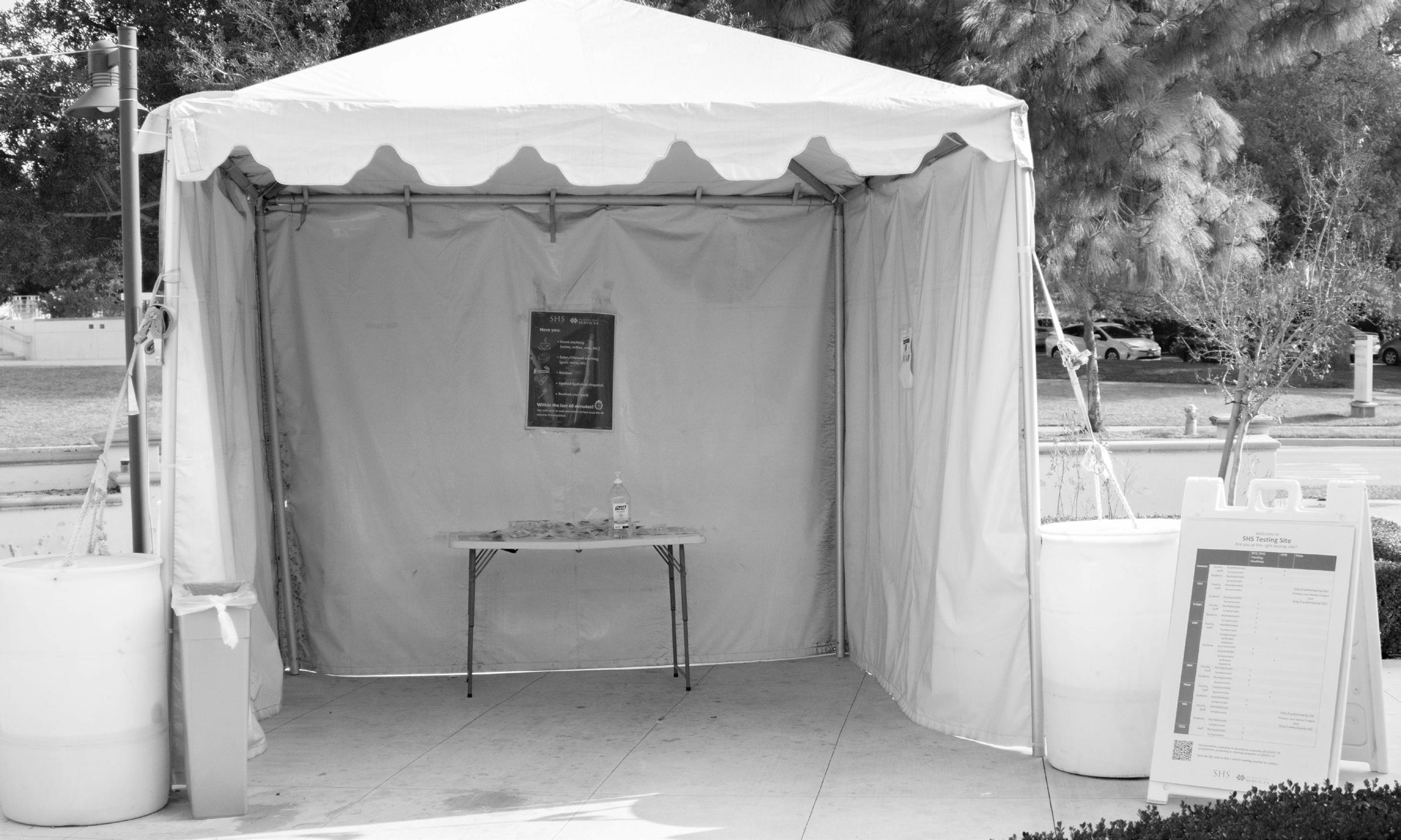
Aaron Matsuoka PZ ’26 is from Redding, Connecticut. He enjoys spending time with friends, being outside and scented candles.
Editorial Board: The essay is not the punishment
OK, so you forgot to test after returning to Claremont following break. We’ve all been there, or at least experienced some similar sort of slip-up in our back-to-cam pus frenzy. You had your upcom ing finals on your mind and by the time you stepped out of the li brary to test, it was well past the 5 p.m. Friday deadline. Without last year’s regular testing schedule in place this semester, you forgot the time before, too … so, now what?
Whatever the reason, missing a test happens. It’s great that the colleges — for the most part — seem to keep track and alert stu dents when they’ve missed one of the post-break testing cycles that several of the 5Cs have put in place. It’s a considerate man date aimed at keeping our com munities as safe and conducive to learning and good health as possible.
What’s not great, however, is how Pomona College deals with students who have missed two tests: by assigning a mandatory essay.
For those whose plans to test go awry, Pomona mandates a meeting with a class dean fol lowed by a “5-page (excluding bibliography) research paper … in Times New Roman size 12.”
We attend institutions where interdisciplinary learning is sup posed to be put on a pedestal — where the arts are meant to carry the same weight as the sciences — so why is punishment hand ed down in the form of an essay? This is the question that Pomo na’s COVID-19 Planning and Re sponse Group needs to answer. A pedagogically friendlier alterna tive is an imperative.
Sure, having some collateral at stake is oftentimes a necessary in centive to get students to comply with testing mandates. But, why an essay and not a biology test? Whether intentional or not, the use
of an essay blatantly pits writing against other academic disci plines and unfairly positions the written word as a punishment.
Even then — biology test or not — any form of education al-practices-turned-punish ments are not the way to go.
Making a punishment out of writing is antithetical to the very essence of the liberal arts experi ence. Liberal arts grads are sup posed to pride themselves in the stronger writing skills they pur portedly walk away with after
graduation. By making a pun ishment out of writing, however, Pomona sets itself up to squan der the core elements that make up the well-rounded liberal arts curricula for which we chose to attend the 5Cs.
Pomona, take a page out of Roy Peter Clark’s book. The highly esteemed writing lectur er — a journalist himself at heart — knows all too well what little good comes out of the essay in the form of a punishment.

Clark’s 1987 essay “I Won’t
use Writing as Punishment. I Won’t…” still rings true today, thirty five years after the Poyn ter Institute’s lead scholar first wrote it.
To cite Clark, writing neuro sis, which forms after coming to view writing as a punishment, is hard to rewire once established.
At the 5Cs we should be de veloping the skills to relish in a good book or a well-written re search paper. Instead, Pomona’s sending mixed signals. Making a punishment out of writing only
seeks to spur resentment.
If Pomona finds that a puni tive response is the only way to enforce the testing mandate, the best they can do is to stick with the mandatory meeting with the dean — that sends the message clear enough to students. What they can cut, however, is the essay.
TSL’s editorial board is comprised of its editor-in-chief and two managing editors and does not necessarily rep resent the views of other TSL staff members.
ANURADHA KRISHNAN, DEI Editor
MANAN MENDIRATTA, DEI Editor
LEO
BITHIAH NEGUSU, Social Media Manager
SIENA SWIFT, Trainings Director
PAGE 10 DECEMBER 2, 2022 Opini O ns
MATSUOKA
AARON
STUDENT LIFE
MCMURTRY, Editor-in-Chief LARKIN BARNARD-BAHN, Managing Editor MENA BOVA, Managing Editor GRACE SAUERS, Creative Director EMMA CONSTABLE, News Designer MAX PODELL, Arts and Culture Designer JACK STEIN, Opinions Designer JULIA VICTOR, Copy Chief SYDNEY WATSON, Copy Chief EMMA JENSEN, Photo Editor FLORENCE PUN, Photo Editor BELLA PETTENGILL, Graphics Editor JAKE CHANG, News Editor MARIANA DURAN, News Editor RYA JETHA, News Associate UNITY TAMBELLINI-SMITH, Data Associate INDIA CLAUDY, Arts & Culture Editor GERRIT PUNT, Arts & Culture Editor HANNAH WEAVER, Arts & Culture Associate ZOEY LOFGREN, Opinions Editor ELENA TOWNSEND-LERDO, Opinions Editor BEN LAUREN, Sports Editor ANSLEY WASHBURN, Sports Editor KAYLA ALCORCHA,
THE
JENNA
Special Projects Editor
BIRAGNET, Business Manager CLARE A’HEARN, Social Media Manager
TSL’s Editorial Board consists of the editor-in-chief and two managing editors. Aside from the editorial, the views expressed in the opinions section do not necessarily reflect the views of The Student Life. Singles copies of TSL are free and may be obtained at news stands around campus. Multiple copies may be purchased for $0.47 per copy with prior approval by contacting editor@tsl.news. Newspaper theft is a crime; perpetrators may be subject to disciplinary action as well as civil and/or criminal prosecution. Editorial Board
Staff
Senior
COURTESY: WIKIMEDIA COMMONS
In a recently leaked audio recording, LA city council member and Pitzer alumnus Kevin de León PZ ‘03 made racist remarks, explains Aaron Matsuoka PZ ’26.
JONATHAN KE • THE STUDENT LIFE
THIS WEEK’S CROSSWORD ANSWERS
Assigning an essay as punishment for failing to meet Pomona Col lege COVID-19 testing requirements is an illogical and unjustifi ed response, writes TSL’s editorial board.
Why we should all journal
VIVIAN WANG
People often underestimate the magic of journaling. This sentiment is perfectly under standable — we are already so fed up with college writing assignments that writing any additional stuff down is not at tractive but rather seems like an exhausting burden. However, journaling is actually the perfect activity for college students: I’m here to advocate for this means of writing, explain why it has the potential to be meaningful for students and reveal how it will help you grow.
Journaling is a soothing expe rience for anyone, regardless of their age. Journaling helps us to organize our minds and trace our thoughts. The act of transform ing dynamics in life into static phrases and sentences in a note book is psychologically favorable — when I write, I feel that I am collecting emotions and beauties that might otherwise flee. Since journaling as a means of writing is free of instructions, you can write whatever length you deem appropriate. Sometimes, I only write one paragraph a week; oth er times, I write multiple pages at once.
In addition, journaling is an act of reclaiming your own writ ing. In this sense, journaling is the perfect antithesis to col lege-level academic writing. To journal is to write for yourself, not for a teacher or for an editor; you are your only audience. As such, journaling allows you to write without having to consider how your words will be received. You can be completely open and genuine with yourself, about yourself.
College is a great place to take up journaling. When life is reduced to academics and socializing with peers and in structors, it’s surprisingly easy to lose our ability to self-reflect; even though we spend a decent amount of time thinking and learning, we admittedly only think and learn as a way of in creasing our future utilitarian success. Journaling is grounding and brings us back to Earth.
Journals serve as time cap sules. Reading past journals al lows you to revisit important memories and track changes in your life. Last Saturday eve ning, for example, I was flipping through my journal from the last three months. It was fascinating
to learn again about things that intrigued me, confused me or excited me during my first few weeks of college. Reading about how breath taking my first stargazing experience was invoked new streams of joy in me; in a sim ilar vein, remembering the anxiety, fear and existential dread I frequently felt made me realize just how far I’ve come since the beginning of the school year nurturing a precious inner peace. As a journaler, you not only get to dig into who you are but also revisit those excavations and reflect on them.
Some claim that social time brings them the same peace as journaling would. How ever, small talk and chatting online are discontinuous and fragmented communications. In terms of connecting with ourselves, these types of com munications don’t hold value because we have no way to know whether or not we are presenting our true, authentic selves.
In journaling, however, we are on the receiving end of our communication — we are our own conversation part ner, free of external pressure of building your brand image or performative gimmicks on social media. Interaction with friends and journaling alone offer us very different emo tional experiences. We should think of these two activities as filling two ends of a spec trum; find a way of allocating your time that strikes a good balance.
To become a journaler doesn’t have to be some huge time commitment. You can write once a week or even once a month. Since it’s not an academic or extracurricular task, journaling doesn’t even need to be on your calen dar or to-do list — just write spontaneously, whatever and whenever you are down to; whether it’s writing about the present or getting swept up in a flashback, you will gain tranquility and find some much-needed stability and peace.
So, let’s get journaling.
Vivian Wang CM ’26 is from Wuhan, China. She is recently binge-listening to Lorde’s “Melo drama” album.
Diversity, equity and inclusion: A semester in review
ANURADHA KRISHNAN & MANAN MENDIRATTA
One of the core tenets of TSL’s mission is to hold itself to the highest possible journalistic standards. Here at TSL, we aim to seek truth and report it, min imize harm, act independently and be accountable and trans parent. And a diverse, equita ble and inclusive workspace is essential to that mission.
As the DEI editors of the Fall 2022 semester, we work to hold TSL accountable and ensure as a newspaper that we fulfill these goals. For this reason, we aim to be as transparent as pos sible in our efforts to improve TSL’s workspace and coverage and lower the barriers to entry that are so commonly found in journalism.
Our goals for this semester have included sharing stories with respect, empathy and ac curacy, and visibility to those who have been missing or misrepresented in traditional narratives of both history and journalism. We hope that this not only makes our work stron ger and more relevant, compel ling and trustworthy, but also helps readers and viewers both recognize themselves in our stories and better understand people who differ from them whether in race, age, gender or class.
We are committed to fos tering a diverse staff that re flects the 5C community that we report on. As a part of that commitment and in an effort to remain transparent, we have published the composition of our newsroom staff each se mester for the past year and continue to do so to track our progress in working towards our DEI goals.
Of 159 staffers, 90 responded to a voluntary survey, roughly a third of whom are on TSL’s se nior staff. This survey collected demographic data such as col lege affiliation, racial identity and financial aid status, in ad dition to qualitative feedback on what TSL can do to improve its workspace and better repre sent the communities it serves.
As compared to last semes
ter, we have a higher proportion of white, Latinx, Middle Eastern, East Asian, South Asian and Southeast Asian staffers, and a smaller proportion of American Indian or Alaskan Native staff ers.
Nearly three-fourths of re spondents identify as women, while around 17, eight, two and one percent identify as men, nonbinary, genderqueer and agender, respectively.
Of these staffers, 13 percent are international students and 16 percent are first-generation, low-income students. Addition ally, 50 percent of respondents receive financial aid from their institution and 44 percent identi fy as LGBTQIA+.
Although TSL covers news at all seven Claremont undergrad uate and graduate institutions, our staff is not equally represen tative of the schools. Most staff ers come from Pomona College and Scripps College, while Pitzer College, Claremont McKenna College and Harvey Mudd Col lege make up 11, eight and three percent of our staff, respectively. One percent of staffers are from Claremont Graduate Universi ty, while no current staffers are associated with Keck Graduate Institute.
While we prioritize having a diverse staff makeup through increased recruitment efforts, we also aim to report news and tell stories with a continued, inten tional effort to highlight margin alized voices.
At TSL, we believe that in clusive storytelling should be a part of everyday conversations, decision-making and coverage and that starts with our writers. For this reason, this semester, we held a training for our staffers in inclusive storytelling. By inte grating these goals in all aspects of our articles and conversations, we aim to overcome our uncon scious biases. We encouraged staffers to report at length on is sues surrounding diversity, but, in doing so, to acknowledge the importance of using thoughtful and precise language, includ ing necessary context and back ground and avoiding tokenism.
For the same reasons, our editorial board organized an
As a paper, we also tried to in crease our DEI coverage among all of the sections, but perhaps most notably with the installation of a new team at TSL, our special proj ects desk. TSL has never dedicated an entire desk to special projects before and the last editor devot ed to a similar role was on staff in 2015.
In recent semesters, projects led by our news team have culmi nated in a series of archival and investigative stories covering a variety of topics. We hope to ce ment the desk into the fabric of our paper so future editors can continue expanding our storytell ing efforts in years to come. This semester our special projects team worked on a full spread highlight ing LGBTQIA+ stories at the 7Cs in an effort to make up for a severe lack of thorough coverage in years past.
Lastly, we have also focused on making TSL more accessible, both in working for TSL and in our coverage. We have implement ed a Spanish translation team that helps us reach more members of our 5C community and we hope to expand this section to accom modate more languages. TSL also brought on an inaugural data team to expand which students work for TSL as we have come to realize that there are a lot of ways to communicate beyond just the written word and imagery. We have also begun a crowdfunding initiative as we work to build an internal scholarship program for TSL staffers.
Our hope is that with all of the DEI efforts this semester, we have both helped TSL adhere to its mis sion of building a diverse, equita ble and inclusive environment and set a precedent for DEI efforts in the future.
Anuradha Krishnan PO ’24 and Manan Mendiratta HM ’26 are TSL’s diversity, equity and inclusion editors. The statistics presented in this article represent the respondents and do not account for selection bias.
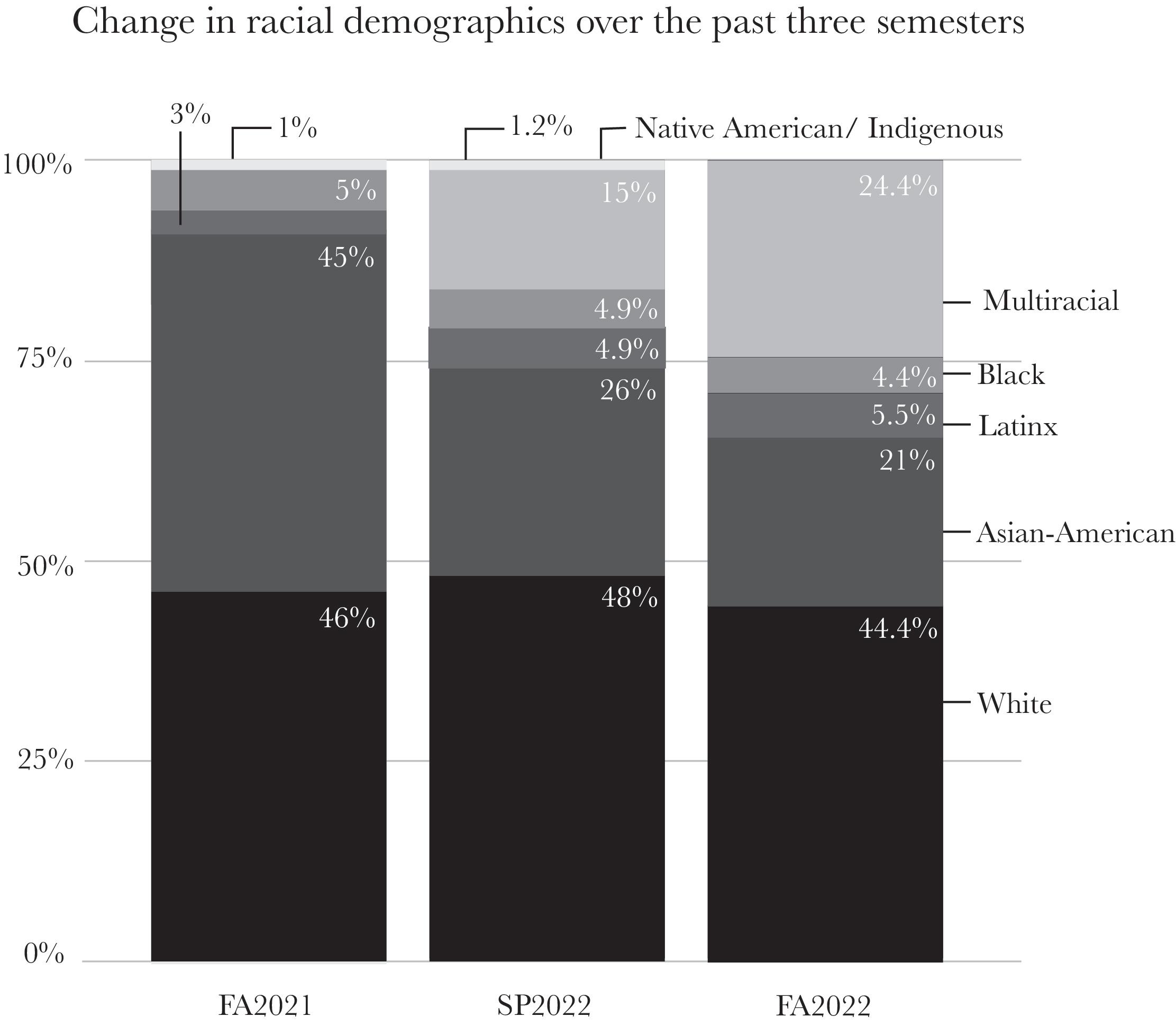
The ‘Claremont Cold’ calls for new sanitary habits
As the year comes to an end, many of us students are looking toward the holidays and going back home to spend time with loved ones. These last few weeks of the year are filled with the fi nal stretches of our first semester classes, turning in any missing as signments and growing anticipa tion of long breaks to be enjoyed. However, with the winter season also comes a wave of sicknesses and colds. Unofficially dubbed the “Claremont Cold,” one specific un known sickness has swept over the 5Cs, affecting students across all campuses.
Since returning from Thanks giving break, there’s been at least one student coughing in the corner or getting up at spontaneous times to get a tissue in all of my classes. Due to post-break COVID-19 test ing, we know that these students don’t have covid — but there’s still cause for those around them to worry that they might get sick from germ exposure. Regardless of the illness, it’s no fun being stuck in your dorm room recovering. We all much rather be spending our time being outdoors, hanging out with friends or enjoying pastimes
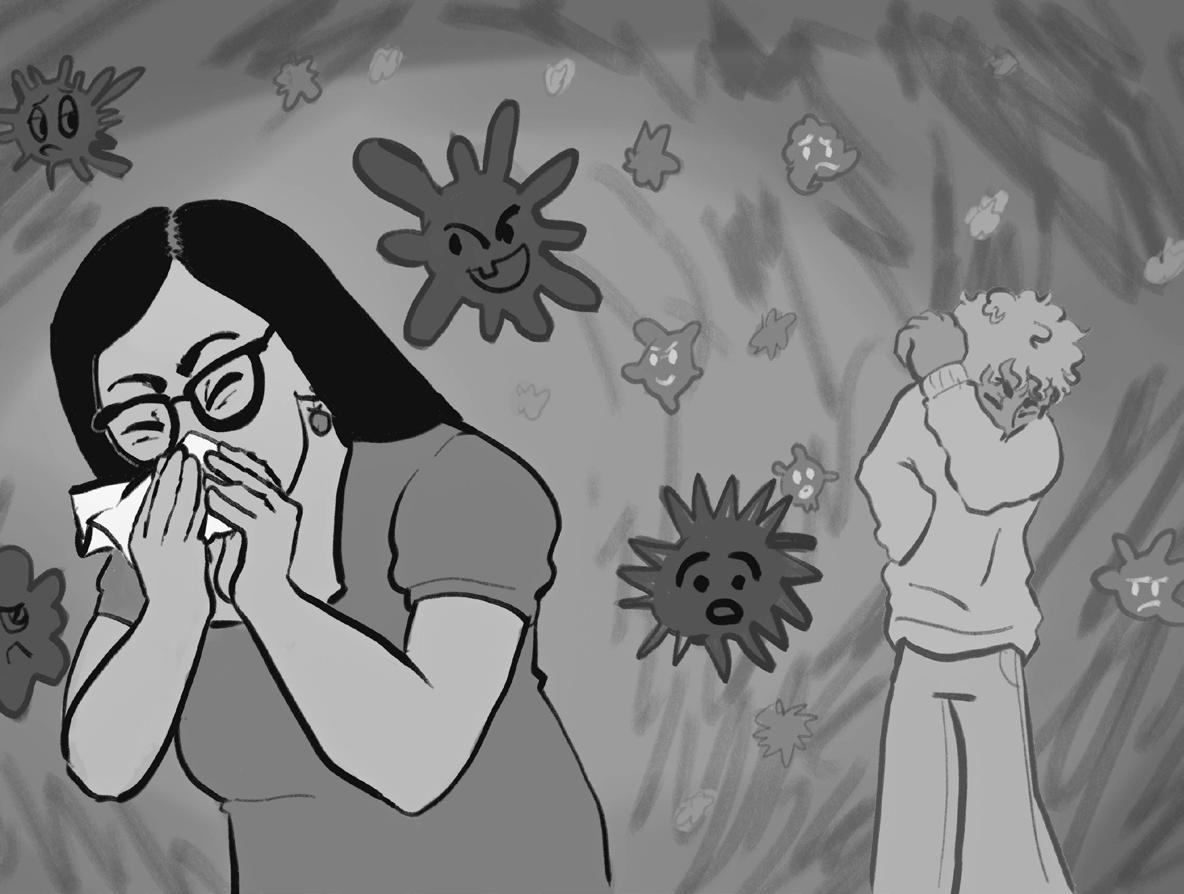
and hobbies. It’s a hassle having to get up and throw away your used tissue every few minutes and trying to resist the urge to sneeze while writing your as signments.
So, what can we as students do to prevent the spread of the “Claremont Cold?”
As a society that’s still grap pling with a global pandemic, we’ve learned how to adopt new sanitary habits and imple ment them almost immediately, just like how we did during the first few stages of the pandemic. To stop the “Claremont Cold” from wreaking its unjolly chaos, we should harness this skill and tighten up our sanitary practices.
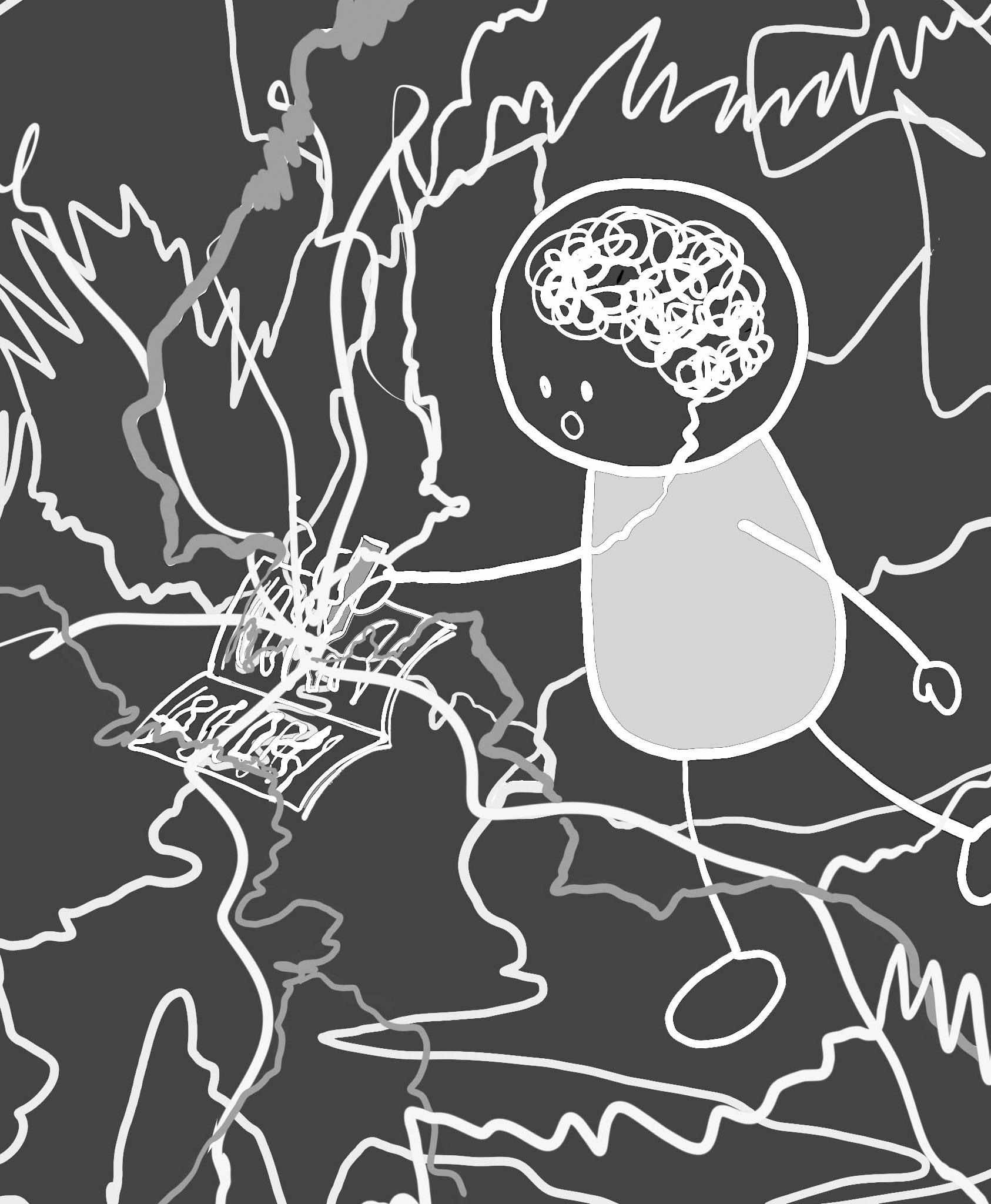
Aside from wearing masks when showing symptoms of any sickness, students need to be cau tious of how they are spreading their germs to others. For ex ample, students should still be encouraged to wash their hands frequently when entering and ex iting the dining halls, after using the restroom (this is a no brainer) and coming back to their dorm rooms. In addition, it’s good to develop the habit of cleaning up as you go: specifically at dining halls or using bathroom sinks, it’s
courteous to pick up your trash and wipe down the surfaces be fore leaving.
Throughout the 5Cs, many public spaces such as the Hon nold-Mudd Library and gym facilities as well as classrooms have disinfecting wipes and/or hand sanitizer for students to ac cess when utilizing the area: use them. Though often overlooked, it is important to clean and san itize shared resources among students. Doing so not only helps prevent you from getting in con tact with the “Claremont Cold” but also protects others when they use it after you.
As we gear up before the final weeks of fall semester, it is ex tremely important to look after yourself and your health. Finals are coming up, and I can assure you no one wants to take tests with a cold or fever. Moreover, many of us are traveling back home to see family, friends and to celebrate the holidays.
Start by washing your hands regularly. Whether that’s when coming back to your dorm after class or before entering the dining hall, get into a routine of keeping yourself clean. Then, begin get ting into a habit of wiping down
surfaces after usage — especially after your set at the gym or after finishing your meal. When one starts taking action, others will start to pick up your habits and adopt them as well.
As many parents would say: “It’s better to be safe than sorry.”
I don’t know about you, but I certainly do not want to take my exams or open holiday presents with a sore throat. As a commu
nity, let’s be mindful of others and begin adopting sanitary habits to keep ourselves healthy and pre vent the spread of the “Claremont Cold.” No, it’s not COVID-19 — but in these final few weeks, let’s treat it as if it were.
Carter Soe PZ ’26 is from San Ramon, California. He enjoys being outdoors, reading books and spending his money on overpriced coffee.
DECEMBER 2, 2022 PAGE 11 Opini O ns
ELLA LEHAVI • THE STUDENT LIFE
SEOHYEON LEE • THE STUDENT LIFE
CARTER SOE
inclusive storytelling workshop in collaboration with the Pulitzer Center where Los Angeles Times reporter Pendarvis Harshaw and photographer Brandon Tauszik led a conversation on their multi media project, “Facing Life.”
UNITY TAMBELLINI-SMITH • THE STUDENT LIFE
Pomona-Pitzer
Claremont: Consortium of champions
CMS and PP won a combined six conference titles across five sports
Men’s XC
The Sagehens followed up their 2021 National Championship with another impressive season. Sweeping the podium, they dominated the SCIAC Championship race, giving them the momentum to take home the title at the NCAA DIII West Regionals competition. The team went on to finish fifth at Nationals.


Lucas Florsheim PO ’24, who won Regionals and came in second at the SCIAC Championship, looked back on the season as a whole
“We were completely transparent about want ing to win the national championship for the third straight time,” Florsheim said. “It didn’t really come together at Nationals for whatever reason … So I think the guys were pretty disappointed. But I’d say that when we were talking about it, none of us were crushed by losing, which I think shows that we’re in it not just to win the championship … I think it was a good reminder that you’re capa ble of what you’re capable of, and that’s some thing to be proud of.”
Football
Without a doubt, the most compelling narrative of the SCIAC’s fall season was the historic Cinder ella story of Pomona-Pitzer football. Originally ranked fifth, the Sagehens shocked the conference through thrilling comeback victories and a few beatdowns on the back of both elite offense and defense. Ultimately, the underdogs toppled CMS to win their first ever Championship and Nation als berth in joint program history.
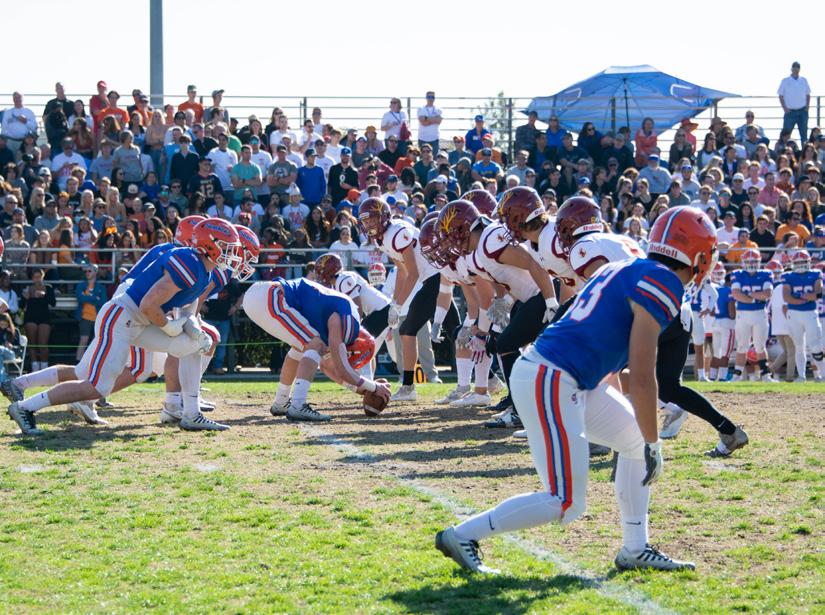
Although the team fell to an undefeated Linfield, Adam Camargo PZ ’23, who took home All-SCIAC honors, spoke on what this season meant for the legacy of the Sagehens.
“This was years in the making. The guys who preceded us were the ones who changed this team. In less than seven years — from a team who’d go 0-9, 0-10 to a SCIAC championship team making the playoffs. So a lot of credit to those older guys who changed the culture and a lot of credit to our team for finishing it out and finally getting that SCIAC championship.”
Women’s Soccer
In the teams’ first-ever tournament match-up, the top-seeded Sagehens won their third straight SCIAC tournament championship Nov. 5, beat ing No. 3 rival Athenas 3-0. This win earned P-P an automatic bid into the NCAA tournament, of which they were semifinalists in 2019, but they ultimately fell to the Trinity (TX) Tigers Nov. 12 in these teams’ second straight first round matchup.
Charlotte Tapp PO ’23 said that despite the ups and downs throughout the season, the team was happy when their hard work paid off in the end.
“We went into the game saying, ‘Don’t panic — just play a really strong game,’” Tapp said. “When the final whistle blew, it was just this re ally great feeling that all of our hard work really paid off in the season, and we were able to show that in the final game with a pretty big win, so we were super happy.”
Women’s Volleyball
In the teams’ first-ever tournament match-up, the top-seeded Sagehens won their third straight SCIAC tournament championship Nov. 5, beating No. 3 rival Athenas 3-0. This win earned P-P an automatic bid into the NCAA tournament, of which they were semifinalists in 2019, but they ultimately fell to the Trinity (TX) Tigers Nov. 12 in these teams’ second straight first round matchup.
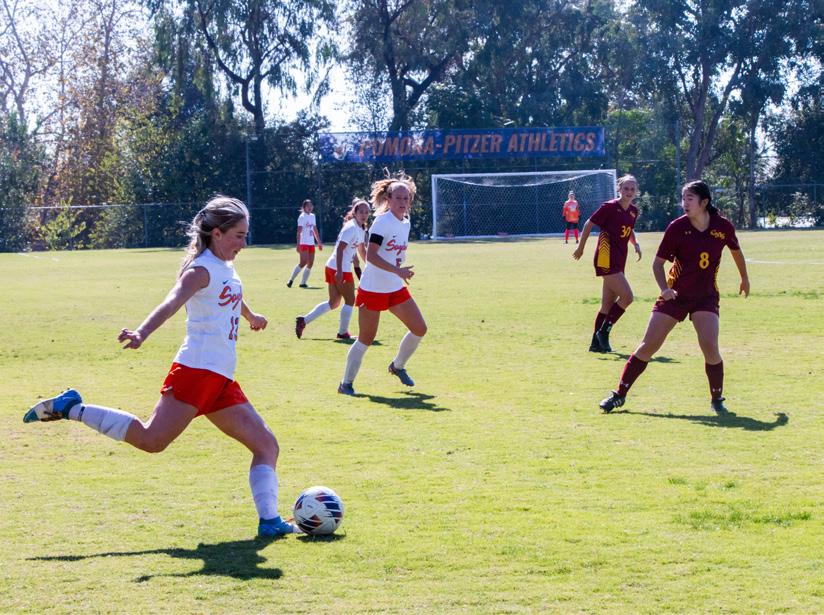
Charlotte Tapp PO ’23 said that despite the ups and downs throughout the season, the team was happy when their hard work paid off in the end.
“We went into the game saying, ‘Don’t panic — just play a really strong game,’” Tapp said. “When the final whistle blew, it was just this re ally great feeling that all of our hard work really paid off in the season, and we were able to show that in the final game with a pretty big win, so we were super happy.”
Football
While the Stags fell to the Sagehens in the Sixth Street rivalry game, knocking them out of Nationals contention, their record gave CMS co-ownership of the SCIAC title. Shutting out several teams on their way to 40-point wins, CMS football was a force to be reckoned with.
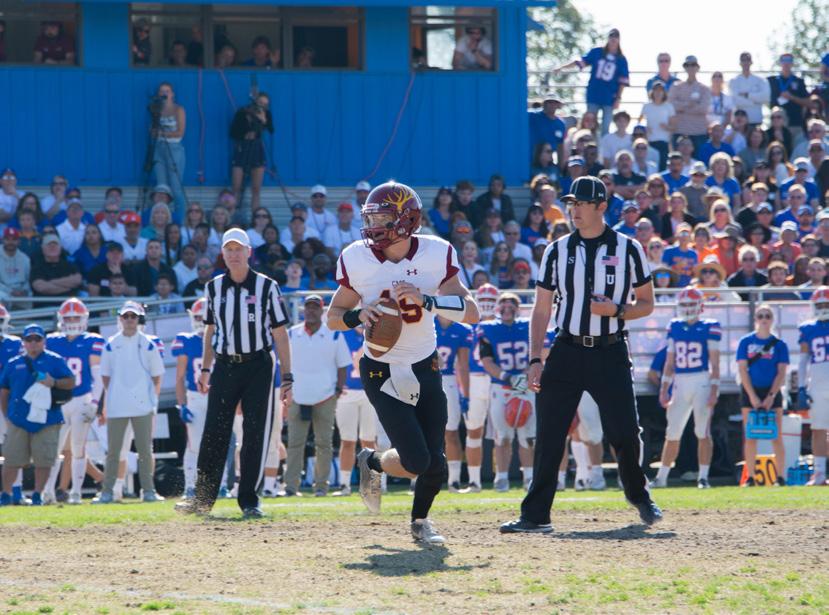
Players like All-SCIAC defensive back, Michael Colangelo CM ’23, led the conference’s top-rated defense. Colangelo reflected on how the Stags reached their goals.
“At the end of the day, it still is a conference title, and we shouldn’t hang our heads,” Colange lo said. “That was the big message at the end of the year: we came here to win a conference title. We got that, we got the ring. We’re all very proud of what the team did this year.”
CMS women’s cross country earned its 12th consecutive SCIAC championship and their 31st total on Oct. 29. Despite their continued success, winning the title was no easy feat to accomplish. The runners-up in the race, the rival Sagehens trailed the Athenas by just 12 points. However, CMS was confident going into the race, after UST FCCCA ranked them fourth in the nation and they finished first at the Pomona-Pitzer Invite on Oct. 8.
Following their SCIAC win, the Athenas continued to dominate, ultimately placing 10th at the NCAA championship Nov. 19.
Anika Kimme CM ’23 said that despite the team’s continual success, CMS works hard to stay humble.
“Our goal every year is to defend the title. Po mona-Pitzer always gives us a great run, but I think that we were confident that it was very possible to defend the title,” Kimme said. “It was our 12th year in a row, but we never want to go in assuming that we’ll win or taking it for granted.”
Claremont-Mudd-Scripps
Reactivated weightlifting club ‘lifts’ up members with comprehensive workout plans, judgment-free community
Walking into a gym can be in timidating. All the machines and weights can be overwhelming at first, and the crowded environ ment can be deterring. The Clare mont Barbell Club aims to take that weight off newcomers’ shoulders.
Open to anyone interested in lifting weights, this 5C club values weightlifting as a group activity where each member feels equally supported, according to Kristen LeBlanc CM ’23, a leader of the club. The mission of the club is to provide a safe place to practice weightlifting without pressure or judgment.
“We’ve created a very nice, sup portive environment where club members give each other tips on form, we spot each other and we cheer each other on for heavy sets,” LeBlanc said. “It doesn’t matter how much or how little weight you’re doing — if you’re pushing yourself, there will be plenty of people cheer ing you on.”
The Claremont Barbell Club works out together in Roberts Pavil ion, with leaders providing custom lifting regimens based on members’ current skill levels.
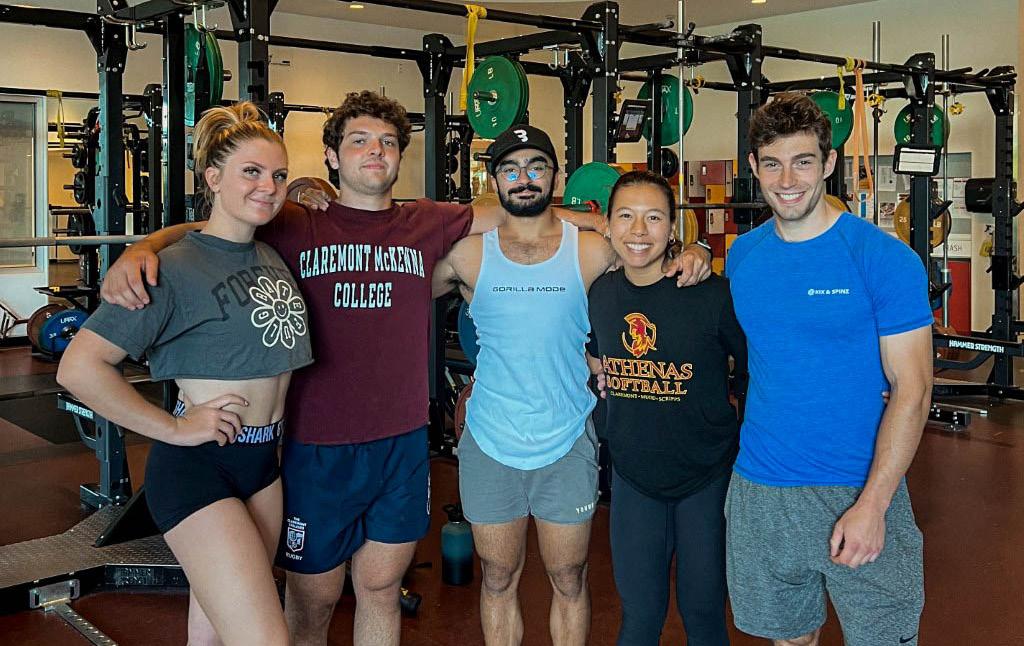
“We start warming up with some mobility work, then we begin our main lift or compound movement of the day, which for powerlifters is squat, bench or deadlift,” LeB lanc said. “Once we’ve finished our main lift, we move onto accessories, which are any exercises other than squat, bench or deadlift. People typ ically do one compound lift, then 3-5 accessory exercises.”
The workouts for each skill level consist of a balance of exercises for muscle groups all over the body, so each member strengthens all mus cles equally, according to club mem ber Greg Larrabee CM ’23.
“Usually, each day employs a limited set of exercises to focus on either a single lift, such as squat, bench or deadlift, or a muscle group, like legs, chest or back,” Larrabee said.
LeBlanc emphasized that spac ing out the days that a person lifts weights is important for avoiding injuries.
“Our club only meets once a week, but all the members lift on their own outside of the meeting time,” Larabee said. “The frequen cy varies between members, with most falling in the 3-5 days a week range. Many members of the club are on sports teams, so the prac tice and team lift schedules of the sport will have an impact on how often they can lift.”
It’s easy to get caught up in the rush of reaching a personal record each time, according to Larrabee. He said while it is important to push yourself, it is also important to view weightlifting as a gradual process.
“Lifting progress is made very slowly over the course of weeks, months and even years, especially for more experienced lifters,” Lar abee said. “Because of this slow pace, most goals are made in that time frame, rather than per ses sion.”
Larrabee emphasized that peo ple don’t lift just to achieve per sonal records — there is a wide variety of what people look to gain.
“Someone coming back from an injury might want to simply regain full mobility and stability again, or someone trying to lose weight could strive to maintain their strength as they lose weight,” Larabee said.
Jacey Carter CM ’23 said start ing to lift weights can be daunting for those who haven’t before. She
said the club tries to make the transition less intimidating with pre-written programs that club leaders put together.
“Regarding our beginner ath letes, we pay extra attention to detail when it comes to their lifts to make sure they have proper form and technique,” Carter said. “We provide all members of the club a beginner and intermediate weightlifting program to follow. If someone is new, we encourage them to use the program designed, and they are more than welcome to come to a team lift and ask for help on form or technique!”
LeBlanc feels passionate about integrating beginners because she can relate to the beginners’ expe
rience in college. The benefits she gained from learning how to lift with the softball team her first year is what motivated her to re boot the Claremont Barbell Club.

While it had been an estab lished club for a while, those that led the club graduated in 2020. Be cause of the effects of COVID, the club was at standstill until LeBlanc and Carter reactivated it this year.
“I am very grateful that I learned how to lift in a fe male-dominated, uplifting en vironment,” LeBlanc said. “It has done wonders for my phys ical and mental health, and I feel stronger and more confident in my daily life. A huge motivator to start the Barbell Club back up was
to create an environment where be ginners feel comfortable learning how to lift.”
Carter highlighted that main taining a positive culture is critical in weightlifting because it can be an unaccepting, competitive envi ronment. The club leaders reinforce positivity through consistent en couragement and finding time to spend together outside the gym.
“Whether someone is squatting for the first time or if they are going for a huge lift, we support and cheer each other through everything,” Carter said. “After our team lifts, we try to encourage everyone to join us at Collins for dinner. Spending time outside the gym together forms a stronger bond beyond the gym.”
PAGE 12 DEcEmbEr 2, 2022 SPORTS
cOUrTESY: KrISTIN LEbLANc
TESS MCHUGH
The claremont barbell club leadership team looks to create a space to work out free of judgment. Left to right: Jacey carter, Nick Smole, Umer Lakhani, Kristin Leblanc, Greg Larrabee.
JONATHAN KE • THE STUDENT LIFE
Women’s XC
cOUrTESY: cmS ATHLETIcS
JONATHAN KE • THE STUDENT LIFE
cOUrTESY: POmONA-PITZEr ATHLETIcS
JONATHAN KE • THE STUDENT LIFE
WENDY ZHANG • THE STUDENT LIFE
 SIENA SWIFT & SARA CAWLEY
SIENA SWIFT & SARA CAWLEY















 TOMI OYEDEJI-OLANIYAN
TOMI OYEDEJI-OLANIYAN













 LUcIA mArQUeZ-UPPmAN • THe STUDeNT LIFe
LUcIA mArQUeZ-UPPmAN • THe STUDeNT LIFe

























